TAEASS403 Participate in Assessment Validation: AT3
VerifiedAdded on 2023/06/05
|39
|13431
|262
AI Summary
Participate in assessment validation of a newly-written assessment tool for BSBTWK201 Work effectively with others. Complete activities in a structured classroom environment and as a self-directed task. Due date is 29/8/22.
Contribute Materials
Your contribution can guide someone’s learning journey. Share your
documents today.
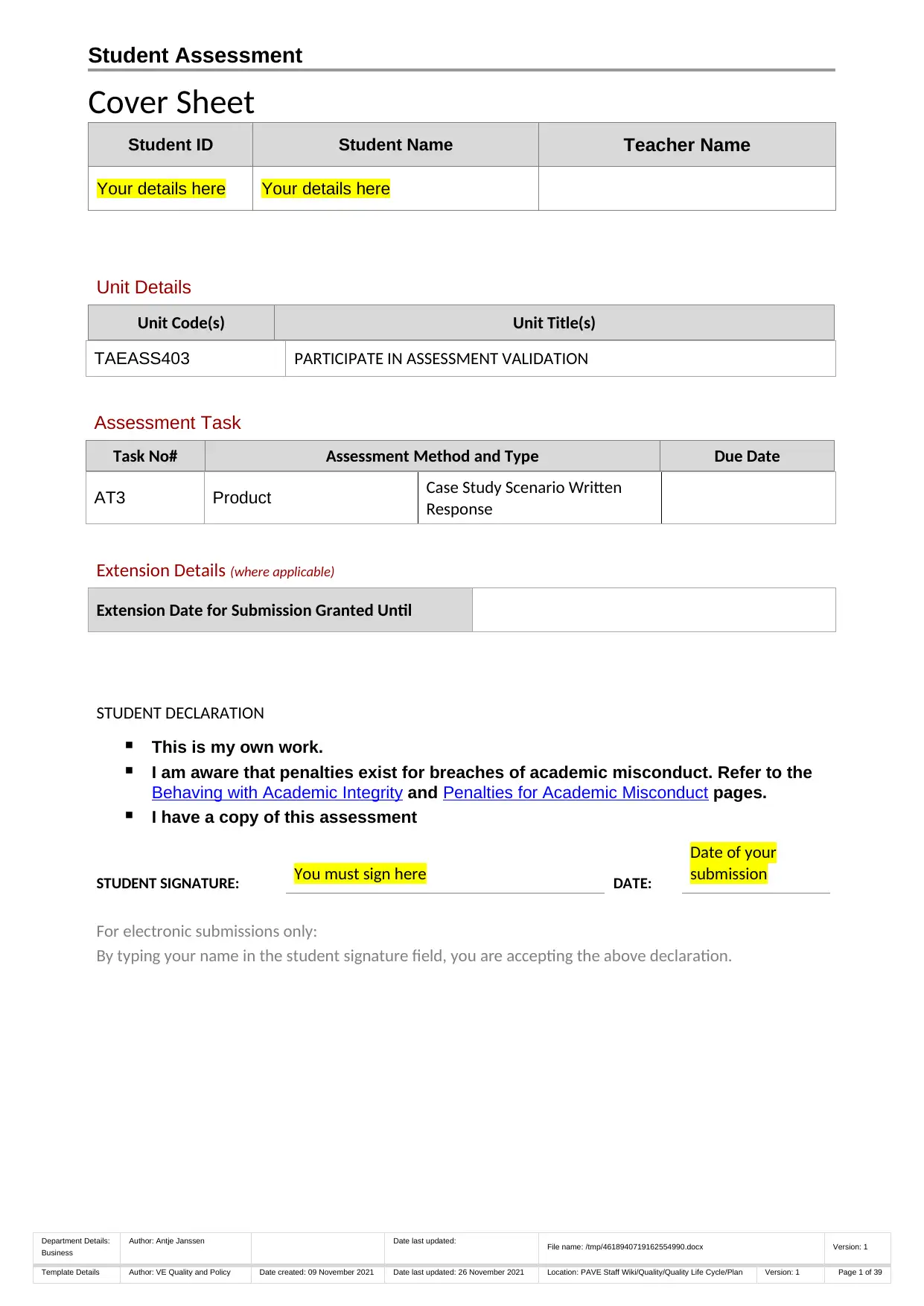
Student Assessment
Cover Sheet
Student ID Student Name Teacher Name
Your details here Your details here
Unit Details
Unit Code(s) Unit Title(s)
TAEASS403 PARTICIPATE IN ASSESSMENT VALIDATION
Assessment Task
Task No# Assessment Method and Type Due Date
AT3 Product Case Study Scenario Written
Response
Extension Details (where applicable)
Extension Date for Submission Granted Until
STUDENT DECLARATION
This is my own work.
I am aware that penalties exist for breaches of academic misconduct. Refer to the
Behaving with Academic Integrity and Penalties for Academic Misconduct pages.
I have a copy of this assessment
STUDENT SIGNATURE: You must sign here DATE:
Date of your
submission
For electronic submissions only:
By typing your name in the student signature field, you are accepting the above declaration.
Department Details:
Business
Author: Antje Janssen Date last updated: File name: /tmp/4618940719162554990.docx Version: 1
Template Details Author: VE Quality and Policy Date created: 09 November 2021 Date last updated: 26 November 2021 Location: PAVE Staff Wiki/Quality/Quality Life Cycle/Plan Version: 1 Page 1 of 39
Cover Sheet
Student ID Student Name Teacher Name
Your details here Your details here
Unit Details
Unit Code(s) Unit Title(s)
TAEASS403 PARTICIPATE IN ASSESSMENT VALIDATION
Assessment Task
Task No# Assessment Method and Type Due Date
AT3 Product Case Study Scenario Written
Response
Extension Details (where applicable)
Extension Date for Submission Granted Until
STUDENT DECLARATION
This is my own work.
I am aware that penalties exist for breaches of academic misconduct. Refer to the
Behaving with Academic Integrity and Penalties for Academic Misconduct pages.
I have a copy of this assessment
STUDENT SIGNATURE: You must sign here DATE:
Date of your
submission
For electronic submissions only:
By typing your name in the student signature field, you are accepting the above declaration.
Department Details:
Business
Author: Antje Janssen Date last updated: File name: /tmp/4618940719162554990.docx Version: 1
Template Details Author: VE Quality and Policy Date created: 09 November 2021 Date last updated: 26 November 2021 Location: PAVE Staff Wiki/Quality/Quality Life Cycle/Plan Version: 1 Page 1 of 39
Secure Best Marks with AI Grader
Need help grading? Try our AI Grader for instant feedback on your assignments.
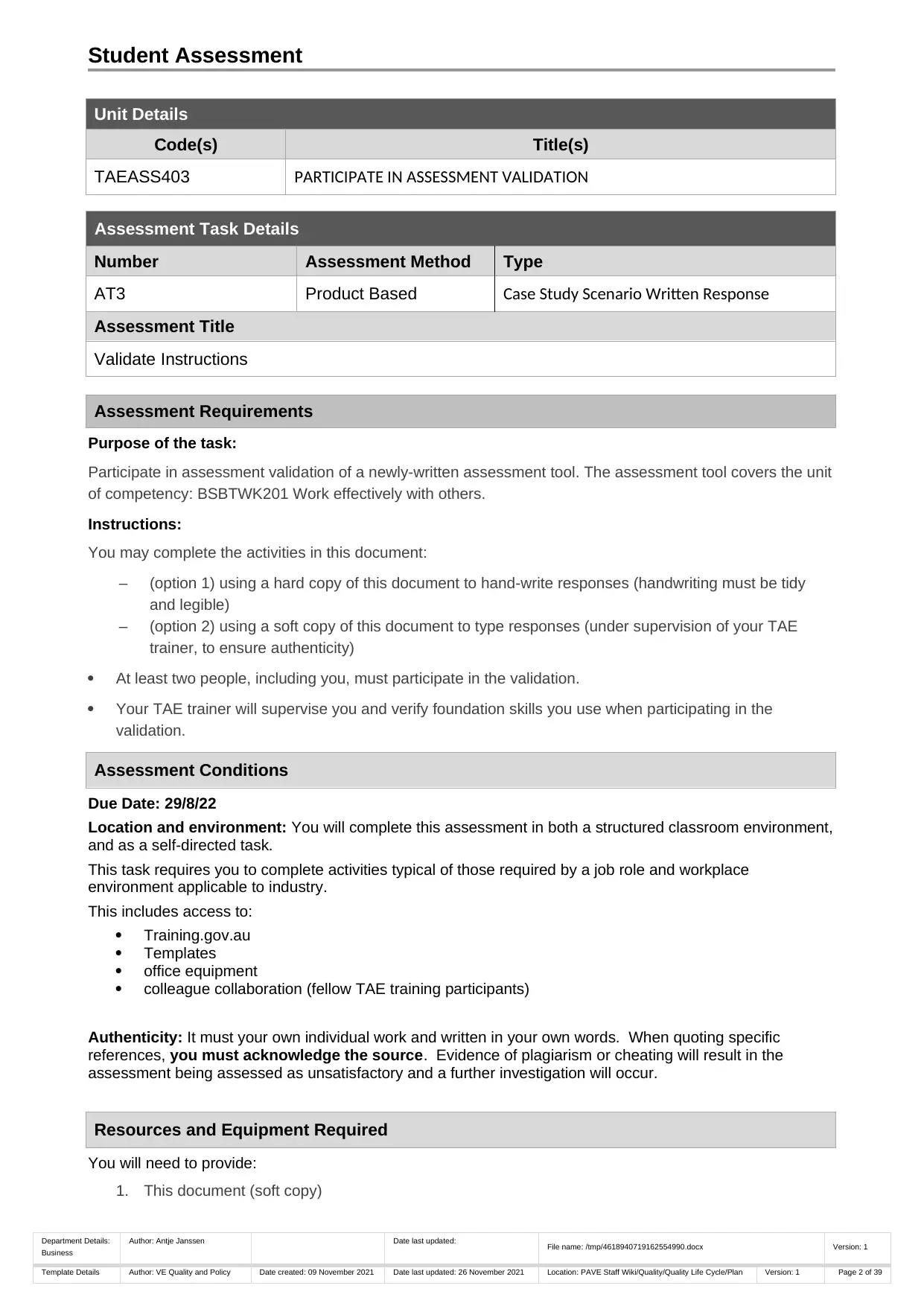
Student Assessment
Unit Details
Code(s) Title(s)
TAEASS403 PARTICIPATE IN ASSESSMENT VALIDATION
Assessment Task Details
Number Assessment Method Type
AT3 Product Based Case Study Scenario Written Response
Assessment Title
Validate Instructions
Assessment Requirements
Purpose of the task:
Participate in assessment validation of a newly-written assessment tool. The assessment tool covers the unit
of competency: BSBTWK201 Work effectively with others.
Instructions:
You may complete the activities in this document:
– (option 1) using a hard copy of this document to hand-write responses (handwriting must be tidy
and legible)
– (option 2) using a soft copy of this document to type responses (under supervision of your TAE
trainer, to ensure authenticity)
At least two people, including you, must participate in the validation.
Your TAE trainer will supervise you and verify foundation skills you use when participating in the
validation.
Assessment Conditions
Due Date: 29/8/22
Location and environment: You will complete this assessment in both a structured classroom environment,
and as a self-directed task.
This task requires you to complete activities typical of those required by a job role and workplace
environment applicable to industry.
This includes access to:
Training.gov.au
Templates
office equipment
colleague collaboration (fellow TAE training participants)
Authenticity: It must your own individual work and written in your own words. When quoting specific
references, you must acknowledge the source. Evidence of plagiarism or cheating will result in the
assessment being assessed as unsatisfactory and a further investigation will occur.
Resources and Equipment Required
You will need to provide:
1. This document (soft copy)
Department Details:
Business
Author: Antje Janssen Date last updated: File name: /tmp/4618940719162554990.docx Version: 1
Template Details Author: VE Quality and Policy Date created: 09 November 2021 Date last updated: 26 November 2021 Location: PAVE Staff Wiki/Quality/Quality Life Cycle/Plan Version: 1 Page 2 of 39
Unit Details
Code(s) Title(s)
TAEASS403 PARTICIPATE IN ASSESSMENT VALIDATION
Assessment Task Details
Number Assessment Method Type
AT3 Product Based Case Study Scenario Written Response
Assessment Title
Validate Instructions
Assessment Requirements
Purpose of the task:
Participate in assessment validation of a newly-written assessment tool. The assessment tool covers the unit
of competency: BSBTWK201 Work effectively with others.
Instructions:
You may complete the activities in this document:
– (option 1) using a hard copy of this document to hand-write responses (handwriting must be tidy
and legible)
– (option 2) using a soft copy of this document to type responses (under supervision of your TAE
trainer, to ensure authenticity)
At least two people, including you, must participate in the validation.
Your TAE trainer will supervise you and verify foundation skills you use when participating in the
validation.
Assessment Conditions
Due Date: 29/8/22
Location and environment: You will complete this assessment in both a structured classroom environment,
and as a self-directed task.
This task requires you to complete activities typical of those required by a job role and workplace
environment applicable to industry.
This includes access to:
Training.gov.au
Templates
office equipment
colleague collaboration (fellow TAE training participants)
Authenticity: It must your own individual work and written in your own words. When quoting specific
references, you must acknowledge the source. Evidence of plagiarism or cheating will result in the
assessment being assessed as unsatisfactory and a further investigation will occur.
Resources and Equipment Required
You will need to provide:
1. This document (soft copy)
Department Details:
Business
Author: Antje Janssen Date last updated: File name: /tmp/4618940719162554990.docx Version: 1
Template Details Author: VE Quality and Policy Date created: 09 November 2021 Date last updated: 26 November 2021 Location: PAVE Staff Wiki/Quality/Quality Life Cycle/Plan Version: 1 Page 2 of 39
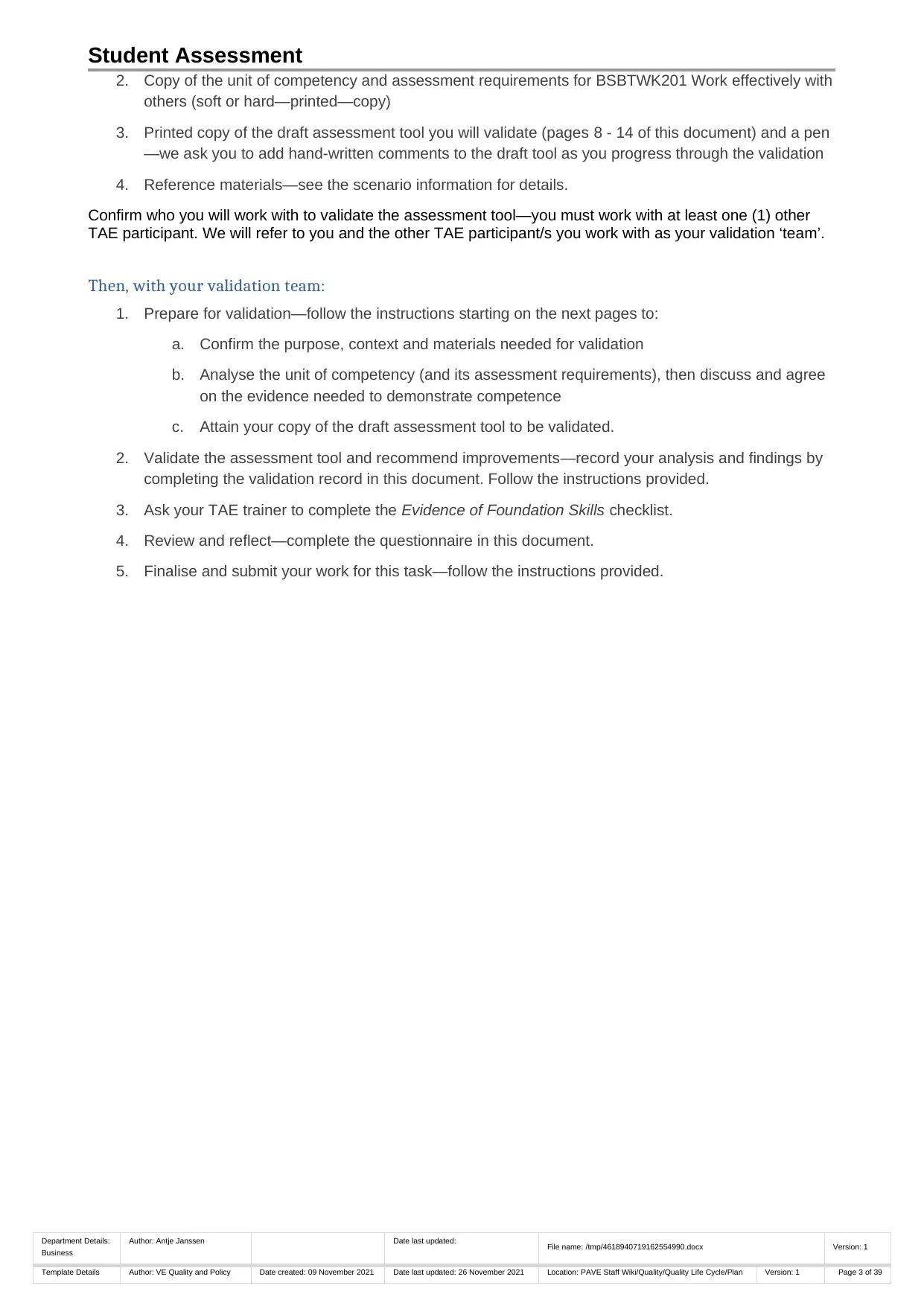
Student Assessment
2. Copy of the unit of competency and assessment requirements for BSBTWK201 Work effectively with
others (soft or hard—printed—copy)
3. Printed copy of the draft assessment tool you will validate (pages 8 - 14 of this document) and a pen
—we ask you to add hand-written comments to the draft tool as you progress through the validation
4. Reference materials—see the scenario information for details.
Confirm who you will work with to validate the assessment tool—you must work with at least one (1) other
TAE participant. We will refer to you and the other TAE participant/s you work with as your validation ‘team’.
Then, with your validation team:
1. Prepare for validation—follow the instructions starting on the next pages to:
a. Confirm the purpose, context and materials needed for validation
b. Analyse the unit of competency (and its assessment requirements), then discuss and agree
on the evidence needed to demonstrate competence
c. Attain your copy of the draft assessment tool to be validated.
2. Validate the assessment tool and recommend improvements—record your analysis and findings by
completing the validation record in this document. Follow the instructions provided.
3. Ask your TAE trainer to complete the Evidence of Foundation Skills checklist.
4. Review and reflect—complete the questionnaire in this document.
5. Finalise and submit your work for this task—follow the instructions provided.
Department Details:
Business
Author: Antje Janssen Date last updated: File name: /tmp/4618940719162554990.docx Version: 1
Template Details Author: VE Quality and Policy Date created: 09 November 2021 Date last updated: 26 November 2021 Location: PAVE Staff Wiki/Quality/Quality Life Cycle/Plan Version: 1 Page 3 of 39
2. Copy of the unit of competency and assessment requirements for BSBTWK201 Work effectively with
others (soft or hard—printed—copy)
3. Printed copy of the draft assessment tool you will validate (pages 8 - 14 of this document) and a pen
—we ask you to add hand-written comments to the draft tool as you progress through the validation
4. Reference materials—see the scenario information for details.
Confirm who you will work with to validate the assessment tool—you must work with at least one (1) other
TAE participant. We will refer to you and the other TAE participant/s you work with as your validation ‘team’.
Then, with your validation team:
1. Prepare for validation—follow the instructions starting on the next pages to:
a. Confirm the purpose, context and materials needed for validation
b. Analyse the unit of competency (and its assessment requirements), then discuss and agree
on the evidence needed to demonstrate competence
c. Attain your copy of the draft assessment tool to be validated.
2. Validate the assessment tool and recommend improvements—record your analysis and findings by
completing the validation record in this document. Follow the instructions provided.
3. Ask your TAE trainer to complete the Evidence of Foundation Skills checklist.
4. Review and reflect—complete the questionnaire in this document.
5. Finalise and submit your work for this task—follow the instructions provided.
Department Details:
Business
Author: Antje Janssen Date last updated: File name: /tmp/4618940719162554990.docx Version: 1
Template Details Author: VE Quality and Policy Date created: 09 November 2021 Date last updated: 26 November 2021 Location: PAVE Staff Wiki/Quality/Quality Life Cycle/Plan Version: 1 Page 3 of 39
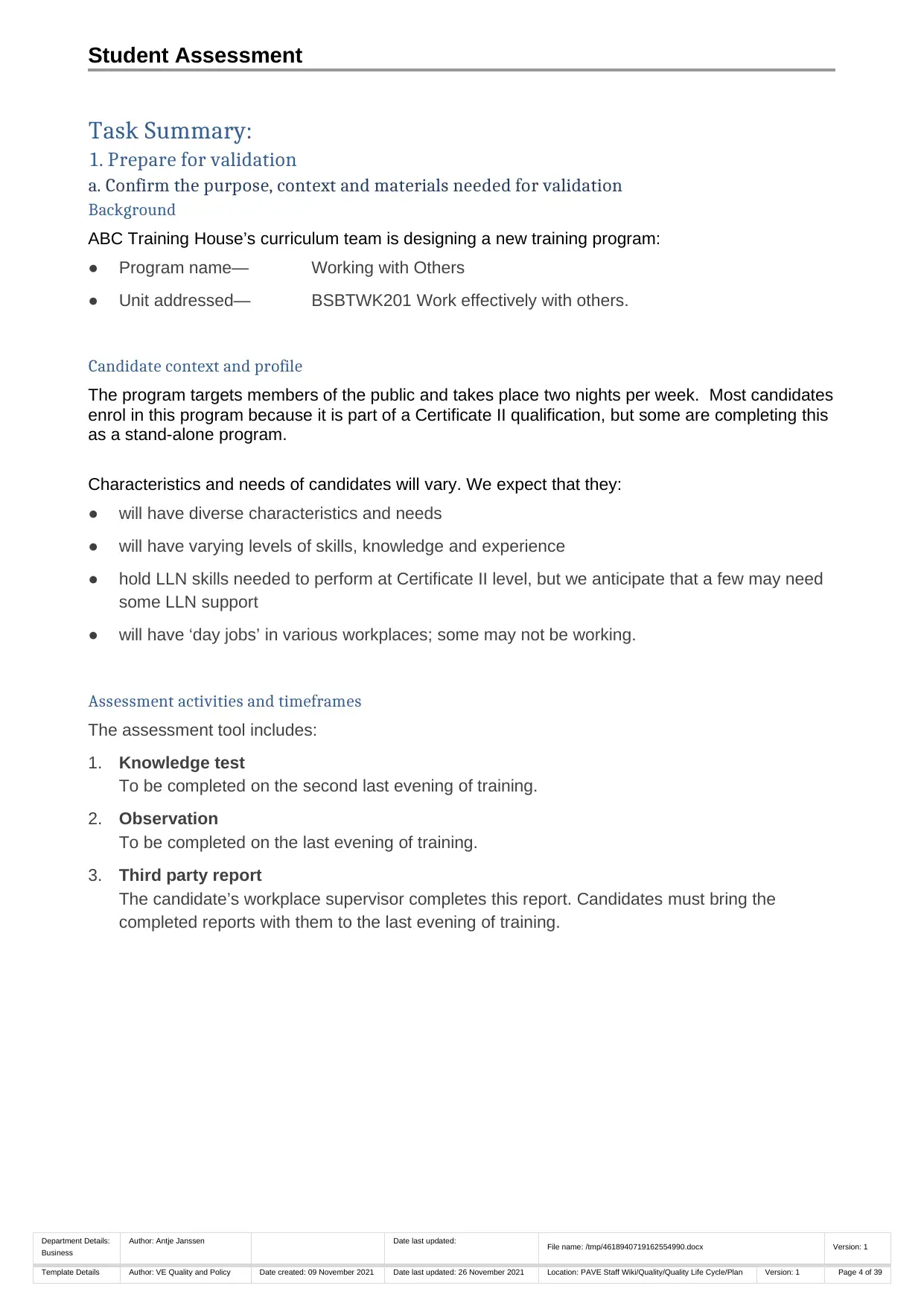
Student Assessment
Task Summary:
1. Prepare for validation
a. Confirm the purpose, context and materials needed for validation
Background
ABC Training House’s curriculum team is designing a new training program:
● Program name— Working with Others
● Unit addressed— BSBTWK201 Work effectively with others.
Candidate context and profile
The program targets members of the public and takes place two nights per week. Most candidates
enrol in this program because it is part of a Certificate II qualification, but some are completing this
as a stand-alone program.
Characteristics and needs of candidates will vary. We expect that they:
● will have diverse characteristics and needs
● will have varying levels of skills, knowledge and experience
● hold LLN skills needed to perform at Certificate II level, but we anticipate that a few may need
some LLN support
● will have ‘day jobs’ in various workplaces; some may not be working.
Assessment activities and timeframes
The assessment tool includes:
1. Knowledge test
To be completed on the second last evening of training.
2. Observation
To be completed on the last evening of training.
3. Third party report
The candidate’s workplace supervisor completes this report. Candidates must bring the
completed reports with them to the last evening of training.
Department Details:
Business
Author: Antje Janssen Date last updated: File name: /tmp/4618940719162554990.docx Version: 1
Template Details Author: VE Quality and Policy Date created: 09 November 2021 Date last updated: 26 November 2021 Location: PAVE Staff Wiki/Quality/Quality Life Cycle/Plan Version: 1 Page 4 of 39
Task Summary:
1. Prepare for validation
a. Confirm the purpose, context and materials needed for validation
Background
ABC Training House’s curriculum team is designing a new training program:
● Program name— Working with Others
● Unit addressed— BSBTWK201 Work effectively with others.
Candidate context and profile
The program targets members of the public and takes place two nights per week. Most candidates
enrol in this program because it is part of a Certificate II qualification, but some are completing this
as a stand-alone program.
Characteristics and needs of candidates will vary. We expect that they:
● will have diverse characteristics and needs
● will have varying levels of skills, knowledge and experience
● hold LLN skills needed to perform at Certificate II level, but we anticipate that a few may need
some LLN support
● will have ‘day jobs’ in various workplaces; some may not be working.
Assessment activities and timeframes
The assessment tool includes:
1. Knowledge test
To be completed on the second last evening of training.
2. Observation
To be completed on the last evening of training.
3. Third party report
The candidate’s workplace supervisor completes this report. Candidates must bring the
completed reports with them to the last evening of training.
Department Details:
Business
Author: Antje Janssen Date last updated: File name: /tmp/4618940719162554990.docx Version: 1
Template Details Author: VE Quality and Policy Date created: 09 November 2021 Date last updated: 26 November 2021 Location: PAVE Staff Wiki/Quality/Quality Life Cycle/Plan Version: 1 Page 4 of 39
Secure Best Marks with AI Grader
Need help grading? Try our AI Grader for instant feedback on your assignments.
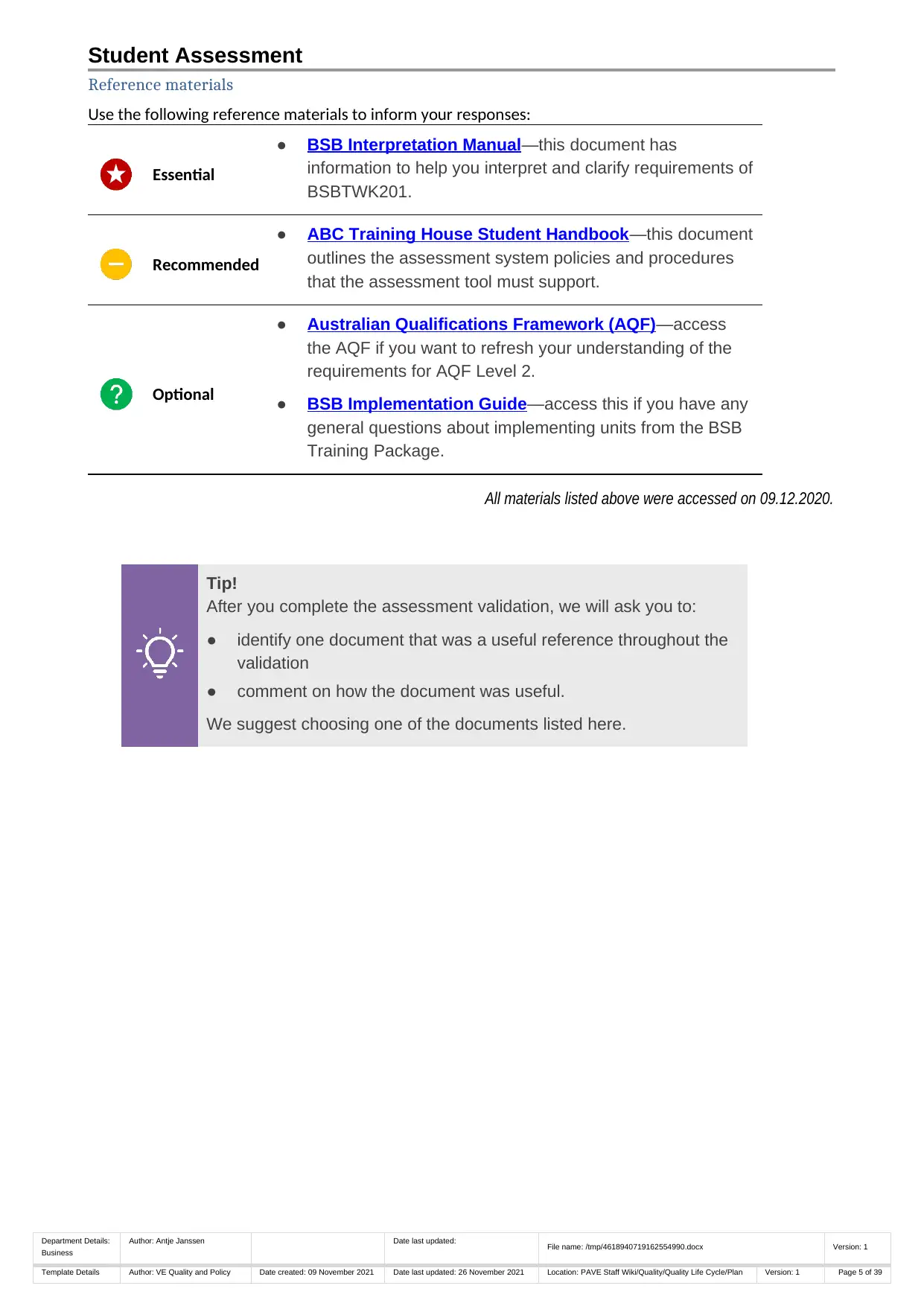
Student Assessment
Reference materials
Use the following reference materials to inform your responses:
Essential
● BSB Interpretation Manual—this document has
information to help you interpret and clarify requirements of
BSBTWK201.
Recommended
● ABC Training House Student Handbook—this document
outlines the assessment system policies and procedures
that the assessment tool must support.
Optional
● Australian Qualifications Framework (AQF)—access
the AQF if you want to refresh your understanding of the
requirements for AQF Level 2.
● BSB Implementation Guide—access this if you have any
general questions about implementing units from the BSB
Training Package.
All materials listed above were accessed on 09.12.2020.
Tip!
After you complete the assessment validation, we will ask you to:
● identify one document that was a useful reference throughout the
validation
● comment on how the document was useful.
We suggest choosing one of the documents listed here.
Department Details:
Business
Author: Antje Janssen Date last updated: File name: /tmp/4618940719162554990.docx Version: 1
Template Details Author: VE Quality and Policy Date created: 09 November 2021 Date last updated: 26 November 2021 Location: PAVE Staff Wiki/Quality/Quality Life Cycle/Plan Version: 1 Page 5 of 39
Reference materials
Use the following reference materials to inform your responses:
Essential
● BSB Interpretation Manual—this document has
information to help you interpret and clarify requirements of
BSBTWK201.
Recommended
● ABC Training House Student Handbook—this document
outlines the assessment system policies and procedures
that the assessment tool must support.
Optional
● Australian Qualifications Framework (AQF)—access
the AQF if you want to refresh your understanding of the
requirements for AQF Level 2.
● BSB Implementation Guide—access this if you have any
general questions about implementing units from the BSB
Training Package.
All materials listed above were accessed on 09.12.2020.
Tip!
After you complete the assessment validation, we will ask you to:
● identify one document that was a useful reference throughout the
validation
● comment on how the document was useful.
We suggest choosing one of the documents listed here.
Department Details:
Business
Author: Antje Janssen Date last updated: File name: /tmp/4618940719162554990.docx Version: 1
Template Details Author: VE Quality and Policy Date created: 09 November 2021 Date last updated: 26 November 2021 Location: PAVE Staff Wiki/Quality/Quality Life Cycle/Plan Version: 1 Page 5 of 39
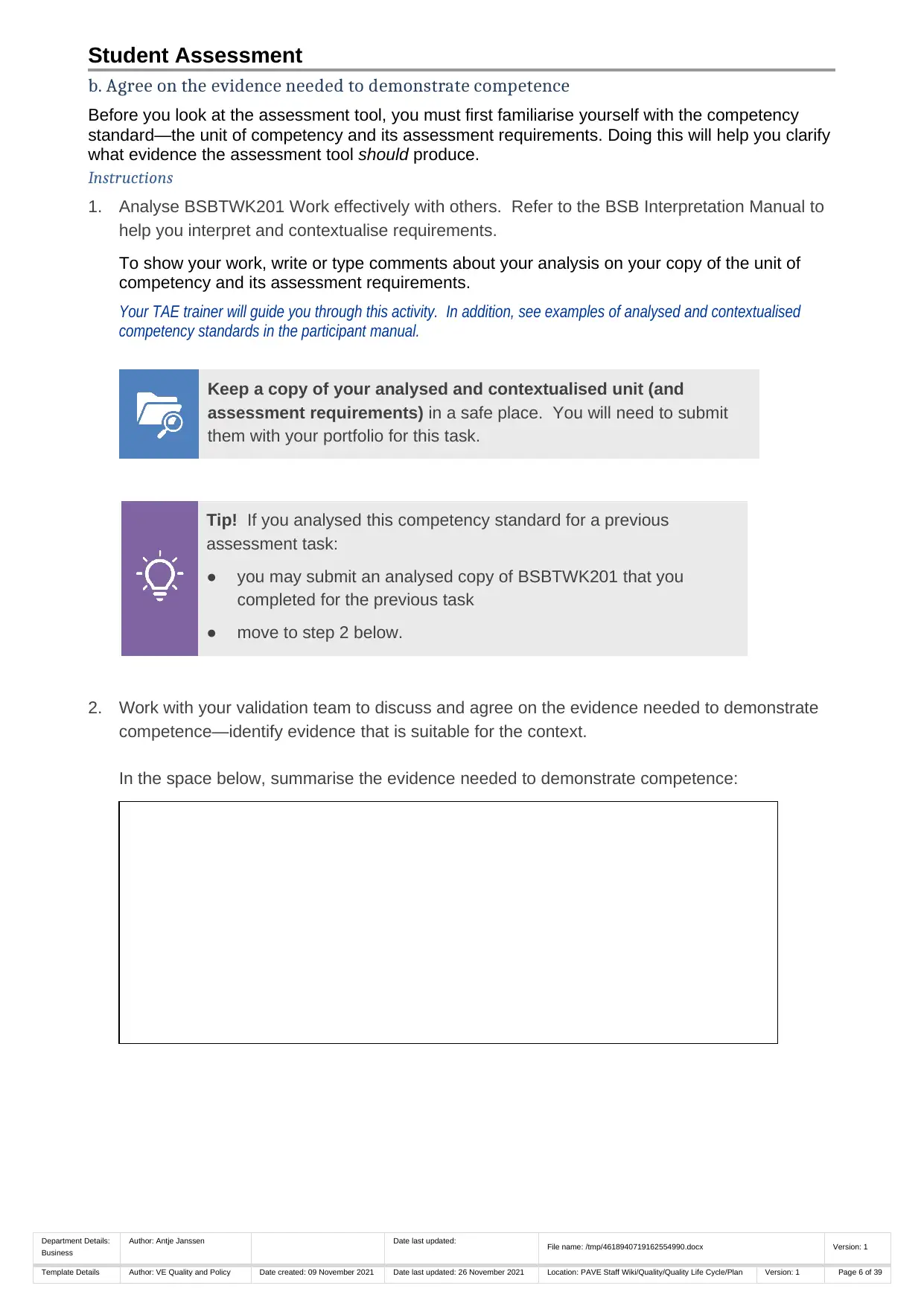
Student Assessment
b. Agree on the evidence needed to demonstrate competence
Before you look at the assessment tool, you must first familiarise yourself with the competency
standard—the unit of competency and its assessment requirements. Doing this will help you clarify
what evidence the assessment tool should produce.
Instructions
1. Analyse BSBTWK201 Work effectively with others. Refer to the BSB Interpretation Manual to
help you interpret and contextualise requirements.
To show your work, write or type comments about your analysis on your copy of the unit of
competency and its assessment requirements.
Your TAE trainer will guide you through this activity. In addition, see examples of analysed and contextualised
competency standards in the participant manual.
Keep a copy of your analysed and contextualised unit (and
assessment requirements) in a safe place. You will need to submit
them with your portfolio for this task.
Tip! If you analysed this competency standard for a previous
assessment task:
● you may submit an analysed copy of BSBTWK201 that you
completed for the previous task
● move to step 2 below.
2. Work with your validation team to discuss and agree on the evidence needed to demonstrate
competence—identify evidence that is suitable for the context.
In the space below, summarise the evidence needed to demonstrate competence:
Department Details:
Business
Author: Antje Janssen Date last updated: File name: /tmp/4618940719162554990.docx Version: 1
Template Details Author: VE Quality and Policy Date created: 09 November 2021 Date last updated: 26 November 2021 Location: PAVE Staff Wiki/Quality/Quality Life Cycle/Plan Version: 1 Page 6 of 39
b. Agree on the evidence needed to demonstrate competence
Before you look at the assessment tool, you must first familiarise yourself with the competency
standard—the unit of competency and its assessment requirements. Doing this will help you clarify
what evidence the assessment tool should produce.
Instructions
1. Analyse BSBTWK201 Work effectively with others. Refer to the BSB Interpretation Manual to
help you interpret and contextualise requirements.
To show your work, write or type comments about your analysis on your copy of the unit of
competency and its assessment requirements.
Your TAE trainer will guide you through this activity. In addition, see examples of analysed and contextualised
competency standards in the participant manual.
Keep a copy of your analysed and contextualised unit (and
assessment requirements) in a safe place. You will need to submit
them with your portfolio for this task.
Tip! If you analysed this competency standard for a previous
assessment task:
● you may submit an analysed copy of BSBTWK201 that you
completed for the previous task
● move to step 2 below.
2. Work with your validation team to discuss and agree on the evidence needed to demonstrate
competence—identify evidence that is suitable for the context.
In the space below, summarise the evidence needed to demonstrate competence:
Department Details:
Business
Author: Antje Janssen Date last updated: File name: /tmp/4618940719162554990.docx Version: 1
Template Details Author: VE Quality and Policy Date created: 09 November 2021 Date last updated: 26 November 2021 Location: PAVE Staff Wiki/Quality/Quality Life Cycle/Plan Version: 1 Page 6 of 39
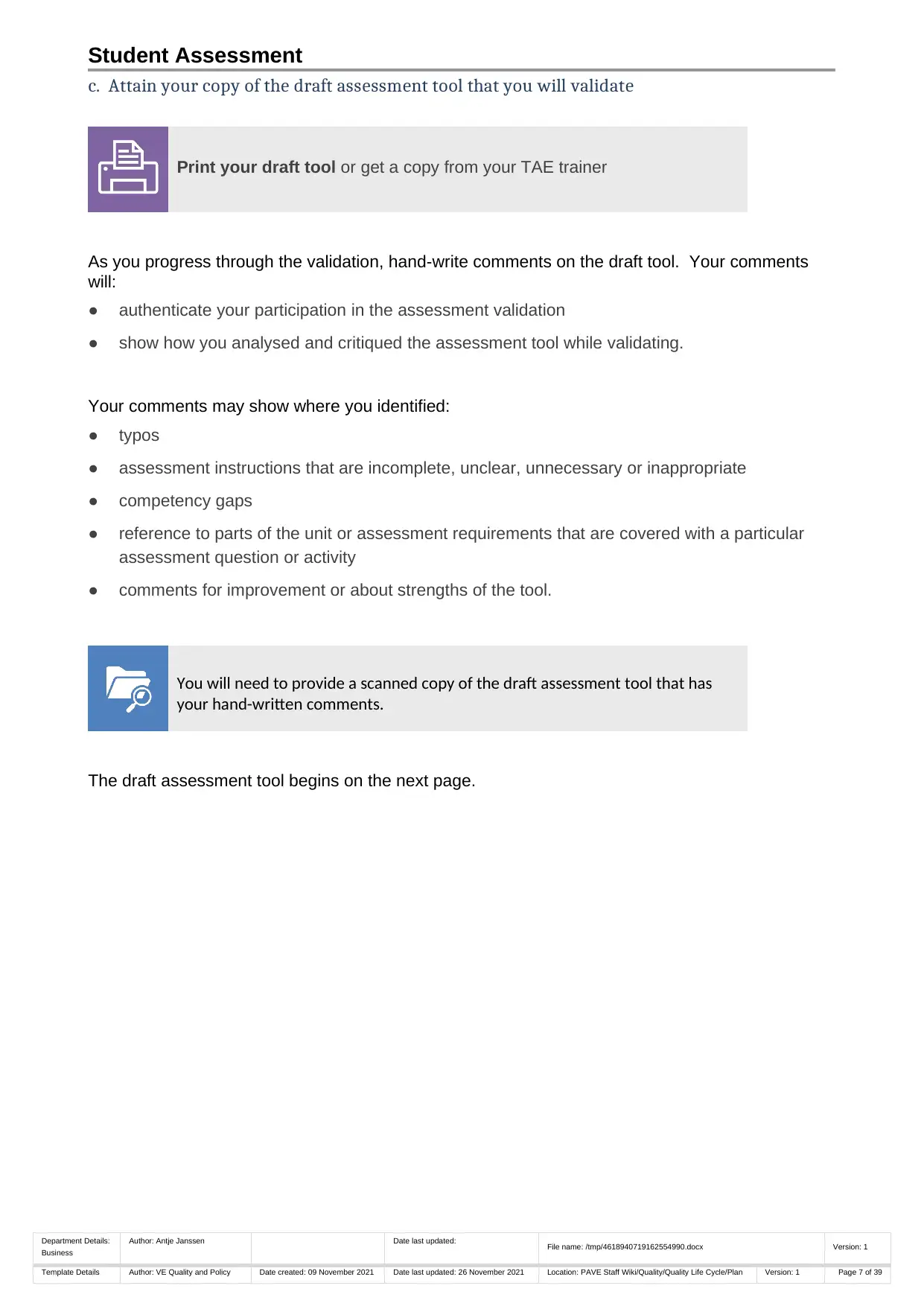
Student Assessment
c. Attain your copy of the draft assessment tool that you will validate
Print your draft tool or get a copy from your TAE trainer
As you progress through the validation, hand-write comments on the draft tool. Your comments
will:
● authenticate your participation in the assessment validation
● show how you analysed and critiqued the assessment tool while validating.
Your comments may show where you identified:
● typos
● assessment instructions that are incomplete, unclear, unnecessary or inappropriate
● competency gaps
● reference to parts of the unit or assessment requirements that are covered with a particular
assessment question or activity
● comments for improvement or about strengths of the tool.
You will need to provide a scanned copy of the draft assessment tool that has
your hand-written comments.
The draft assessment tool begins on the next page.
Department Details:
Business
Author: Antje Janssen Date last updated: File name: /tmp/4618940719162554990.docx Version: 1
Template Details Author: VE Quality and Policy Date created: 09 November 2021 Date last updated: 26 November 2021 Location: PAVE Staff Wiki/Quality/Quality Life Cycle/Plan Version: 1 Page 7 of 39
c. Attain your copy of the draft assessment tool that you will validate
Print your draft tool or get a copy from your TAE trainer
As you progress through the validation, hand-write comments on the draft tool. Your comments
will:
● authenticate your participation in the assessment validation
● show how you analysed and critiqued the assessment tool while validating.
Your comments may show where you identified:
● typos
● assessment instructions that are incomplete, unclear, unnecessary or inappropriate
● competency gaps
● reference to parts of the unit or assessment requirements that are covered with a particular
assessment question or activity
● comments for improvement or about strengths of the tool.
You will need to provide a scanned copy of the draft assessment tool that has
your hand-written comments.
The draft assessment tool begins on the next page.
Department Details:
Business
Author: Antje Janssen Date last updated: File name: /tmp/4618940719162554990.docx Version: 1
Template Details Author: VE Quality and Policy Date created: 09 November 2021 Date last updated: 26 November 2021 Location: PAVE Staff Wiki/Quality/Quality Life Cycle/Plan Version: 1 Page 7 of 39
Paraphrase This Document
Need a fresh take? Get an instant paraphrase of this document with our AI Paraphraser
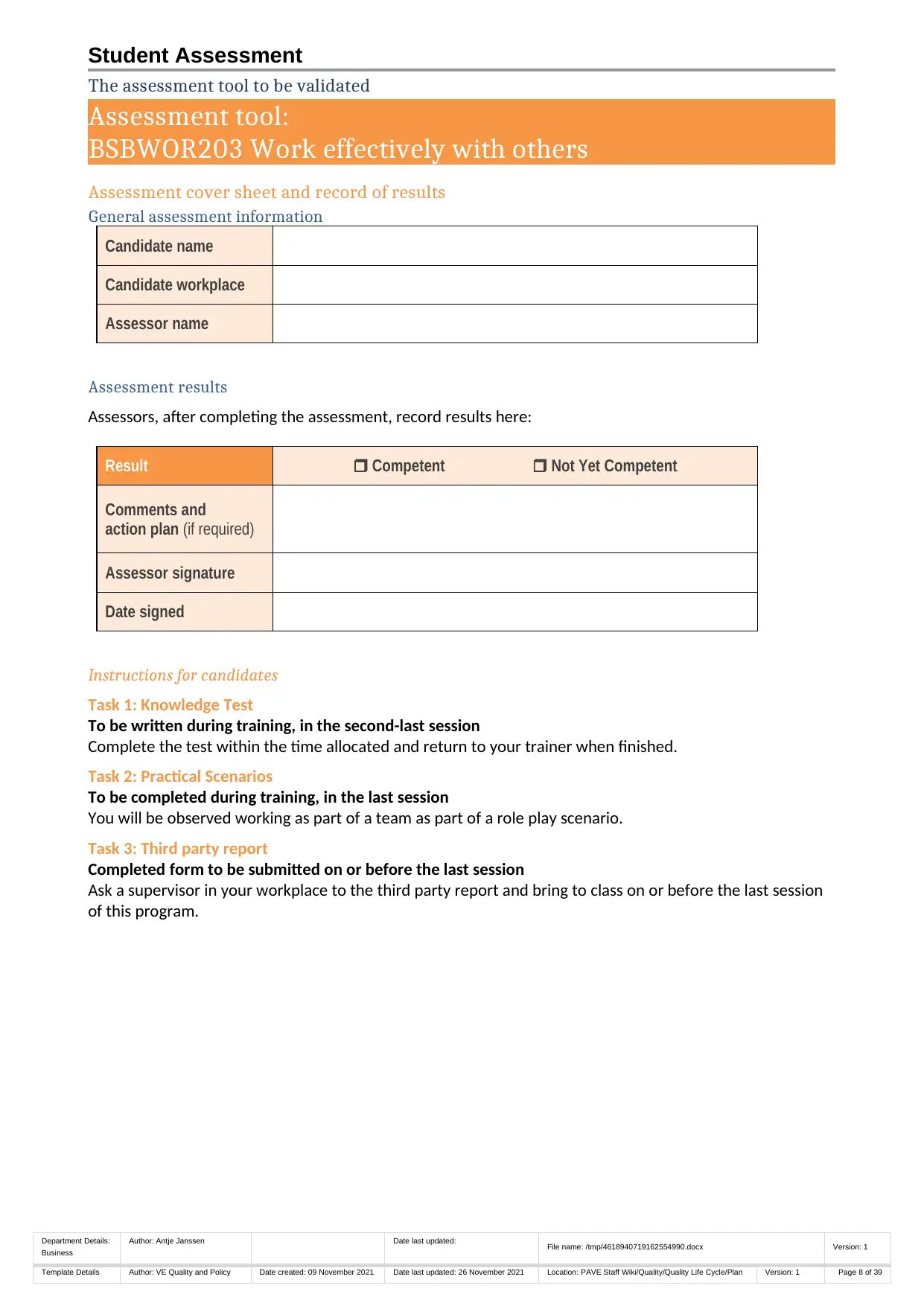
Student Assessment
The assessment tool to be validated
Assessment tool:
BSBWOR203 Work effectively with others
Assessment cover sheet and record of results
General assessment information
Candidate name
Candidate workplace
Assessor name
Assessment results
Assessors, after completing the assessment, record results here:
Result Competent Not Yet Competent
Comments and
action plan (if required)
Assessor signature
Date signed
Instructions for candidates
Task 1: Knowledge Test
To be written during training, in the second-last session
Complete the test within the time allocated and return to your trainer when finished.
Task 2: Practical Scenarios
To be completed during training, in the last session
You will be observed working as part of a team as part of a role play scenario.
Task 3: Third party report
Completed form to be submitted on or before the last session
Ask a supervisor in your workplace to the third party report and bring to class on or before the last session
of this program.
Department Details:
Business
Author: Antje Janssen Date last updated: File name: /tmp/4618940719162554990.docx Version: 1
Template Details Author: VE Quality and Policy Date created: 09 November 2021 Date last updated: 26 November 2021 Location: PAVE Staff Wiki/Quality/Quality Life Cycle/Plan Version: 1 Page 8 of 39
The assessment tool to be validated
Assessment tool:
BSBWOR203 Work effectively with others
Assessment cover sheet and record of results
General assessment information
Candidate name
Candidate workplace
Assessor name
Assessment results
Assessors, after completing the assessment, record results here:
Result Competent Not Yet Competent
Comments and
action plan (if required)
Assessor signature
Date signed
Instructions for candidates
Task 1: Knowledge Test
To be written during training, in the second-last session
Complete the test within the time allocated and return to your trainer when finished.
Task 2: Practical Scenarios
To be completed during training, in the last session
You will be observed working as part of a team as part of a role play scenario.
Task 3: Third party report
Completed form to be submitted on or before the last session
Ask a supervisor in your workplace to the third party report and bring to class on or before the last session
of this program.
Department Details:
Business
Author: Antje Janssen Date last updated: File name: /tmp/4618940719162554990.docx Version: 1
Template Details Author: VE Quality and Policy Date created: 09 November 2021 Date last updated: 26 November 2021 Location: PAVE Staff Wiki/Quality/Quality Life Cycle/Plan Version: 1 Page 8 of 39
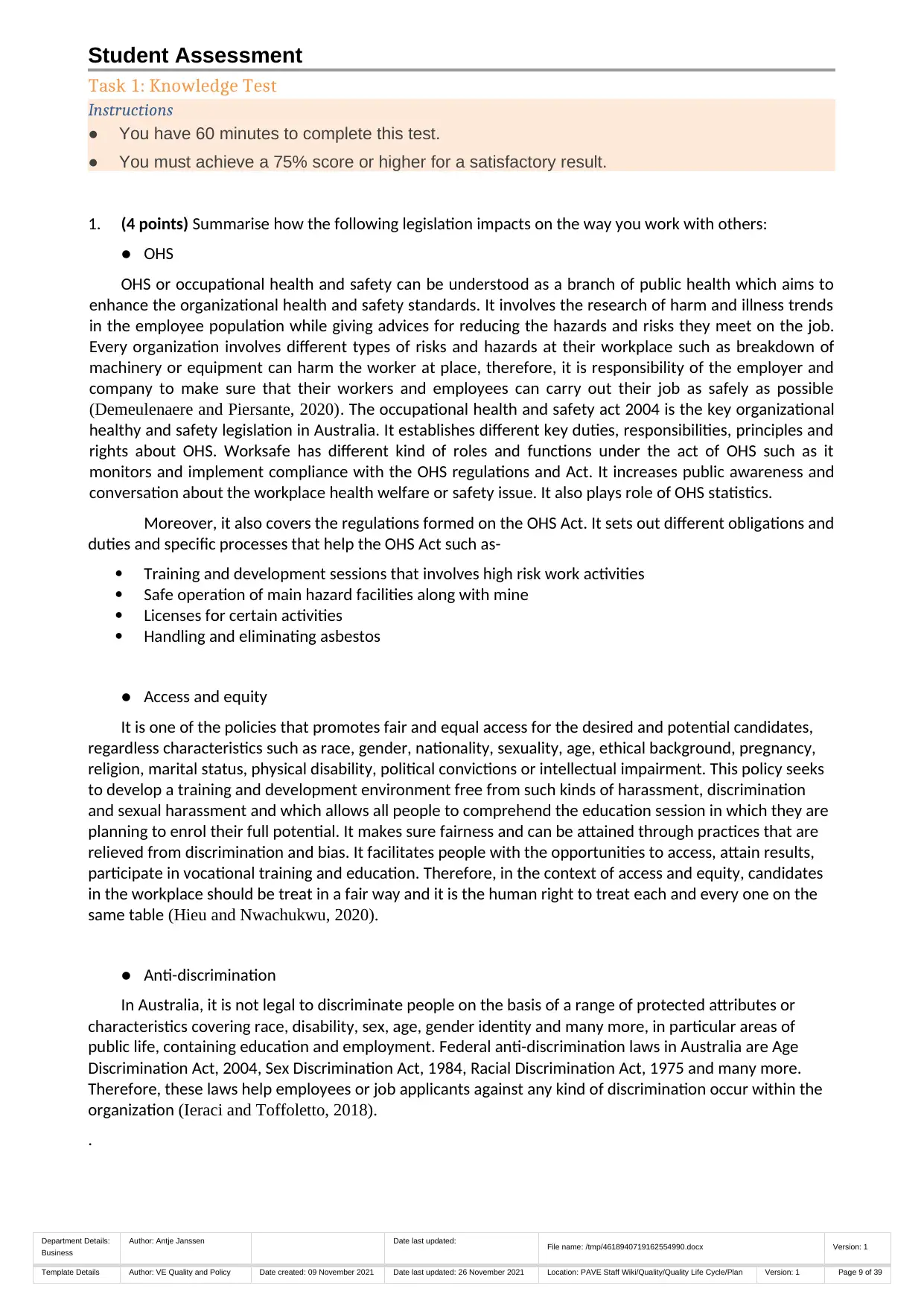
Student Assessment
Task 1: Knowledge Test
Instructions
● You have 60 minutes to complete this test.
● You must achieve a 75% score or higher for a satisfactory result.
1. (4 points) Summarise how the following legislation impacts on the way you work with others:
● OHS
OHS or occupational health and safety can be understood as a branch of public health which aims to
enhance the organizational health and safety standards. It involves the research of harm and illness trends
in the employee population while giving advices for reducing the hazards and risks they meet on the job.
Every organization involves different types of risks and hazards at their workplace such as breakdown of
machinery or equipment can harm the worker at place, therefore, it is responsibility of the employer and
company to make sure that their workers and employees can carry out their job as safely as possible
(Demeulenaere and Piersante, 2020). The occupational health and safety act 2004 is the key organizational
healthy and safety legislation in Australia. It establishes different key duties, responsibilities, principles and
rights about OHS. Worksafe has different kind of roles and functions under the act of OHS such as it
monitors and implement compliance with the OHS regulations and Act. It increases public awareness and
conversation about the workplace health welfare or safety issue. It also plays role of OHS statistics.
Moreover, it also covers the regulations formed on the OHS Act. It sets out different obligations and
duties and specific processes that help the OHS Act such as-
Training and development sessions that involves high risk work activities
Safe operation of main hazard facilities along with mine
Licenses for certain activities
Handling and eliminating asbestos
● Access and equity
It is one of the policies that promotes fair and equal access for the desired and potential candidates,
regardless characteristics such as race, gender, nationality, sexuality, age, ethical background, pregnancy,
religion, marital status, physical disability, political convictions or intellectual impairment. This policy seeks
to develop a training and development environment free from such kinds of harassment, discrimination
and sexual harassment and which allows all people to comprehend the education session in which they are
planning to enrol their full potential. It makes sure fairness and can be attained through practices that are
relieved from discrimination and bias. It facilitates people with the opportunities to access, attain results,
participate in vocational training and education. Therefore, in the context of access and equity, candidates
in the workplace should be treat in a fair way and it is the human right to treat each and every one on the
same table (Hieu and Nwachukwu, 2020).
● Anti-discrimination
In Australia, it is not legal to discriminate people on the basis of a range of protected attributes or
characteristics covering race, disability, sex, age, gender identity and many more, in particular areas of
public life, containing education and employment. Federal anti-discrimination laws in Australia are Age
Discrimination Act, 2004, Sex Discrimination Act, 1984, Racial Discrimination Act, 1975 and many more.
Therefore, these laws help employees or job applicants against any kind of discrimination occur within the
organization (Ieraci and Toffoletto, 2018).
.
Department Details:
Business
Author: Antje Janssen Date last updated: File name: /tmp/4618940719162554990.docx Version: 1
Template Details Author: VE Quality and Policy Date created: 09 November 2021 Date last updated: 26 November 2021 Location: PAVE Staff Wiki/Quality/Quality Life Cycle/Plan Version: 1 Page 9 of 39
Task 1: Knowledge Test
Instructions
● You have 60 minutes to complete this test.
● You must achieve a 75% score or higher for a satisfactory result.
1. (4 points) Summarise how the following legislation impacts on the way you work with others:
● OHS
OHS or occupational health and safety can be understood as a branch of public health which aims to
enhance the organizational health and safety standards. It involves the research of harm and illness trends
in the employee population while giving advices for reducing the hazards and risks they meet on the job.
Every organization involves different types of risks and hazards at their workplace such as breakdown of
machinery or equipment can harm the worker at place, therefore, it is responsibility of the employer and
company to make sure that their workers and employees can carry out their job as safely as possible
(Demeulenaere and Piersante, 2020). The occupational health and safety act 2004 is the key organizational
healthy and safety legislation in Australia. It establishes different key duties, responsibilities, principles and
rights about OHS. Worksafe has different kind of roles and functions under the act of OHS such as it
monitors and implement compliance with the OHS regulations and Act. It increases public awareness and
conversation about the workplace health welfare or safety issue. It also plays role of OHS statistics.
Moreover, it also covers the regulations formed on the OHS Act. It sets out different obligations and
duties and specific processes that help the OHS Act such as-
Training and development sessions that involves high risk work activities
Safe operation of main hazard facilities along with mine
Licenses for certain activities
Handling and eliminating asbestos
● Access and equity
It is one of the policies that promotes fair and equal access for the desired and potential candidates,
regardless characteristics such as race, gender, nationality, sexuality, age, ethical background, pregnancy,
religion, marital status, physical disability, political convictions or intellectual impairment. This policy seeks
to develop a training and development environment free from such kinds of harassment, discrimination
and sexual harassment and which allows all people to comprehend the education session in which they are
planning to enrol their full potential. It makes sure fairness and can be attained through practices that are
relieved from discrimination and bias. It facilitates people with the opportunities to access, attain results,
participate in vocational training and education. Therefore, in the context of access and equity, candidates
in the workplace should be treat in a fair way and it is the human right to treat each and every one on the
same table (Hieu and Nwachukwu, 2020).
● Anti-discrimination
In Australia, it is not legal to discriminate people on the basis of a range of protected attributes or
characteristics covering race, disability, sex, age, gender identity and many more, in particular areas of
public life, containing education and employment. Federal anti-discrimination laws in Australia are Age
Discrimination Act, 2004, Sex Discrimination Act, 1984, Racial Discrimination Act, 1975 and many more.
Therefore, these laws help employees or job applicants against any kind of discrimination occur within the
organization (Ieraci and Toffoletto, 2018).
.
Department Details:
Business
Author: Antje Janssen Date last updated: File name: /tmp/4618940719162554990.docx Version: 1
Template Details Author: VE Quality and Policy Date created: 09 November 2021 Date last updated: 26 November 2021 Location: PAVE Staff Wiki/Quality/Quality Life Cycle/Plan Version: 1 Page 9 of 39
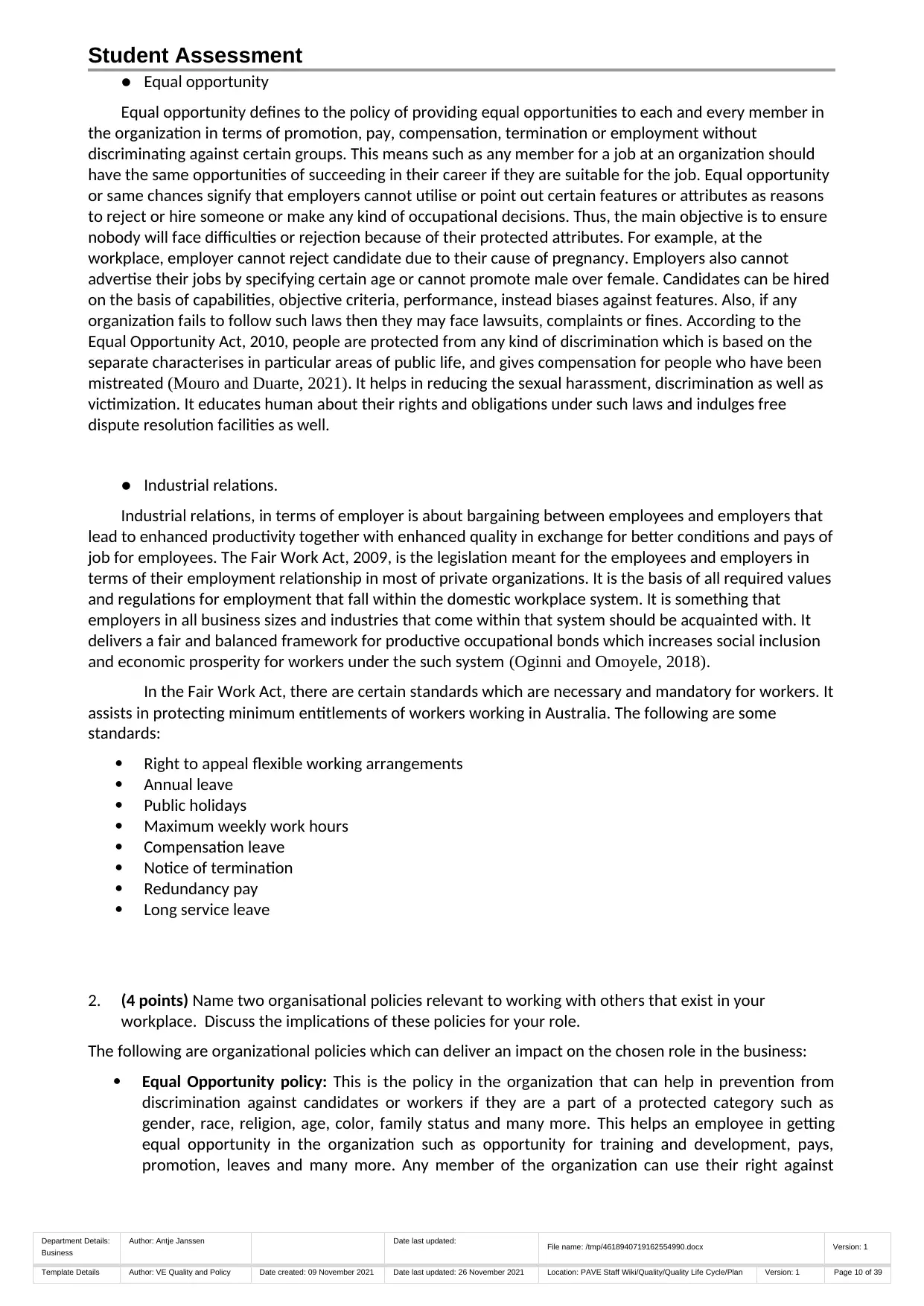
Student Assessment
● Equal opportunity
Equal opportunity defines to the policy of providing equal opportunities to each and every member in
the organization in terms of promotion, pay, compensation, termination or employment without
discriminating against certain groups. This means such as any member for a job at an organization should
have the same opportunities of succeeding in their career if they are suitable for the job. Equal opportunity
or same chances signify that employers cannot utilise or point out certain features or attributes as reasons
to reject or hire someone or make any kind of occupational decisions. Thus, the main objective is to ensure
nobody will face difficulties or rejection because of their protected attributes. For example, at the
workplace, employer cannot reject candidate due to their cause of pregnancy. Employers also cannot
advertise their jobs by specifying certain age or cannot promote male over female. Candidates can be hired
on the basis of capabilities, objective criteria, performance, instead biases against features. Also, if any
organization fails to follow such laws then they may face lawsuits, complaints or fines. According to the
Equal Opportunity Act, 2010, people are protected from any kind of discrimination which is based on the
separate characterises in particular areas of public life, and gives compensation for people who have been
mistreated (Mouro and Duarte, 2021). It helps in reducing the sexual harassment, discrimination as well as
victimization. It educates human about their rights and obligations under such laws and indulges free
dispute resolution facilities as well.
● Industrial relations.
Industrial relations, in terms of employer is about bargaining between employees and employers that
lead to enhanced productivity together with enhanced quality in exchange for better conditions and pays of
job for employees. The Fair Work Act, 2009, is the legislation meant for the employees and employers in
terms of their employment relationship in most of private organizations. It is the basis of all required values
and regulations for employment that fall within the domestic workplace system. It is something that
employers in all business sizes and industries that come within that system should be acquainted with. It
delivers a fair and balanced framework for productive occupational bonds which increases social inclusion
and economic prosperity for workers under the such system (Oginni and Omoyele, 2018).
In the Fair Work Act, there are certain standards which are necessary and mandatory for workers. It
assists in protecting minimum entitlements of workers working in Australia. The following are some
standards:
Right to appeal flexible working arrangements
Annual leave
Public holidays
Maximum weekly work hours
Compensation leave
Notice of termination
Redundancy pay
Long service leave
2. (4 points) Name two organisational policies relevant to working with others that exist in your
workplace. Discuss the implications of these policies for your role.
The following are organizational policies which can deliver an impact on the chosen role in the business:
Equal Opportunity policy: This is the policy in the organization that can help in prevention from
discrimination against candidates or workers if they are a part of a protected category such as
gender, race, religion, age, color, family status and many more. This helps an employee in getting
equal opportunity in the organization such as opportunity for training and development, pays,
promotion, leaves and many more. Any member of the organization can use their right against
Department Details:
Business
Author: Antje Janssen Date last updated: File name: /tmp/4618940719162554990.docx Version: 1
Template Details Author: VE Quality and Policy Date created: 09 November 2021 Date last updated: 26 November 2021 Location: PAVE Staff Wiki/Quality/Quality Life Cycle/Plan Version: 1 Page 10 of 39
● Equal opportunity
Equal opportunity defines to the policy of providing equal opportunities to each and every member in
the organization in terms of promotion, pay, compensation, termination or employment without
discriminating against certain groups. This means such as any member for a job at an organization should
have the same opportunities of succeeding in their career if they are suitable for the job. Equal opportunity
or same chances signify that employers cannot utilise or point out certain features or attributes as reasons
to reject or hire someone or make any kind of occupational decisions. Thus, the main objective is to ensure
nobody will face difficulties or rejection because of their protected attributes. For example, at the
workplace, employer cannot reject candidate due to their cause of pregnancy. Employers also cannot
advertise their jobs by specifying certain age or cannot promote male over female. Candidates can be hired
on the basis of capabilities, objective criteria, performance, instead biases against features. Also, if any
organization fails to follow such laws then they may face lawsuits, complaints or fines. According to the
Equal Opportunity Act, 2010, people are protected from any kind of discrimination which is based on the
separate characterises in particular areas of public life, and gives compensation for people who have been
mistreated (Mouro and Duarte, 2021). It helps in reducing the sexual harassment, discrimination as well as
victimization. It educates human about their rights and obligations under such laws and indulges free
dispute resolution facilities as well.
● Industrial relations.
Industrial relations, in terms of employer is about bargaining between employees and employers that
lead to enhanced productivity together with enhanced quality in exchange for better conditions and pays of
job for employees. The Fair Work Act, 2009, is the legislation meant for the employees and employers in
terms of their employment relationship in most of private organizations. It is the basis of all required values
and regulations for employment that fall within the domestic workplace system. It is something that
employers in all business sizes and industries that come within that system should be acquainted with. It
delivers a fair and balanced framework for productive occupational bonds which increases social inclusion
and economic prosperity for workers under the such system (Oginni and Omoyele, 2018).
In the Fair Work Act, there are certain standards which are necessary and mandatory for workers. It
assists in protecting minimum entitlements of workers working in Australia. The following are some
standards:
Right to appeal flexible working arrangements
Annual leave
Public holidays
Maximum weekly work hours
Compensation leave
Notice of termination
Redundancy pay
Long service leave
2. (4 points) Name two organisational policies relevant to working with others that exist in your
workplace. Discuss the implications of these policies for your role.
The following are organizational policies which can deliver an impact on the chosen role in the business:
Equal Opportunity policy: This is the policy in the organization that can help in prevention from
discrimination against candidates or workers if they are a part of a protected category such as
gender, race, religion, age, color, family status and many more. This helps an employee in getting
equal opportunity in the organization such as opportunity for training and development, pays,
promotion, leaves and many more. Any member of the organization can use their right against
Department Details:
Business
Author: Antje Janssen Date last updated: File name: /tmp/4618940719162554990.docx Version: 1
Template Details Author: VE Quality and Policy Date created: 09 November 2021 Date last updated: 26 November 2021 Location: PAVE Staff Wiki/Quality/Quality Life Cycle/Plan Version: 1 Page 10 of 39
Secure Best Marks with AI Grader
Need help grading? Try our AI Grader for instant feedback on your assignments.
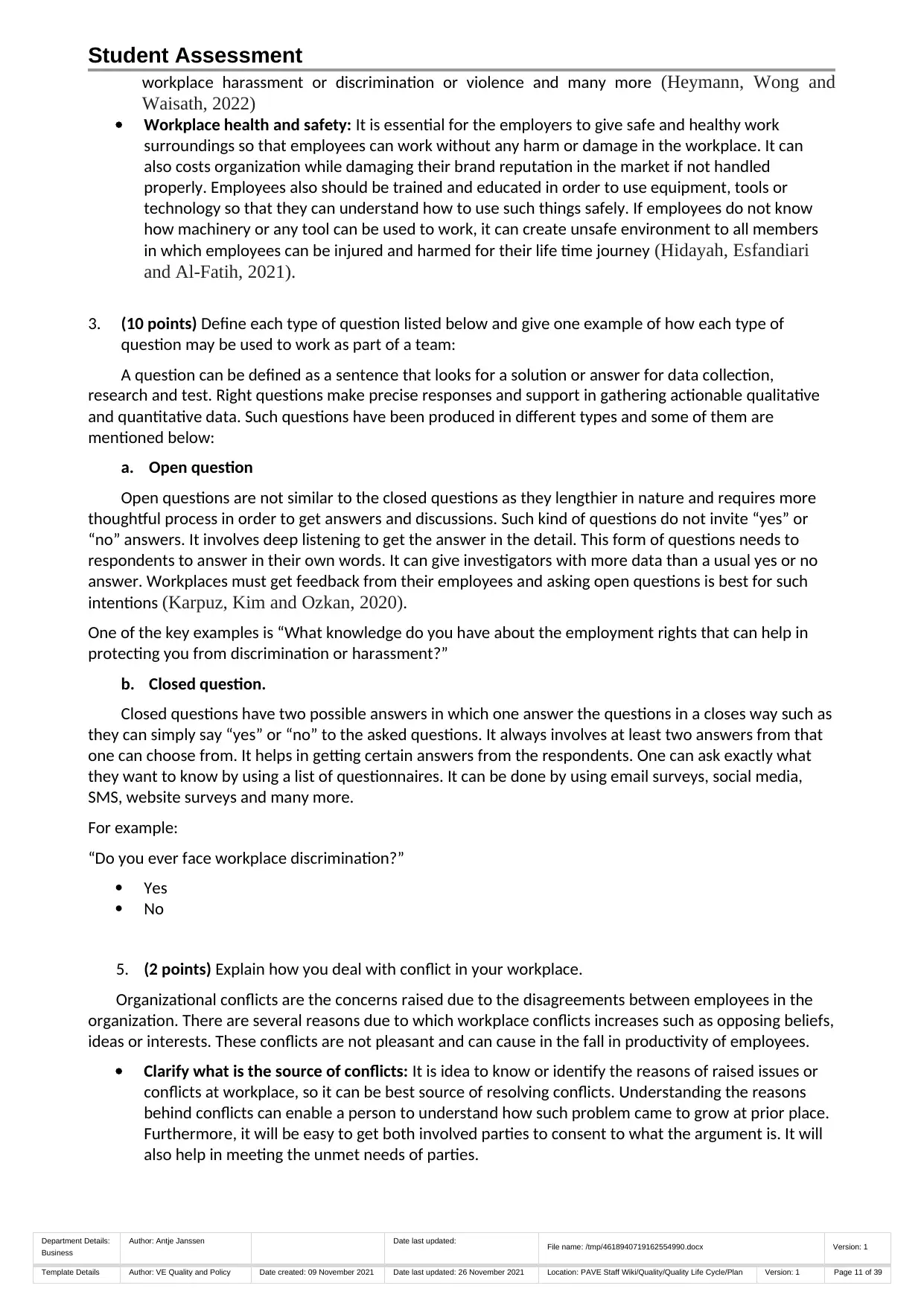
Student Assessment
workplace harassment or discrimination or violence and many more (Heymann, Wong and
Waisath, 2022)
Workplace health and safety: It is essential for the employers to give safe and healthy work
surroundings so that employees can work without any harm or damage in the workplace. It can
also costs organization while damaging their brand reputation in the market if not handled
properly. Employees also should be trained and educated in order to use equipment, tools or
technology so that they can understand how to use such things safely. If employees do not know
how machinery or any tool can be used to work, it can create unsafe environment to all members
in which employees can be injured and harmed for their life time journey (Hidayah, Esfandiari
and Al-Fatih, 2021).
3. (10 points) Define each type of question listed below and give one example of how each type of
question may be used to work as part of a team:
A question can be defined as a sentence that looks for a solution or answer for data collection,
research and test. Right questions make precise responses and support in gathering actionable qualitative
and quantitative data. Such questions have been produced in different types and some of them are
mentioned below:
a. Open question
Open questions are not similar to the closed questions as they lengthier in nature and requires more
thoughtful process in order to get answers and discussions. Such kind of questions do not invite “yes” or
“no” answers. It involves deep listening to get the answer in the detail. This form of questions needs to
respondents to answer in their own words. It can give investigators with more data than a usual yes or no
answer. Workplaces must get feedback from their employees and asking open questions is best for such
intentions (Karpuz, Kim and Ozkan, 2020).
One of the key examples is “What knowledge do you have about the employment rights that can help in
protecting you from discrimination or harassment?”
b. Closed question.
Closed questions have two possible answers in which one answer the questions in a closes way such as
they can simply say “yes” or “no” to the asked questions. It always involves at least two answers from that
one can choose from. It helps in getting certain answers from the respondents. One can ask exactly what
they want to know by using a list of questionnaires. It can be done by using email surveys, social media,
SMS, website surveys and many more.
For example:
“Do you ever face workplace discrimination?”
Yes
No
5. (2 points) Explain how you deal with conflict in your workplace.
Organizational conflicts are the concerns raised due to the disagreements between employees in the
organization. There are several reasons due to which workplace conflicts increases such as opposing beliefs,
ideas or interests. These conflicts are not pleasant and can cause in the fall in productivity of employees.
Clarify what is the source of conflicts: It is idea to know or identify the reasons of raised issues or
conflicts at workplace, so it can be best source of resolving conflicts. Understanding the reasons
behind conflicts can enable a person to understand how such problem came to grow at prior place.
Furthermore, it will be easy to get both involved parties to consent to what the argument is. It will
also help in meeting the unmet needs of parties.
Department Details:
Business
Author: Antje Janssen Date last updated: File name: /tmp/4618940719162554990.docx Version: 1
Template Details Author: VE Quality and Policy Date created: 09 November 2021 Date last updated: 26 November 2021 Location: PAVE Staff Wiki/Quality/Quality Life Cycle/Plan Version: 1 Page 11 of 39
workplace harassment or discrimination or violence and many more (Heymann, Wong and
Waisath, 2022)
Workplace health and safety: It is essential for the employers to give safe and healthy work
surroundings so that employees can work without any harm or damage in the workplace. It can
also costs organization while damaging their brand reputation in the market if not handled
properly. Employees also should be trained and educated in order to use equipment, tools or
technology so that they can understand how to use such things safely. If employees do not know
how machinery or any tool can be used to work, it can create unsafe environment to all members
in which employees can be injured and harmed for their life time journey (Hidayah, Esfandiari
and Al-Fatih, 2021).
3. (10 points) Define each type of question listed below and give one example of how each type of
question may be used to work as part of a team:
A question can be defined as a sentence that looks for a solution or answer for data collection,
research and test. Right questions make precise responses and support in gathering actionable qualitative
and quantitative data. Such questions have been produced in different types and some of them are
mentioned below:
a. Open question
Open questions are not similar to the closed questions as they lengthier in nature and requires more
thoughtful process in order to get answers and discussions. Such kind of questions do not invite “yes” or
“no” answers. It involves deep listening to get the answer in the detail. This form of questions needs to
respondents to answer in their own words. It can give investigators with more data than a usual yes or no
answer. Workplaces must get feedback from their employees and asking open questions is best for such
intentions (Karpuz, Kim and Ozkan, 2020).
One of the key examples is “What knowledge do you have about the employment rights that can help in
protecting you from discrimination or harassment?”
b. Closed question.
Closed questions have two possible answers in which one answer the questions in a closes way such as
they can simply say “yes” or “no” to the asked questions. It always involves at least two answers from that
one can choose from. It helps in getting certain answers from the respondents. One can ask exactly what
they want to know by using a list of questionnaires. It can be done by using email surveys, social media,
SMS, website surveys and many more.
For example:
“Do you ever face workplace discrimination?”
Yes
No
5. (2 points) Explain how you deal with conflict in your workplace.
Organizational conflicts are the concerns raised due to the disagreements between employees in the
organization. There are several reasons due to which workplace conflicts increases such as opposing beliefs,
ideas or interests. These conflicts are not pleasant and can cause in the fall in productivity of employees.
Clarify what is the source of conflicts: It is idea to know or identify the reasons of raised issues or
conflicts at workplace, so it can be best source of resolving conflicts. Understanding the reasons
behind conflicts can enable a person to understand how such problem came to grow at prior place.
Furthermore, it will be easy to get both involved parties to consent to what the argument is. It will
also help in meeting the unmet needs of parties.
Department Details:
Business
Author: Antje Janssen Date last updated: File name: /tmp/4618940719162554990.docx Version: 1
Template Details Author: VE Quality and Policy Date created: 09 November 2021 Date last updated: 26 November 2021 Location: PAVE Staff Wiki/Quality/Quality Life Cycle/Plan Version: 1 Page 11 of 39
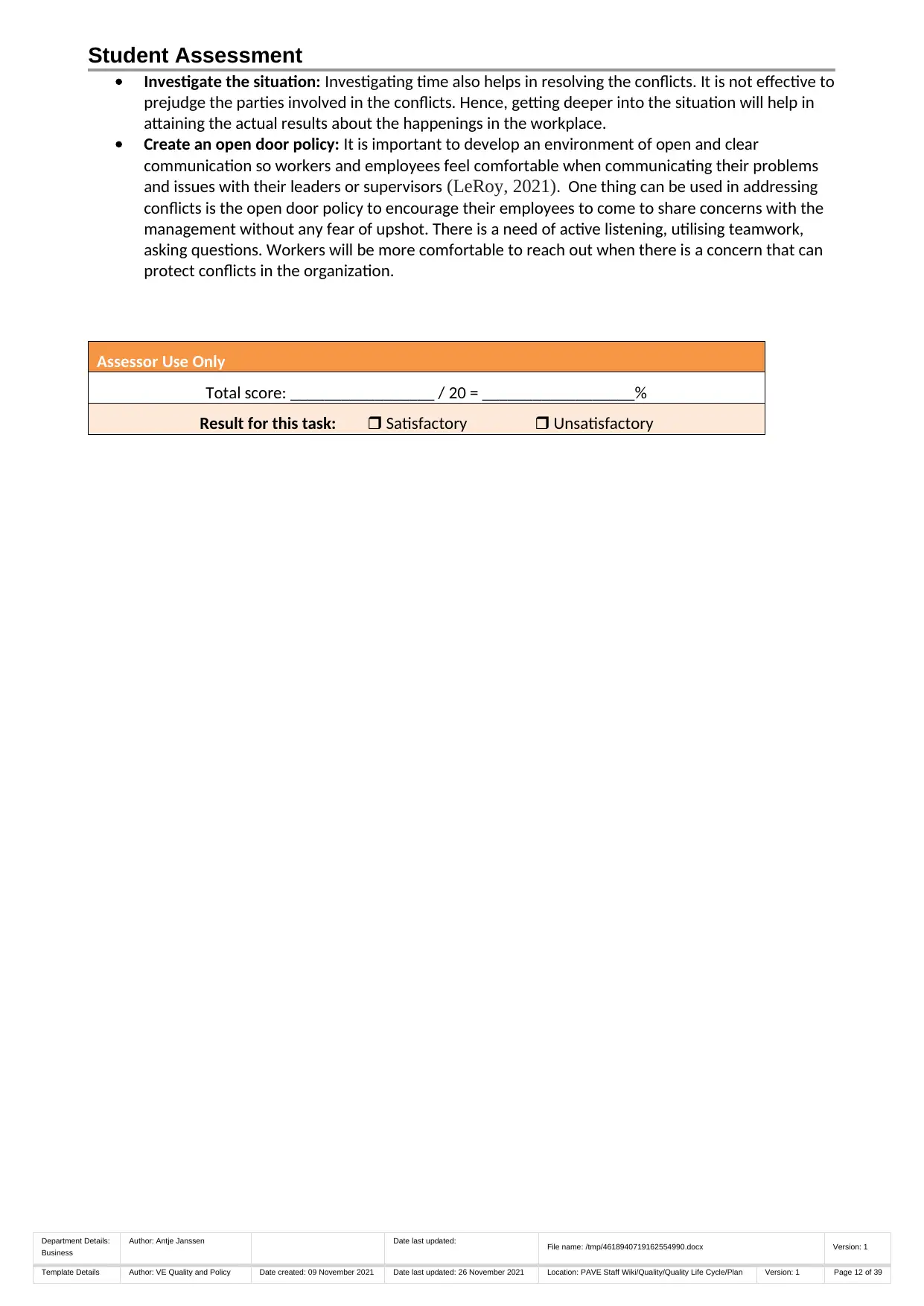
Student Assessment
Investigate the situation: Investigating time also helps in resolving the conflicts. It is not effective to
prejudge the parties involved in the conflicts. Hence, getting deeper into the situation will help in
attaining the actual results about the happenings in the workplace.
Create an open door policy: It is important to develop an environment of open and clear
communication so workers and employees feel comfortable when communicating their problems
and issues with their leaders or supervisors (LeRoy, 2021). One thing can be used in addressing
conflicts is the open door policy to encourage their employees to come to share concerns with the
management without any fear of upshot. There is a need of active listening, utilising teamwork,
asking questions. Workers will be more comfortable to reach out when there is a concern that can
protect conflicts in the organization.
Assessor Use Only
Total score: _________________ / 20 = __________________%
Result for this task: Satisfactory Unsatisfactory
Department Details:
Business
Author: Antje Janssen Date last updated: File name: /tmp/4618940719162554990.docx Version: 1
Template Details Author: VE Quality and Policy Date created: 09 November 2021 Date last updated: 26 November 2021 Location: PAVE Staff Wiki/Quality/Quality Life Cycle/Plan Version: 1 Page 12 of 39
Investigate the situation: Investigating time also helps in resolving the conflicts. It is not effective to
prejudge the parties involved in the conflicts. Hence, getting deeper into the situation will help in
attaining the actual results about the happenings in the workplace.
Create an open door policy: It is important to develop an environment of open and clear
communication so workers and employees feel comfortable when communicating their problems
and issues with their leaders or supervisors (LeRoy, 2021). One thing can be used in addressing
conflicts is the open door policy to encourage their employees to come to share concerns with the
management without any fear of upshot. There is a need of active listening, utilising teamwork,
asking questions. Workers will be more comfortable to reach out when there is a concern that can
protect conflicts in the organization.
Assessor Use Only
Total score: _________________ / 20 = __________________%
Result for this task: Satisfactory Unsatisfactory
Department Details:
Business
Author: Antje Janssen Date last updated: File name: /tmp/4618940719162554990.docx Version: 1
Template Details Author: VE Quality and Policy Date created: 09 November 2021 Date last updated: 26 November 2021 Location: PAVE Staff Wiki/Quality/Quality Life Cycle/Plan Version: 1 Page 12 of 39
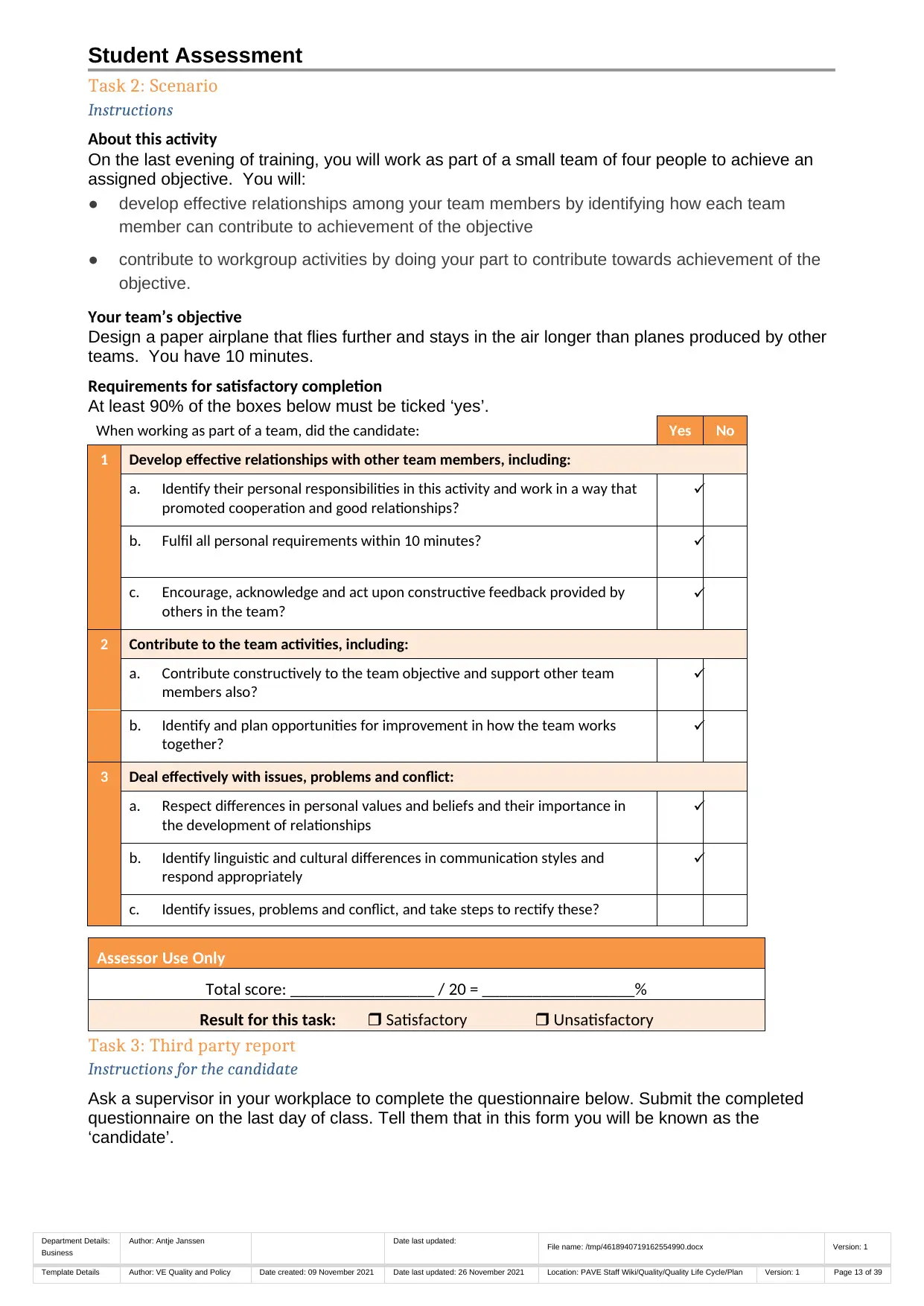
Student Assessment
Task 2: Scenario
Instructions
About this activity
On the last evening of training, you will work as part of a small team of four people to achieve an
assigned objective. You will:
● develop effective relationships among your team members by identifying how each team
member can contribute to achievement of the objective
● contribute to workgroup activities by doing your part to contribute towards achievement of the
objective.
Your team’s objective
Design a paper airplane that flies further and stays in the air longer than planes produced by other
teams. You have 10 minutes.
Requirements for satisfactory completion
At least 90% of the boxes below must be ticked ‘yes’.
When working as part of a team, did the candidate: Yes No
1 Develop effective relationships with other team members, including:
a. Identify their personal responsibilities in this activity and work in a way that
promoted cooperation and good relationships?
b. Fulfil all personal requirements within 10 minutes?
c. Encourage, acknowledge and act upon constructive feedback provided by
others in the team?
2 Contribute to the team activities, including:
a. Contribute constructively to the team objective and support other team
members also?
b. Identify and plan opportunities for improvement in how the team works
together?
3 Deal effectively with issues, problems and conflict:
a. Respect differences in personal values and beliefs and their importance in
the development of relationships
b. Identify linguistic and cultural differences in communication styles and
respond appropriately
c. Identify issues, problems and conflict, and take steps to rectify these?
Assessor Use Only
Total score: _________________ / 20 = __________________%
Result for this task: Satisfactory Unsatisfactory
Task 3: Third party report
Instructions for the candidate
Ask a supervisor in your workplace to complete the questionnaire below. Submit the completed
questionnaire on the last day of class. Tell them that in this form you will be known as the
‘candidate’.
Department Details:
Business
Author: Antje Janssen Date last updated: File name: /tmp/4618940719162554990.docx Version: 1
Template Details Author: VE Quality and Policy Date created: 09 November 2021 Date last updated: 26 November 2021 Location: PAVE Staff Wiki/Quality/Quality Life Cycle/Plan Version: 1 Page 13 of 39
Task 2: Scenario
Instructions
About this activity
On the last evening of training, you will work as part of a small team of four people to achieve an
assigned objective. You will:
● develop effective relationships among your team members by identifying how each team
member can contribute to achievement of the objective
● contribute to workgroup activities by doing your part to contribute towards achievement of the
objective.
Your team’s objective
Design a paper airplane that flies further and stays in the air longer than planes produced by other
teams. You have 10 minutes.
Requirements for satisfactory completion
At least 90% of the boxes below must be ticked ‘yes’.
When working as part of a team, did the candidate: Yes No
1 Develop effective relationships with other team members, including:
a. Identify their personal responsibilities in this activity and work in a way that
promoted cooperation and good relationships?
b. Fulfil all personal requirements within 10 minutes?
c. Encourage, acknowledge and act upon constructive feedback provided by
others in the team?
2 Contribute to the team activities, including:
a. Contribute constructively to the team objective and support other team
members also?
b. Identify and plan opportunities for improvement in how the team works
together?
3 Deal effectively with issues, problems and conflict:
a. Respect differences in personal values and beliefs and their importance in
the development of relationships
b. Identify linguistic and cultural differences in communication styles and
respond appropriately
c. Identify issues, problems and conflict, and take steps to rectify these?
Assessor Use Only
Total score: _________________ / 20 = __________________%
Result for this task: Satisfactory Unsatisfactory
Task 3: Third party report
Instructions for the candidate
Ask a supervisor in your workplace to complete the questionnaire below. Submit the completed
questionnaire on the last day of class. Tell them that in this form you will be known as the
‘candidate’.
Department Details:
Business
Author: Antje Janssen Date last updated: File name: /tmp/4618940719162554990.docx Version: 1
Template Details Author: VE Quality and Policy Date created: 09 November 2021 Date last updated: 26 November 2021 Location: PAVE Staff Wiki/Quality/Quality Life Cycle/Plan Version: 1 Page 13 of 39
Paraphrase This Document
Need a fresh take? Get an instant paraphrase of this document with our AI Paraphraser
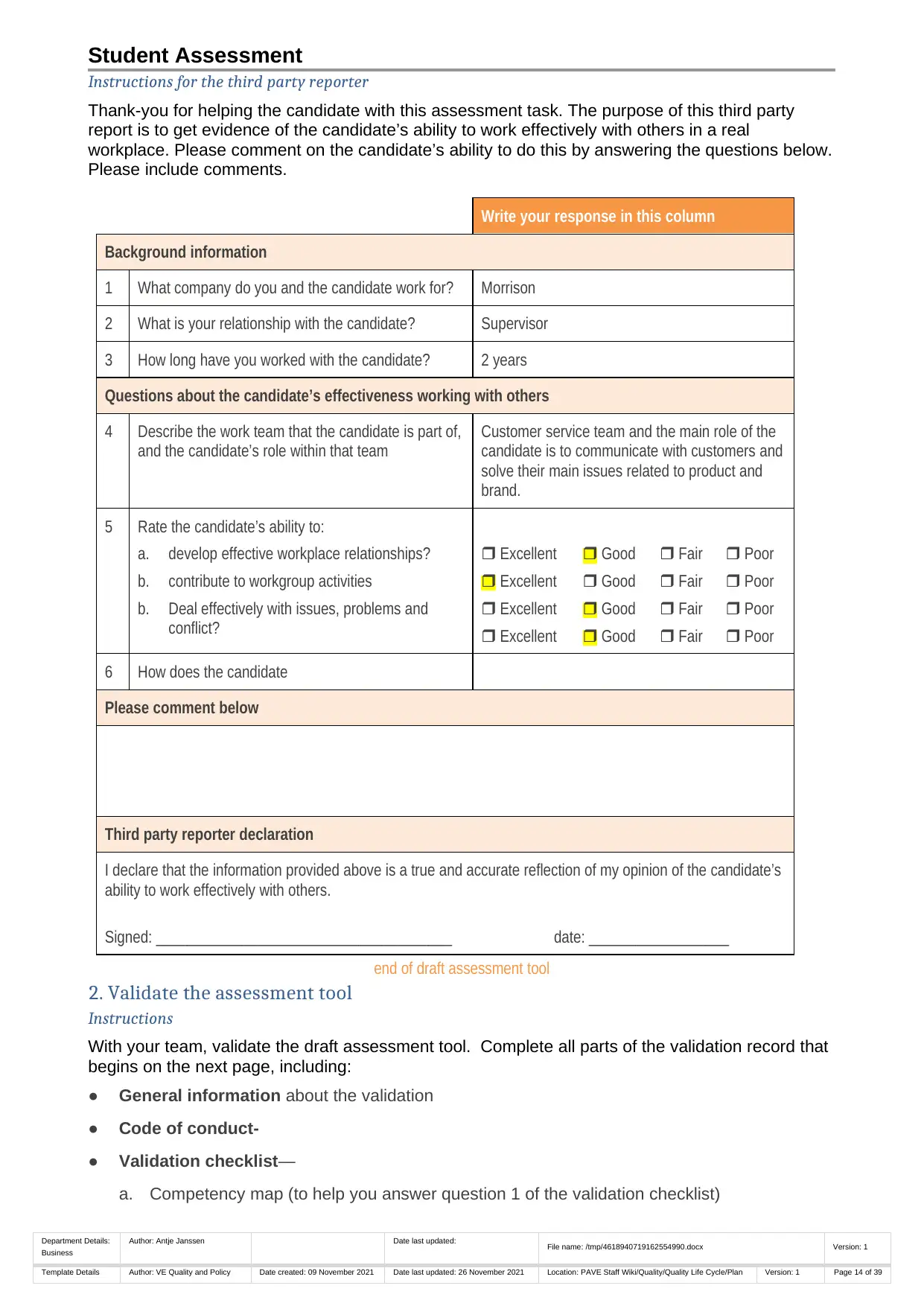
Student Assessment
Instructions for the third party reporter
Thank-you for helping the candidate with this assessment task. The purpose of this third party
report is to get evidence of the candidate’s ability to work effectively with others in a real
workplace. Please comment on the candidate’s ability to do this by answering the questions below.
Please include comments.
Write your response in this column
Background information
1 What company do you and the candidate work for? Morrison
2 What is your relationship with the candidate? Supervisor
3 How long have you worked with the candidate? 2 years
Questions about the candidate’s effectiveness working with others
4 Describe the work team that the candidate is part of,
and the candidate’s role within that team
Customer service team and the main role of the
candidate is to communicate with customers and
solve their main issues related to product and
brand.
5 Rate the candidate’s ability to:
a. develop effective workplace relationships?
b. contribute to workgroup activities
b. Deal effectively with issues, problems and
conflict?
Excellent Good Fair Poor
Excellent Good Fair Poor
Excellent Good Fair Poor
Excellent Good Fair Poor
6 How does the candidate
Please comment below
Third party reporter declaration
I declare that the information provided above is a true and accurate reflection of my opinion of the candidate’s
ability to work effectively with others.
Signed: ______________________________________ date: __________________
end of draft assessment tool
2. Validate the assessment tool
Instructions
With your team, validate the draft assessment tool. Complete all parts of the validation record that
begins on the next page, including:
● General information about the validation
● Code of conduct-
● Validation checklist—
a. Competency map (to help you answer question 1 of the validation checklist)
Department Details:
Business
Author: Antje Janssen Date last updated: File name: /tmp/4618940719162554990.docx Version: 1
Template Details Author: VE Quality and Policy Date created: 09 November 2021 Date last updated: 26 November 2021 Location: PAVE Staff Wiki/Quality/Quality Life Cycle/Plan Version: 1 Page 14 of 39
Instructions for the third party reporter
Thank-you for helping the candidate with this assessment task. The purpose of this third party
report is to get evidence of the candidate’s ability to work effectively with others in a real
workplace. Please comment on the candidate’s ability to do this by answering the questions below.
Please include comments.
Write your response in this column
Background information
1 What company do you and the candidate work for? Morrison
2 What is your relationship with the candidate? Supervisor
3 How long have you worked with the candidate? 2 years
Questions about the candidate’s effectiveness working with others
4 Describe the work team that the candidate is part of,
and the candidate’s role within that team
Customer service team and the main role of the
candidate is to communicate with customers and
solve their main issues related to product and
brand.
5 Rate the candidate’s ability to:
a. develop effective workplace relationships?
b. contribute to workgroup activities
b. Deal effectively with issues, problems and
conflict?
Excellent Good Fair Poor
Excellent Good Fair Poor
Excellent Good Fair Poor
Excellent Good Fair Poor
6 How does the candidate
Please comment below
Third party reporter declaration
I declare that the information provided above is a true and accurate reflection of my opinion of the candidate’s
ability to work effectively with others.
Signed: ______________________________________ date: __________________
end of draft assessment tool
2. Validate the assessment tool
Instructions
With your team, validate the draft assessment tool. Complete all parts of the validation record that
begins on the next page, including:
● General information about the validation
● Code of conduct-
● Validation checklist—
a. Competency map (to help you answer question 1 of the validation checklist)
Department Details:
Business
Author: Antje Janssen Date last updated: File name: /tmp/4618940719162554990.docx Version: 1
Template Details Author: VE Quality and Policy Date created: 09 November 2021 Date last updated: 26 November 2021 Location: PAVE Staff Wiki/Quality/Quality Life Cycle/Plan Version: 1 Page 14 of 39

Student Assessment
b. Validation checklist
● Validation outcomes.
Remember… add hand-written comments to your printed copy of the draft
tool (e.g. circle typos, highlight confusing or incomplete instructions, etc).
More information:
● The participant manual for this cluster shows an example of a completed validation record.
Use this example as a guide to help you record details of this assessment validation in a
satisfactory way.
● You must complete your own validation record—i.e. each validator in your team must produce
their own record of the assessment validation.
You will need to submit a completed version of your validation record. You
may:
● Option 1 – type your responses using a soft copy of this document
● Option 2 – print a copy of the template and hand-write your responses
(handwriting must be tidy and legible)
Department Details:
Business
Author: Antje Janssen Date last updated: File name: /tmp/4618940719162554990.docx Version: 1
Template Details Author: VE Quality and Policy Date created: 09 November 2021 Date last updated: 26 November 2021 Location: PAVE Staff Wiki/Quality/Quality Life Cycle/Plan Version: 1 Page 15 of 39
b. Validation checklist
● Validation outcomes.
Remember… add hand-written comments to your printed copy of the draft
tool (e.g. circle typos, highlight confusing or incomplete instructions, etc).
More information:
● The participant manual for this cluster shows an example of a completed validation record.
Use this example as a guide to help you record details of this assessment validation in a
satisfactory way.
● You must complete your own validation record—i.e. each validator in your team must produce
their own record of the assessment validation.
You will need to submit a completed version of your validation record. You
may:
● Option 1 – type your responses using a soft copy of this document
● Option 2 – print a copy of the template and hand-write your responses
(handwriting must be tidy and legible)
Department Details:
Business
Author: Antje Janssen Date last updated: File name: /tmp/4618940719162554990.docx Version: 1
Template Details Author: VE Quality and Policy Date created: 09 November 2021 Date last updated: 26 November 2021 Location: PAVE Staff Wiki/Quality/Quality Life Cycle/Plan Version: 1 Page 15 of 39
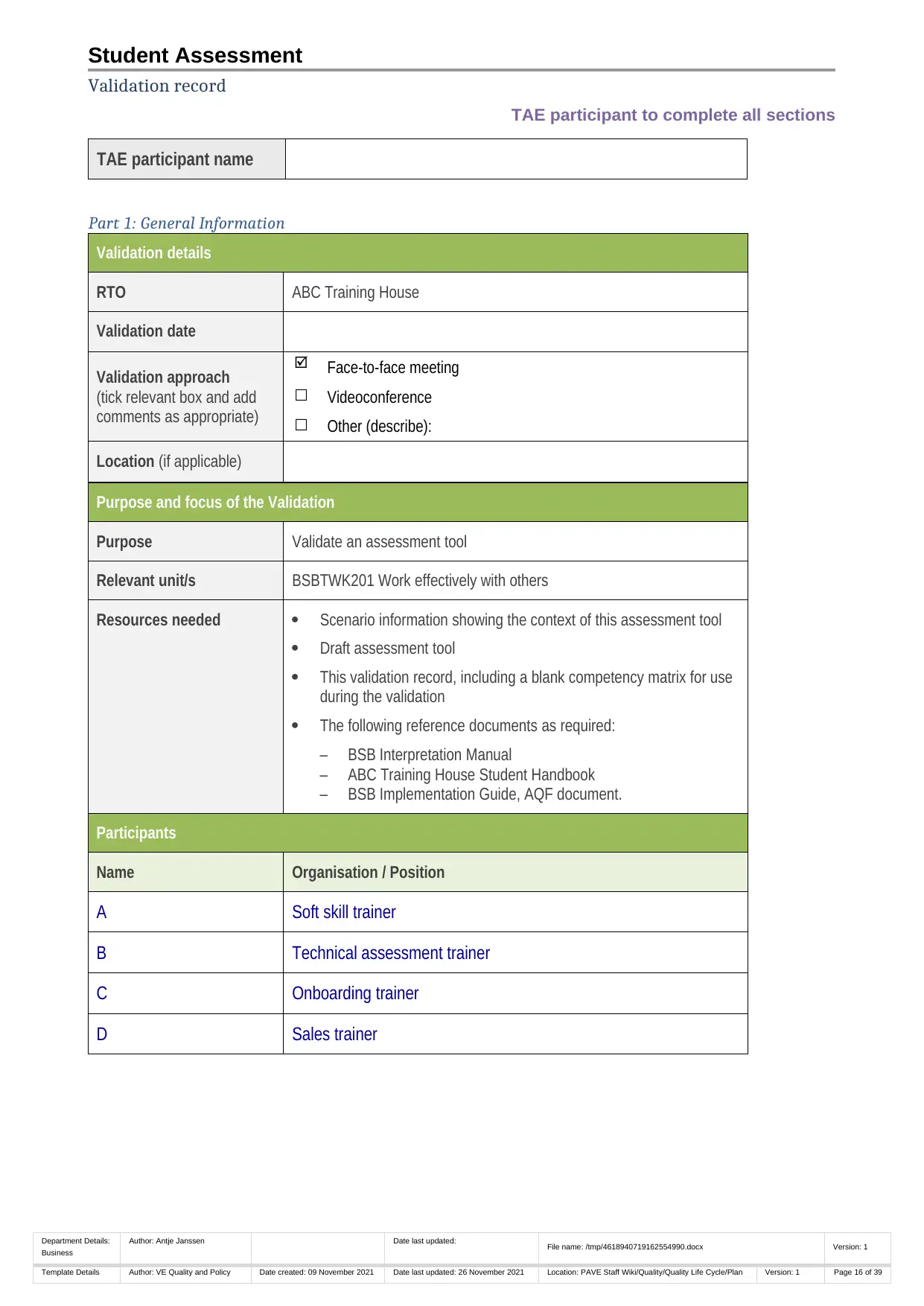
Student Assessment
Validation record
TAE participant to complete all sections
TAE participant name
Part 1: General Information
Validation details
RTO ABC Training House
Validation date
Validation approach
(tick relevant box and add
comments as appropriate)
Face-to-face meeting
☐ Videoconference
☐ Other (describe):
Location (if applicable)
Purpose and focus of the Validation
Purpose Validate an assessment tool
Relevant unit/s BSBTWK201 Work effectively with others
Resources needed Scenario information showing the context of this assessment tool
Draft assessment tool
This validation record, including a blank competency matrix for use
during the validation
The following reference documents as required:
– BSB Interpretation Manual
– ABC Training House Student Handbook
– BSB Implementation Guide, AQF document.
Participants
Name Organisation / Position
A Soft skill trainer
B Technical assessment trainer
C Onboarding trainer
D Sales trainer
Department Details:
Business
Author: Antje Janssen Date last updated: File name: /tmp/4618940719162554990.docx Version: 1
Template Details Author: VE Quality and Policy Date created: 09 November 2021 Date last updated: 26 November 2021 Location: PAVE Staff Wiki/Quality/Quality Life Cycle/Plan Version: 1 Page 16 of 39
Validation record
TAE participant to complete all sections
TAE participant name
Part 1: General Information
Validation details
RTO ABC Training House
Validation date
Validation approach
(tick relevant box and add
comments as appropriate)
Face-to-face meeting
☐ Videoconference
☐ Other (describe):
Location (if applicable)
Purpose and focus of the Validation
Purpose Validate an assessment tool
Relevant unit/s BSBTWK201 Work effectively with others
Resources needed Scenario information showing the context of this assessment tool
Draft assessment tool
This validation record, including a blank competency matrix for use
during the validation
The following reference documents as required:
– BSB Interpretation Manual
– ABC Training House Student Handbook
– BSB Implementation Guide, AQF document.
Participants
Name Organisation / Position
A Soft skill trainer
B Technical assessment trainer
C Onboarding trainer
D Sales trainer
Department Details:
Business
Author: Antje Janssen Date last updated: File name: /tmp/4618940719162554990.docx Version: 1
Template Details Author: VE Quality and Policy Date created: 09 November 2021 Date last updated: 26 November 2021 Location: PAVE Staff Wiki/Quality/Quality Life Cycle/Plan Version: 1 Page 16 of 39
Secure Best Marks with AI Grader
Need help grading? Try our AI Grader for instant feedback on your assignments.

Student Assessment
Part 2: Code of conduct
Participants in this validation acknowledge and agree that:
1. Be honest, respectful and open-minded
With the validation leader and with each other.
2. Equal ‘airtime’
Allow everyone to have their say without interruption.
3. Share diverse opinions—aim for consensus
4. Validation leader will decide the response to mixed feedback
In the event that validation participants have mixed feedback and do not reach consensus for a
particular validation criterion, the validation leader will note all feedback and make the final decision.
5. Copyright
Please respect copyright of the materials and templates used in the validation. All validation materials
are provided commercially, in confidence. Do not distribute them to others.
6. Confidentiality
You will be named as a participant in this validation, and this validation record will be openly available to
anyone with a valid reason to review it. Please advise the validation leader if you prefer to be identified
as ‘anonymous’ on this record.
Did all participants agree to these terms:
● verbally at the start of the validation meeting
● or by email beforehand?
Yes ☐ No (details below)
Department Details:
Business
Author: Antje Janssen Date last updated: File name: /tmp/4618940719162554990.docx Version: 1
Template Details Author: VE Quality and Policy Date created: 09 November 2021 Date last updated: 26 November 2021 Location: PAVE Staff Wiki/Quality/Quality Life Cycle/Plan Version: 1 Page 17 of 39
Part 2: Code of conduct
Participants in this validation acknowledge and agree that:
1. Be honest, respectful and open-minded
With the validation leader and with each other.
2. Equal ‘airtime’
Allow everyone to have their say without interruption.
3. Share diverse opinions—aim for consensus
4. Validation leader will decide the response to mixed feedback
In the event that validation participants have mixed feedback and do not reach consensus for a
particular validation criterion, the validation leader will note all feedback and make the final decision.
5. Copyright
Please respect copyright of the materials and templates used in the validation. All validation materials
are provided commercially, in confidence. Do not distribute them to others.
6. Confidentiality
You will be named as a participant in this validation, and this validation record will be openly available to
anyone with a valid reason to review it. Please advise the validation leader if you prefer to be identified
as ‘anonymous’ on this record.
Did all participants agree to these terms:
● verbally at the start of the validation meeting
● or by email beforehand?
Yes ☐ No (details below)
Department Details:
Business
Author: Antje Janssen Date last updated: File name: /tmp/4618940719162554990.docx Version: 1
Template Details Author: VE Quality and Policy Date created: 09 November 2021 Date last updated: 26 November 2021 Location: PAVE Staff Wiki/Quality/Quality Life Cycle/Plan Version: 1 Page 17 of 39
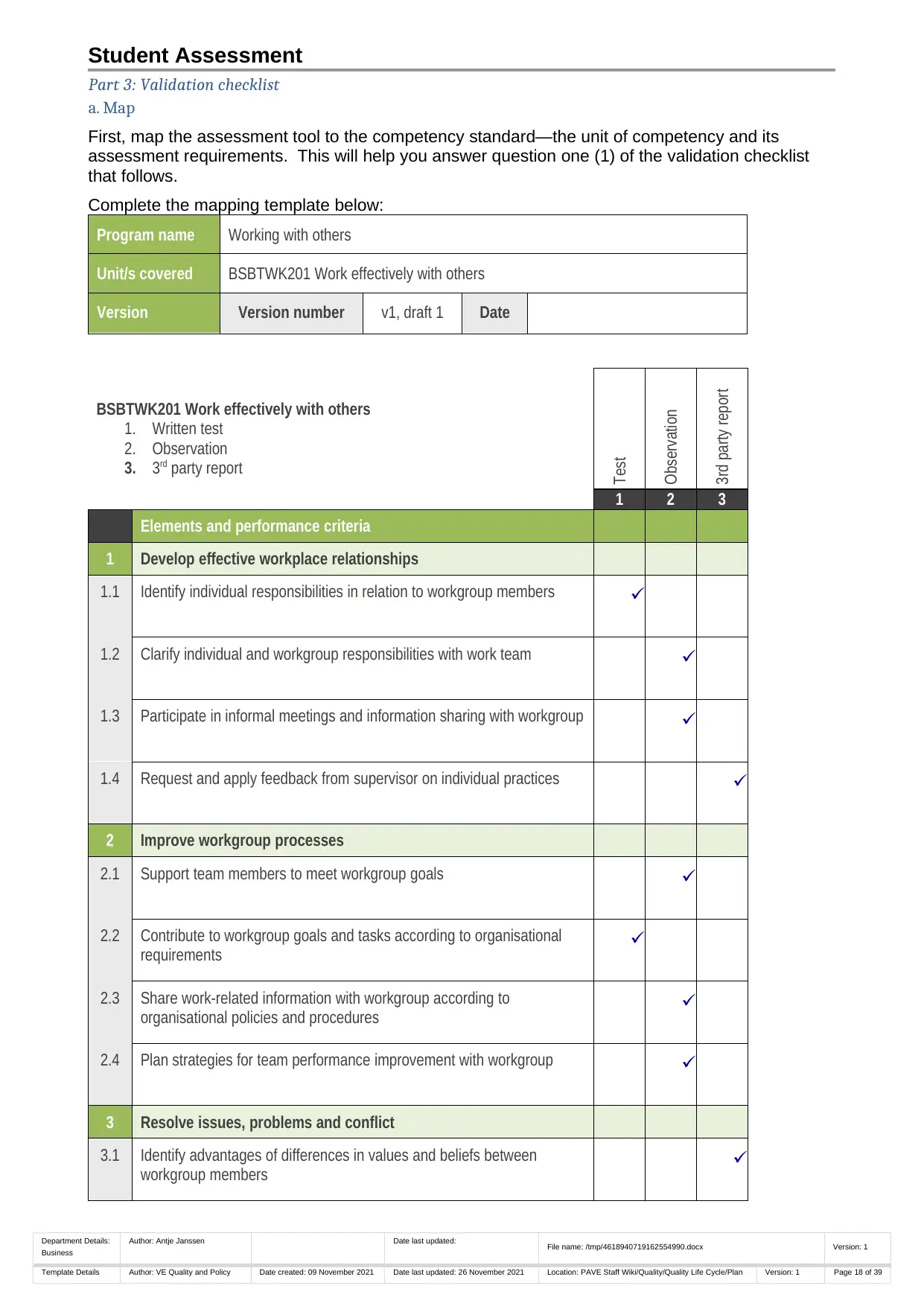
Student Assessment
Part 3: Validation checklist
a. Map
First, map the assessment tool to the competency standard—the unit of competency and its
assessment requirements. This will help you answer question one (1) of the validation checklist
that follows.
Complete the mapping template below:
Program name Working with others
Unit/s covered BSBTWK201 Work effectively with others
Version Version number v1, draft 1 Date
BSBTWK201 Work effectively with others
1. Written test
2. Observation
3. 3rd party report
Test
Observation
3rd party report
1 2 3
Elements and performance criteria
1 Develop effective workplace relationships
1.1 Identify individual responsibilities in relation to workgroup members
1.2 Clarify individual and workgroup responsibilities with work team
1.3 Participate in informal meetings and information sharing with workgroup
1.4 Request and apply feedback from supervisor on individual practices
2 Improve workgroup processes
2.1 Support team members to meet workgroup goals
2.2 Contribute to workgroup goals and tasks according to organisational
requirements
2.3 Share work-related information with workgroup according to
organisational policies and procedures
2.4 Plan strategies for team performance improvement with workgroup
3 Resolve issues, problems and conflict
3.1 Identify advantages of differences in values and beliefs between
workgroup members
Department Details:
Business
Author: Antje Janssen Date last updated: File name: /tmp/4618940719162554990.docx Version: 1
Template Details Author: VE Quality and Policy Date created: 09 November 2021 Date last updated: 26 November 2021 Location: PAVE Staff Wiki/Quality/Quality Life Cycle/Plan Version: 1 Page 18 of 39
Part 3: Validation checklist
a. Map
First, map the assessment tool to the competency standard—the unit of competency and its
assessment requirements. This will help you answer question one (1) of the validation checklist
that follows.
Complete the mapping template below:
Program name Working with others
Unit/s covered BSBTWK201 Work effectively with others
Version Version number v1, draft 1 Date
BSBTWK201 Work effectively with others
1. Written test
2. Observation
3. 3rd party report
Test
Observation
3rd party report
1 2 3
Elements and performance criteria
1 Develop effective workplace relationships
1.1 Identify individual responsibilities in relation to workgroup members
1.2 Clarify individual and workgroup responsibilities with work team
1.3 Participate in informal meetings and information sharing with workgroup
1.4 Request and apply feedback from supervisor on individual practices
2 Improve workgroup processes
2.1 Support team members to meet workgroup goals
2.2 Contribute to workgroup goals and tasks according to organisational
requirements
2.3 Share work-related information with workgroup according to
organisational policies and procedures
2.4 Plan strategies for team performance improvement with workgroup
3 Resolve issues, problems and conflict
3.1 Identify advantages of differences in values and beliefs between
workgroup members
Department Details:
Business
Author: Antje Janssen Date last updated: File name: /tmp/4618940719162554990.docx Version: 1
Template Details Author: VE Quality and Policy Date created: 09 November 2021 Date last updated: 26 November 2021 Location: PAVE Staff Wiki/Quality/Quality Life Cycle/Plan Version: 1 Page 18 of 39
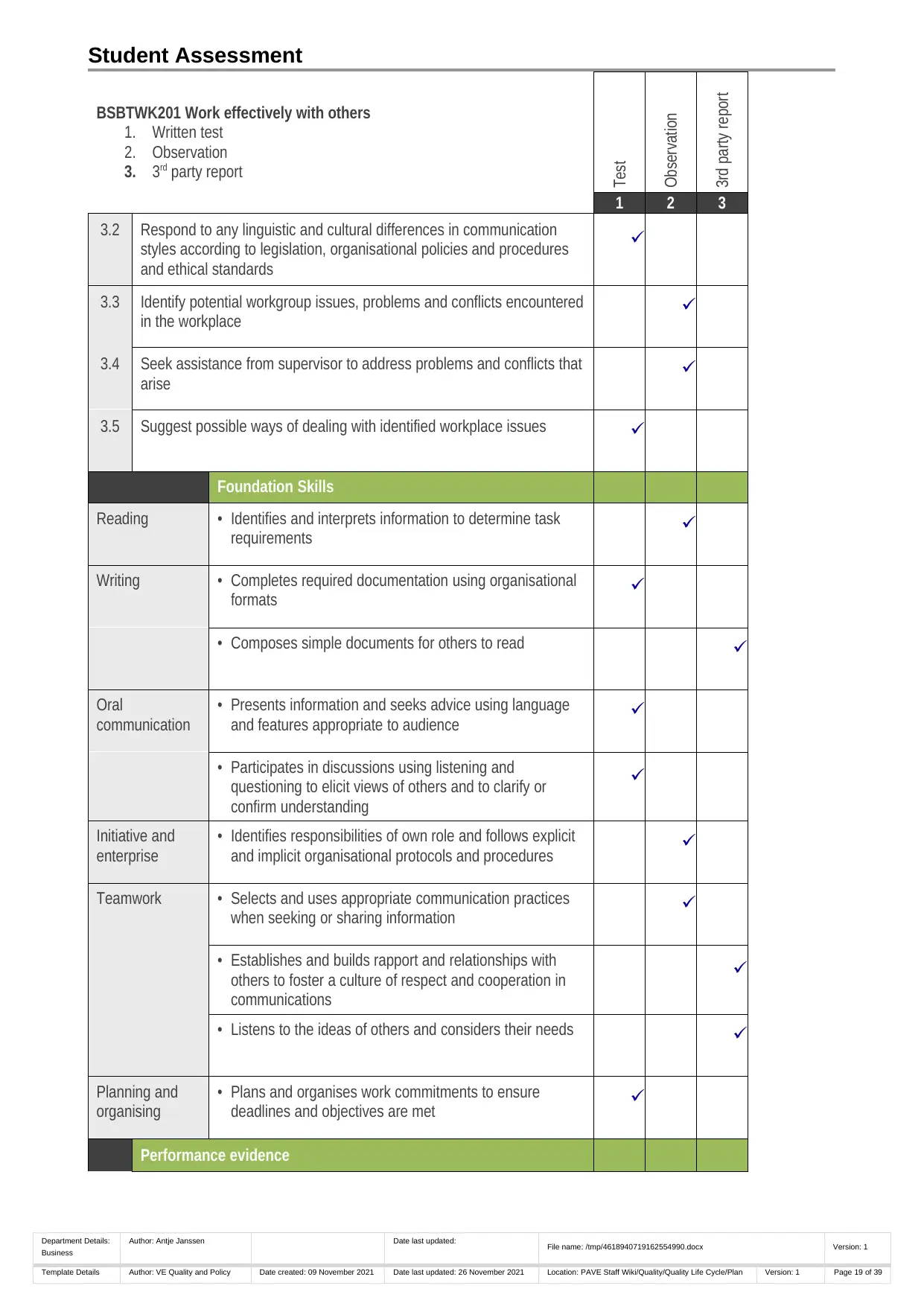
Student Assessment
BSBTWK201 Work effectively with others
1. Written test
2. Observation
3. 3rd party report
Test
Observation
3rd party report
1 2 3
3.2 Respond to any linguistic and cultural differences in communication
styles according to legislation, organisational policies and procedures
and ethical standards
3.3 Identify potential workgroup issues, problems and conflicts encountered
in the workplace
3.4 Seek assistance from supervisor to address problems and conflicts that
arise
3.5 Suggest possible ways of dealing with identified workplace issues
Foundation Skills
Reading • Identifies and interprets information to determine task
requirements
Writing • Completes required documentation using organisational
formats
• Composes simple documents for others to read
Oral
communication
• Presents information and seeks advice using language
and features appropriate to audience
• Participates in discussions using listening and
questioning to elicit views of others and to clarify or
confirm understanding
Initiative and
enterprise
• Identifies responsibilities of own role and follows explicit
and implicit organisational protocols and procedures
Teamwork • Selects and uses appropriate communication practices
when seeking or sharing information
• Establishes and builds rapport and relationships with
others to foster a culture of respect and cooperation in
communications
• Listens to the ideas of others and considers their needs
Planning and
organising
• Plans and organises work commitments to ensure
deadlines and objectives are met
Performance evidence
Department Details:
Business
Author: Antje Janssen Date last updated: File name: /tmp/4618940719162554990.docx Version: 1
Template Details Author: VE Quality and Policy Date created: 09 November 2021 Date last updated: 26 November 2021 Location: PAVE Staff Wiki/Quality/Quality Life Cycle/Plan Version: 1 Page 19 of 39
BSBTWK201 Work effectively with others
1. Written test
2. Observation
3. 3rd party report
Test
Observation
3rd party report
1 2 3
3.2 Respond to any linguistic and cultural differences in communication
styles according to legislation, organisational policies and procedures
and ethical standards
3.3 Identify potential workgroup issues, problems and conflicts encountered
in the workplace
3.4 Seek assistance from supervisor to address problems and conflicts that
arise
3.5 Suggest possible ways of dealing with identified workplace issues
Foundation Skills
Reading • Identifies and interprets information to determine task
requirements
Writing • Completes required documentation using organisational
formats
• Composes simple documents for others to read
Oral
communication
• Presents information and seeks advice using language
and features appropriate to audience
• Participates in discussions using listening and
questioning to elicit views of others and to clarify or
confirm understanding
Initiative and
enterprise
• Identifies responsibilities of own role and follows explicit
and implicit organisational protocols and procedures
Teamwork • Selects and uses appropriate communication practices
when seeking or sharing information
• Establishes and builds rapport and relationships with
others to foster a culture of respect and cooperation in
communications
• Listens to the ideas of others and considers their needs
Planning and
organising
• Plans and organises work commitments to ensure
deadlines and objectives are met
Performance evidence
Department Details:
Business
Author: Antje Janssen Date last updated: File name: /tmp/4618940719162554990.docx Version: 1
Template Details Author: VE Quality and Policy Date created: 09 November 2021 Date last updated: 26 November 2021 Location: PAVE Staff Wiki/Quality/Quality Life Cycle/Plan Version: 1 Page 19 of 39
Paraphrase This Document
Need a fresh take? Get an instant paraphrase of this document with our AI Paraphraser
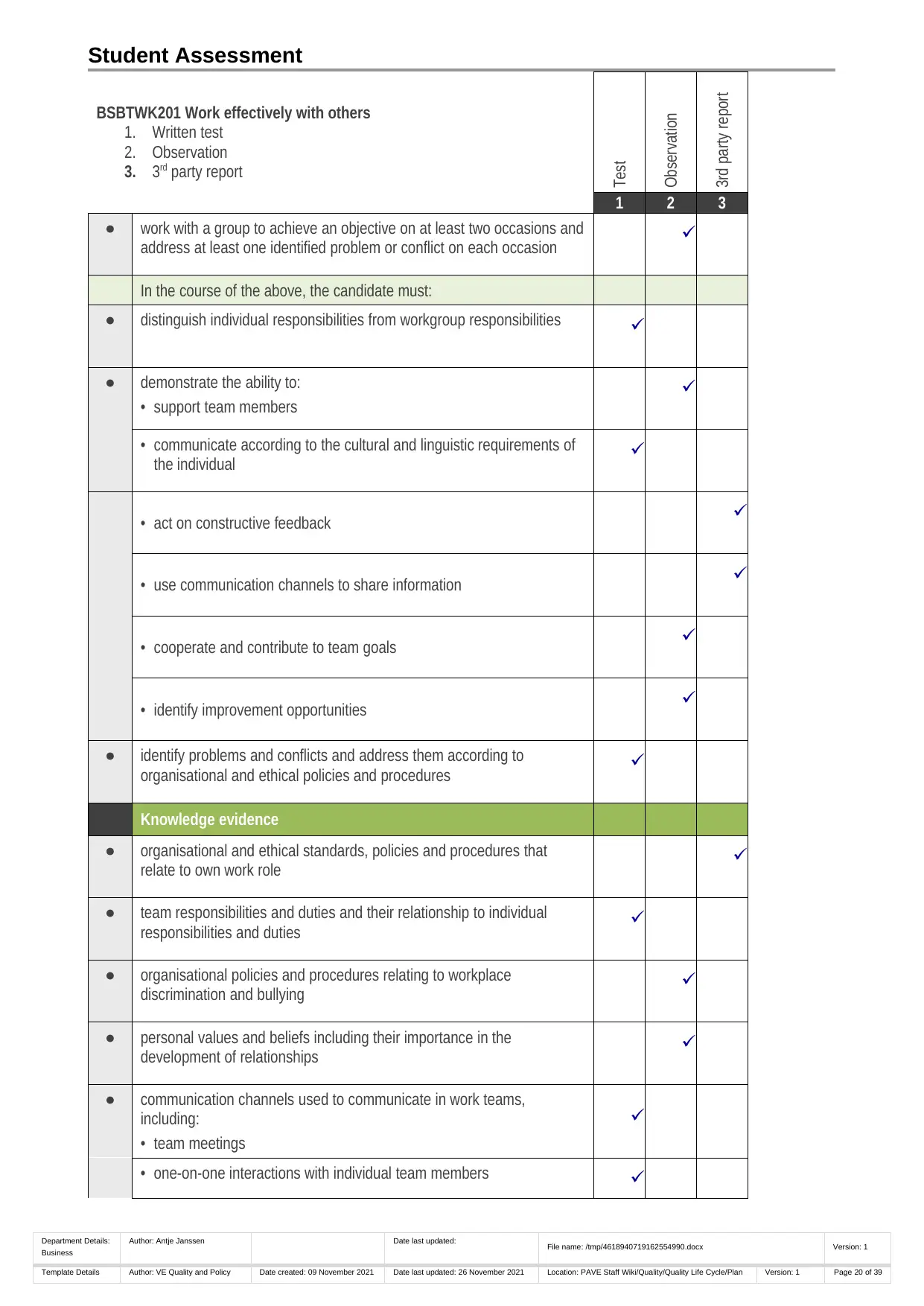
Student Assessment
BSBTWK201 Work effectively with others
1. Written test
2. Observation
3. 3rd party report
Test
Observation
3rd party report
1 2 3
● work with a group to achieve an objective on at least two occasions and
address at least one identified problem or conflict on each occasion
In the course of the above, the candidate must:
● distinguish individual responsibilities from workgroup responsibilities
● demonstrate the ability to:
• support team members
• communicate according to the cultural and linguistic requirements of
the individual
• act on constructive feedback
• use communication channels to share information
• cooperate and contribute to team goals
• identify improvement opportunities
● identify problems and conflicts and address them according to
organisational and ethical policies and procedures
Knowledge evidence
● organisational and ethical standards, policies and procedures that
relate to own work role
● team responsibilities and duties and their relationship to individual
responsibilities and duties
● organisational policies and procedures relating to workplace
discrimination and bullying
● personal values and beliefs including their importance in the
development of relationships
● communication channels used to communicate in work teams,
including:
• team meetings
• one-on-one interactions with individual team members
Department Details:
Business
Author: Antje Janssen Date last updated: File name: /tmp/4618940719162554990.docx Version: 1
Template Details Author: VE Quality and Policy Date created: 09 November 2021 Date last updated: 26 November 2021 Location: PAVE Staff Wiki/Quality/Quality Life Cycle/Plan Version: 1 Page 20 of 39
BSBTWK201 Work effectively with others
1. Written test
2. Observation
3. 3rd party report
Test
Observation
3rd party report
1 2 3
● work with a group to achieve an objective on at least two occasions and
address at least one identified problem or conflict on each occasion
In the course of the above, the candidate must:
● distinguish individual responsibilities from workgroup responsibilities
● demonstrate the ability to:
• support team members
• communicate according to the cultural and linguistic requirements of
the individual
• act on constructive feedback
• use communication channels to share information
• cooperate and contribute to team goals
• identify improvement opportunities
● identify problems and conflicts and address them according to
organisational and ethical policies and procedures
Knowledge evidence
● organisational and ethical standards, policies and procedures that
relate to own work role
● team responsibilities and duties and their relationship to individual
responsibilities and duties
● organisational policies and procedures relating to workplace
discrimination and bullying
● personal values and beliefs including their importance in the
development of relationships
● communication channels used to communicate in work teams,
including:
• team meetings
• one-on-one interactions with individual team members
Department Details:
Business
Author: Antje Janssen Date last updated: File name: /tmp/4618940719162554990.docx Version: 1
Template Details Author: VE Quality and Policy Date created: 09 November 2021 Date last updated: 26 November 2021 Location: PAVE Staff Wiki/Quality/Quality Life Cycle/Plan Version: 1 Page 20 of 39

Student Assessment
BSBTWK201 Work effectively with others
1. Written test
2. Observation
3. 3rd party report
Test
Observation
3rd party report
1 2 3
• emails
• instant messaging
• calls
● key problems and conflicts arising in workgroup contexts
● methods of resolving team problems including referral to relevant
organisational personnel
● conflict resolution techniques
Department Details:
Business
Author: Antje Janssen Date last updated: File name: /tmp/4618940719162554990.docx Version: 1
Template Details Author: VE Quality and Policy Date created: 09 November 2021 Date last updated: 26 November 2021 Location: PAVE Staff Wiki/Quality/Quality Life Cycle/Plan Version: 1 Page 21 of 39
BSBTWK201 Work effectively with others
1. Written test
2. Observation
3. 3rd party report
Test
Observation
3rd party report
1 2 3
• emails
• instant messaging
• calls
● key problems and conflicts arising in workgroup contexts
● methods of resolving team problems including referral to relevant
organisational personnel
● conflict resolution techniques
Department Details:
Business
Author: Antje Janssen Date last updated: File name: /tmp/4618940719162554990.docx Version: 1
Template Details Author: VE Quality and Policy Date created: 09 November 2021 Date last updated: 26 November 2021 Location: PAVE Staff Wiki/Quality/Quality Life Cycle/Plan Version: 1 Page 21 of 39
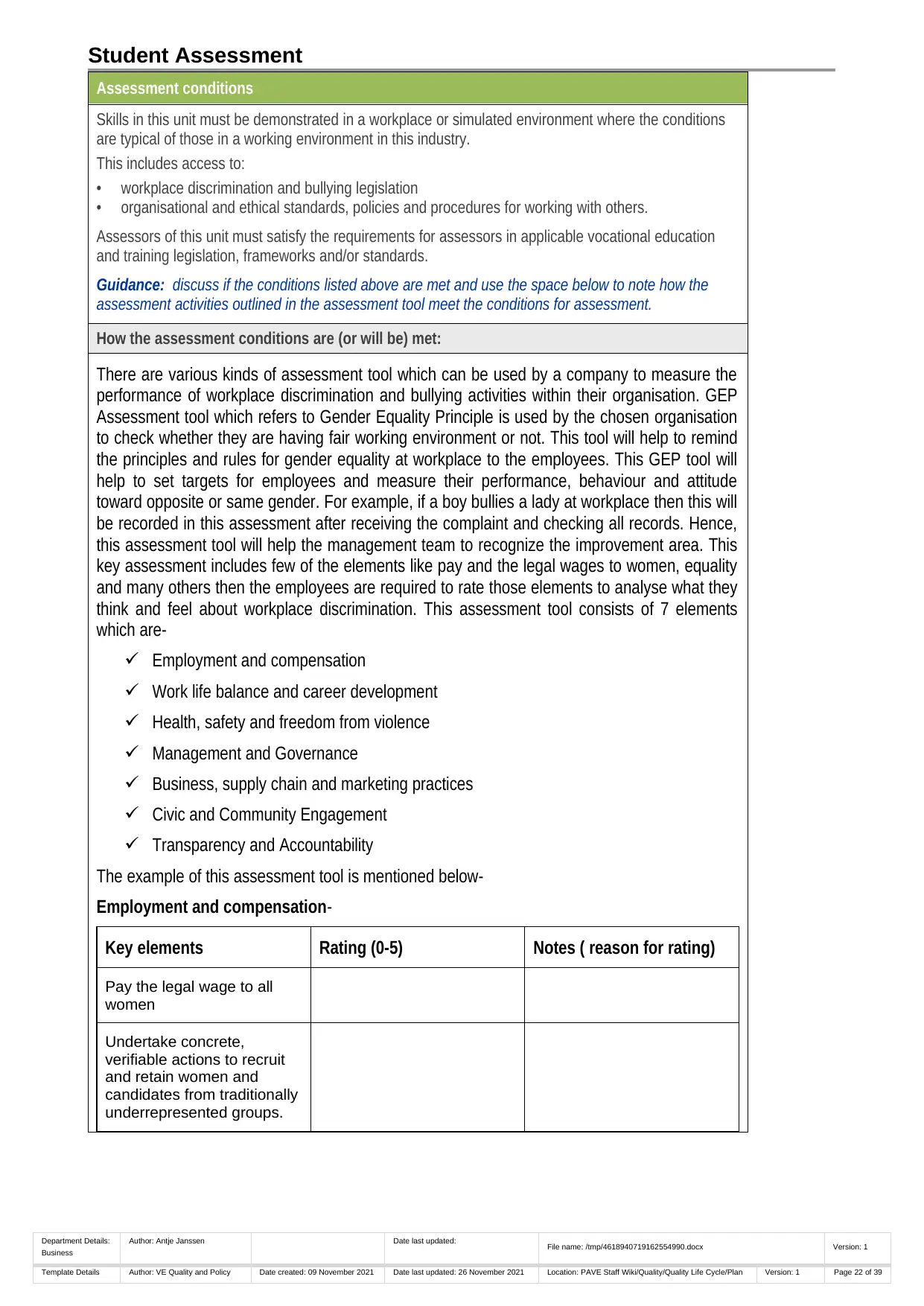
Student Assessment
Assessment conditions
Skills in this unit must be demonstrated in a workplace or simulated environment where the conditions
are typical of those in a working environment in this industry.
This includes access to:
• workplace discrimination and bullying legislation
• organisational and ethical standards, policies and procedures for working with others.
Assessors of this unit must satisfy the requirements for assessors in applicable vocational education
and training legislation, frameworks and/or standards.
Guidance: discuss if the conditions listed above are met and use the space below to note how the
assessment activities outlined in the assessment tool meet the conditions for assessment.
How the assessment conditions are (or will be) met:
There are various kinds of assessment tool which can be used by a company to measure the
performance of workplace discrimination and bullying activities within their organisation. GEP
Assessment tool which refers to Gender Equality Principle is used by the chosen organisation
to check whether they are having fair working environment or not. This tool will help to remind
the principles and rules for gender equality at workplace to the employees. This GEP tool will
help to set targets for employees and measure their performance, behaviour and attitude
toward opposite or same gender. For example, if a boy bullies a lady at workplace then this will
be recorded in this assessment after receiving the complaint and checking all records. Hence,
this assessment tool will help the management team to recognize the improvement area. This
key assessment includes few of the elements like pay and the legal wages to women, equality
and many others then the employees are required to rate those elements to analyse what they
think and feel about workplace discrimination. This assessment tool consists of 7 elements
which are-
Employment and compensation
Work life balance and career development
Health, safety and freedom from violence
Management and Governance
Business, supply chain and marketing practices
Civic and Community Engagement
Transparency and Accountability
The example of this assessment tool is mentioned below-
Employment and compensation-
Key elements Rating (0-5) Notes ( reason for rating)
Pay the legal wage to all
women
Undertake concrete,
verifiable actions to recruit
and retain women and
candidates from traditionally
underrepresented groups.
Department Details:
Business
Author: Antje Janssen Date last updated: File name: /tmp/4618940719162554990.docx Version: 1
Template Details Author: VE Quality and Policy Date created: 09 November 2021 Date last updated: 26 November 2021 Location: PAVE Staff Wiki/Quality/Quality Life Cycle/Plan Version: 1 Page 22 of 39
Assessment conditions
Skills in this unit must be demonstrated in a workplace or simulated environment where the conditions
are typical of those in a working environment in this industry.
This includes access to:
• workplace discrimination and bullying legislation
• organisational and ethical standards, policies and procedures for working with others.
Assessors of this unit must satisfy the requirements for assessors in applicable vocational education
and training legislation, frameworks and/or standards.
Guidance: discuss if the conditions listed above are met and use the space below to note how the
assessment activities outlined in the assessment tool meet the conditions for assessment.
How the assessment conditions are (or will be) met:
There are various kinds of assessment tool which can be used by a company to measure the
performance of workplace discrimination and bullying activities within their organisation. GEP
Assessment tool which refers to Gender Equality Principle is used by the chosen organisation
to check whether they are having fair working environment or not. This tool will help to remind
the principles and rules for gender equality at workplace to the employees. This GEP tool will
help to set targets for employees and measure their performance, behaviour and attitude
toward opposite or same gender. For example, if a boy bullies a lady at workplace then this will
be recorded in this assessment after receiving the complaint and checking all records. Hence,
this assessment tool will help the management team to recognize the improvement area. This
key assessment includes few of the elements like pay and the legal wages to women, equality
and many others then the employees are required to rate those elements to analyse what they
think and feel about workplace discrimination. This assessment tool consists of 7 elements
which are-
Employment and compensation
Work life balance and career development
Health, safety and freedom from violence
Management and Governance
Business, supply chain and marketing practices
Civic and Community Engagement
Transparency and Accountability
The example of this assessment tool is mentioned below-
Employment and compensation-
Key elements Rating (0-5) Notes ( reason for rating)
Pay the legal wage to all
women
Undertake concrete,
verifiable actions to recruit
and retain women and
candidates from traditionally
underrepresented groups.
Department Details:
Business
Author: Antje Janssen Date last updated: File name: /tmp/4618940719162554990.docx Version: 1
Template Details Author: VE Quality and Policy Date created: 09 November 2021 Date last updated: 26 November 2021 Location: PAVE Staff Wiki/Quality/Quality Life Cycle/Plan Version: 1 Page 22 of 39
Secure Best Marks with AI Grader
Need help grading? Try our AI Grader for instant feedback on your assignments.
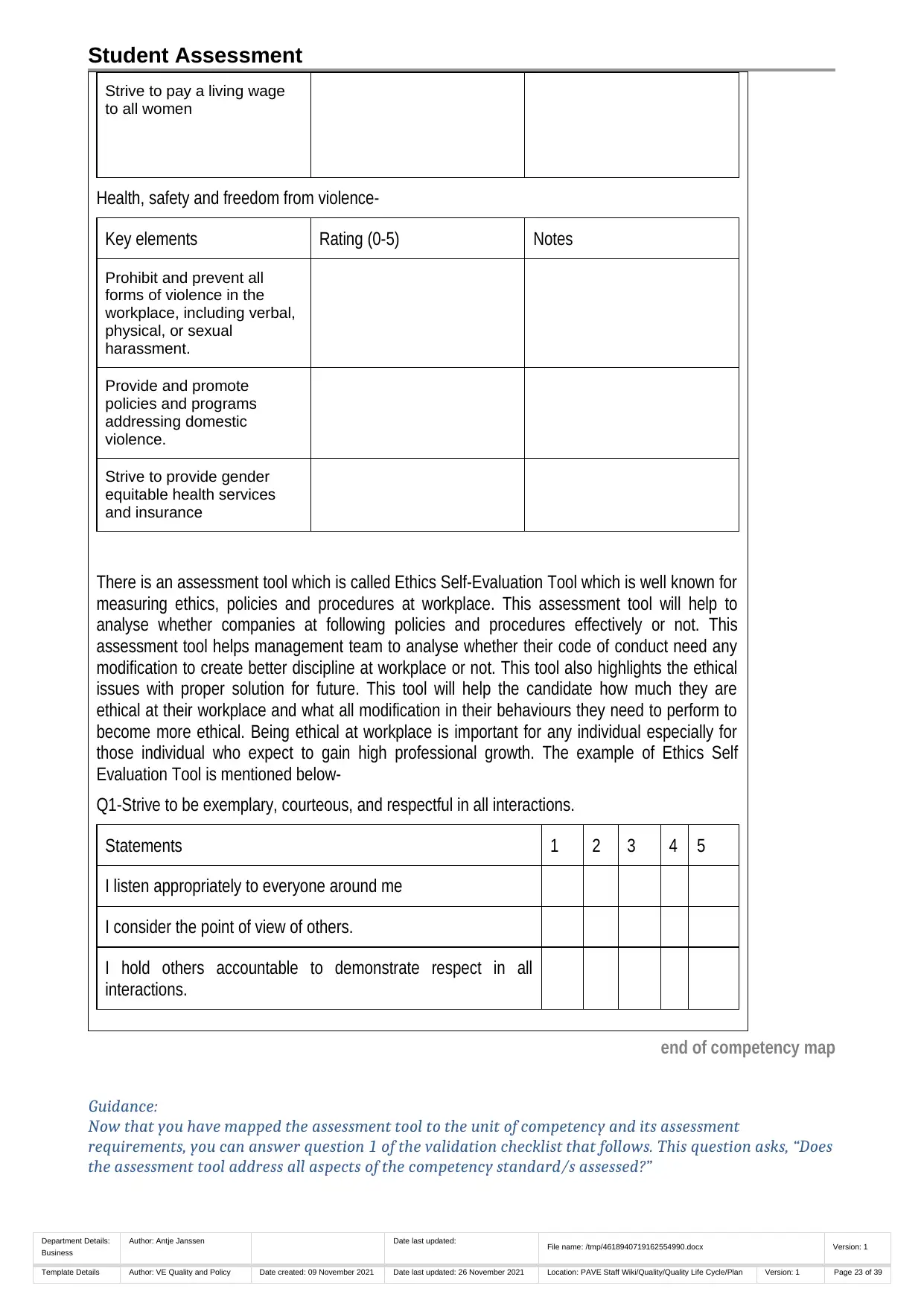
Student Assessment
Strive to pay a living wage
to all women
Health, safety and freedom from violence-
Key elements Rating (0-5) Notes
Prohibit and prevent all
forms of violence in the
workplace, including verbal,
physical, or sexual
harassment.
Provide and promote
policies and programs
addressing domestic
violence.
Strive to provide gender
equitable health services
and insurance
There is an assessment tool which is called Ethics Self-Evaluation Tool which is well known for
measuring ethics, policies and procedures at workplace. This assessment tool will help to
analyse whether companies at following policies and procedures effectively or not. This
assessment tool helps management team to analyse whether their code of conduct need any
modification to create better discipline at workplace or not. This tool also highlights the ethical
issues with proper solution for future. This tool will help the candidate how much they are
ethical at their workplace and what all modification in their behaviours they need to perform to
become more ethical. Being ethical at workplace is important for any individual especially for
those individual who expect to gain high professional growth. The example of Ethics Self
Evaluation Tool is mentioned below-
Q1-Strive to be exemplary, courteous, and respectful in all interactions.
Statements 1 2 3 4 5
I listen appropriately to everyone around me
I consider the point of view of others.
I hold others accountable to demonstrate respect in all
interactions.
end of competency map
Guidance:
Now that you have mapped the assessment tool to the unit of competency and its assessment
requirements, you can answer question 1 of the validation checklist that follows. This question asks, “Does
the assessment tool address all aspects of the competency standard/s assessed?”
Department Details:
Business
Author: Antje Janssen Date last updated: File name: /tmp/4618940719162554990.docx Version: 1
Template Details Author: VE Quality and Policy Date created: 09 November 2021 Date last updated: 26 November 2021 Location: PAVE Staff Wiki/Quality/Quality Life Cycle/Plan Version: 1 Page 23 of 39
Strive to pay a living wage
to all women
Health, safety and freedom from violence-
Key elements Rating (0-5) Notes
Prohibit and prevent all
forms of violence in the
workplace, including verbal,
physical, or sexual
harassment.
Provide and promote
policies and programs
addressing domestic
violence.
Strive to provide gender
equitable health services
and insurance
There is an assessment tool which is called Ethics Self-Evaluation Tool which is well known for
measuring ethics, policies and procedures at workplace. This assessment tool will help to
analyse whether companies at following policies and procedures effectively or not. This
assessment tool helps management team to analyse whether their code of conduct need any
modification to create better discipline at workplace or not. This tool also highlights the ethical
issues with proper solution for future. This tool will help the candidate how much they are
ethical at their workplace and what all modification in their behaviours they need to perform to
become more ethical. Being ethical at workplace is important for any individual especially for
those individual who expect to gain high professional growth. The example of Ethics Self
Evaluation Tool is mentioned below-
Q1-Strive to be exemplary, courteous, and respectful in all interactions.
Statements 1 2 3 4 5
I listen appropriately to everyone around me
I consider the point of view of others.
I hold others accountable to demonstrate respect in all
interactions.
end of competency map
Guidance:
Now that you have mapped the assessment tool to the unit of competency and its assessment
requirements, you can answer question 1 of the validation checklist that follows. This question asks, “Does
the assessment tool address all aspects of the competency standard/s assessed?”
Department Details:
Business
Author: Antje Janssen Date last updated: File name: /tmp/4618940719162554990.docx Version: 1
Template Details Author: VE Quality and Policy Date created: 09 November 2021 Date last updated: 26 November 2021 Location: PAVE Staff Wiki/Quality/Quality Life Cycle/Plan Version: 1 Page 23 of 39

Student Assessment
Department Details:
Business
Author: Antje Janssen Date last updated: File name: /tmp/4618940719162554990.docx Version: 1
Template Details Author: VE Quality and Policy Date created: 09 November 2021 Date last updated: 26 November 2021 Location: PAVE Staff Wiki/Quality/Quality Life Cycle/Plan Version: 1 Page 24 of 39
Department Details:
Business
Author: Antje Janssen Date last updated: File name: /tmp/4618940719162554990.docx Version: 1
Template Details Author: VE Quality and Policy Date created: 09 November 2021 Date last updated: 26 November 2021 Location: PAVE Staff Wiki/Quality/Quality Life Cycle/Plan Version: 1 Page 24 of 39
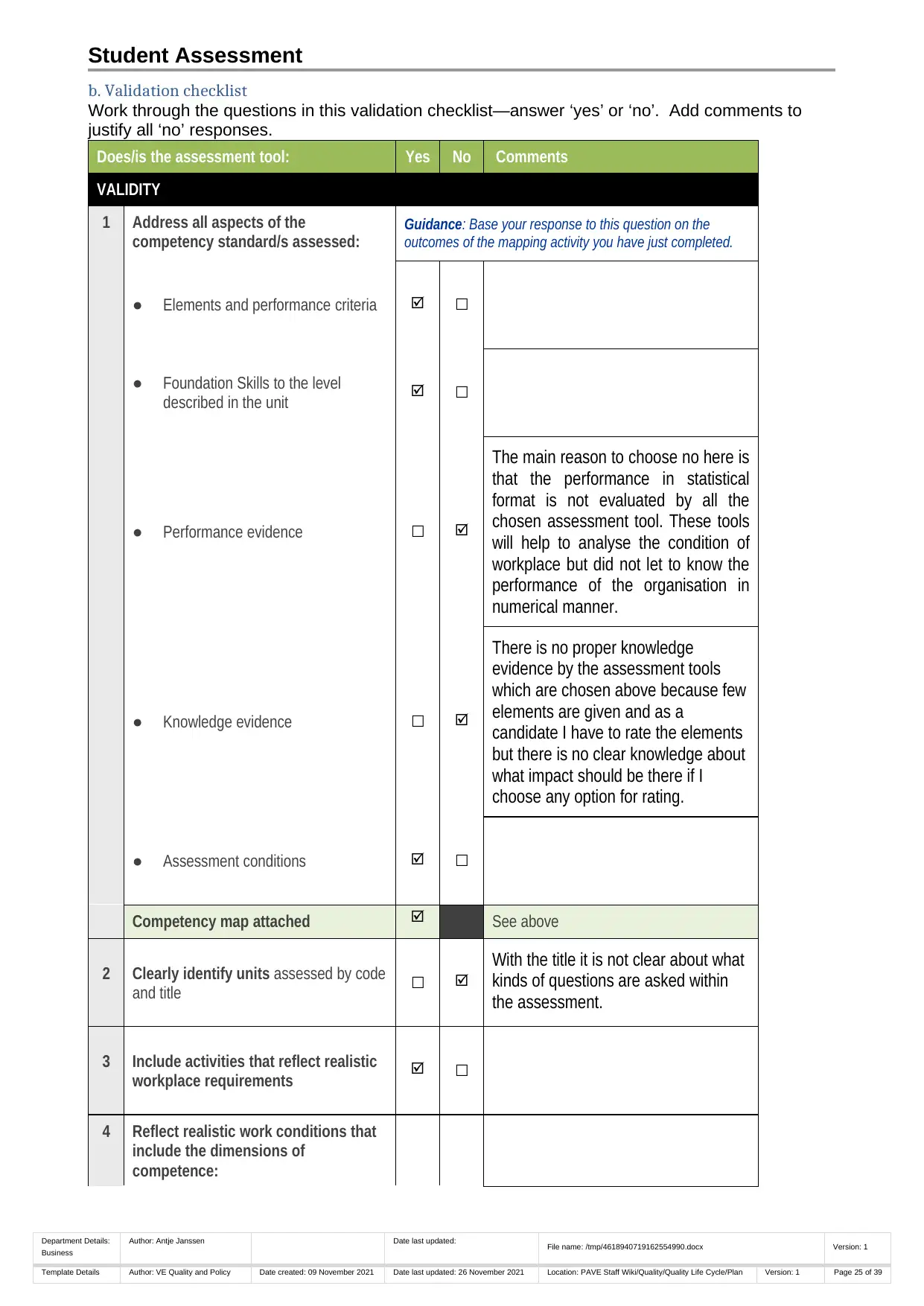
Student Assessment
b. Validation checklist
Work through the questions in this validation checklist—answer ‘yes’ or ‘no’. Add comments to
justify all ‘no’ responses.
Does/is the assessment tool: Yes No Comments
VALIDITY
1 Address all aspects of the
competency standard/s assessed:
Guidance: Base your response to this question on the
outcomes of the mapping activity you have just completed.
● Elements and performance criteria ☐
● Foundation Skills to the level
described in the unit ☐
● Performance evidence ☐
The main reason to choose no here is
that the performance in statistical
format is not evaluated by all the
chosen assessment tool. These tools
will help to analyse the condition of
workplace but did not let to know the
performance of the organisation in
numerical manner.
● Knowledge evidence ☐
There is no proper knowledge
evidence by the assessment tools
which are chosen above because few
elements are given and as a
candidate I have to rate the elements
but there is no clear knowledge about
what impact should be there if I
choose any option for rating.
● Assessment conditions ☐
Competency map attached See above
2 Clearly identify units assessed by code
and title ☐
With the title it is not clear about what
kinds of questions are asked within
the assessment.
3 Include activities that reflect realistic
workplace requirements ☐
4 Reflect realistic work conditions that
include the dimensions of
competence:
Department Details:
Business
Author: Antje Janssen Date last updated: File name: /tmp/4618940719162554990.docx Version: 1
Template Details Author: VE Quality and Policy Date created: 09 November 2021 Date last updated: 26 November 2021 Location: PAVE Staff Wiki/Quality/Quality Life Cycle/Plan Version: 1 Page 25 of 39
b. Validation checklist
Work through the questions in this validation checklist—answer ‘yes’ or ‘no’. Add comments to
justify all ‘no’ responses.
Does/is the assessment tool: Yes No Comments
VALIDITY
1 Address all aspects of the
competency standard/s assessed:
Guidance: Base your response to this question on the
outcomes of the mapping activity you have just completed.
● Elements and performance criteria ☐
● Foundation Skills to the level
described in the unit ☐
● Performance evidence ☐
The main reason to choose no here is
that the performance in statistical
format is not evaluated by all the
chosen assessment tool. These tools
will help to analyse the condition of
workplace but did not let to know the
performance of the organisation in
numerical manner.
● Knowledge evidence ☐
There is no proper knowledge
evidence by the assessment tools
which are chosen above because few
elements are given and as a
candidate I have to rate the elements
but there is no clear knowledge about
what impact should be there if I
choose any option for rating.
● Assessment conditions ☐
Competency map attached See above
2 Clearly identify units assessed by code
and title ☐
With the title it is not clear about what
kinds of questions are asked within
the assessment.
3 Include activities that reflect realistic
workplace requirements ☐
4 Reflect realistic work conditions that
include the dimensions of
competence:
Department Details:
Business
Author: Antje Janssen Date last updated: File name: /tmp/4618940719162554990.docx Version: 1
Template Details Author: VE Quality and Policy Date created: 09 November 2021 Date last updated: 26 November 2021 Location: PAVE Staff Wiki/Quality/Quality Life Cycle/Plan Version: 1 Page 25 of 39
Paraphrase This Document
Need a fresh take? Get an instant paraphrase of this document with our AI Paraphraser

Student Assessment
Does/is the assessment tool: Yes No Comments
● Task skills ☐
● Task management skills ☐
● Contingency management skills ☐
● Job / role environment skills ☐
5 Promote collection of evidence that
is: The chosen assessment tools are not
considered as sufficient because they
did not include in depth reason for
ratings of different elements. On the
other hand, there is no guarantee for
authenticity of the assessment
because it might be possible that the
candidate may choose wrong answer
to finish the assessment as soon as
possible which is done most of the
time with candidates.
● Valid ☐
● Sufficient ☐
● Current ☐
● Authentic ☐
6 Pitched at the correct AQF level ☐
7 Free of unnecessary assessment
tasks ☐
It’s not compulsory that the
assessment will be conducted as per
the candidate’s interest and will.
There are few of the assessments
which are far from candidate’s interest
area.
FLEXIBILITY AND FAIRNESS
8 Offer a reasonable range of flexible
options for how candidates complete
and submit assessment tasks
☐
Because only few options are given to
candidates and they are required to
choose from that options.
9 Include information about available
support and guidance if needed ☐
RELIABILITY
10 Formatted and structured in a logical
and easy-to-follow way ☐
11 Include information, instructions and
marking guide for assessors that
includes:
● clear instructions for administering
the assessment—Plain English and
concise
☐
● complete instructions for ☐
Department Details:
Business
Author: Antje Janssen Date last updated: File name: /tmp/4618940719162554990.docx Version: 1
Template Details Author: VE Quality and Policy Date created: 09 November 2021 Date last updated: 26 November 2021 Location: PAVE Staff Wiki/Quality/Quality Life Cycle/Plan Version: 1 Page 26 of 39
Does/is the assessment tool: Yes No Comments
● Task skills ☐
● Task management skills ☐
● Contingency management skills ☐
● Job / role environment skills ☐
5 Promote collection of evidence that
is: The chosen assessment tools are not
considered as sufficient because they
did not include in depth reason for
ratings of different elements. On the
other hand, there is no guarantee for
authenticity of the assessment
because it might be possible that the
candidate may choose wrong answer
to finish the assessment as soon as
possible which is done most of the
time with candidates.
● Valid ☐
● Sufficient ☐
● Current ☐
● Authentic ☐
6 Pitched at the correct AQF level ☐
7 Free of unnecessary assessment
tasks ☐
It’s not compulsory that the
assessment will be conducted as per
the candidate’s interest and will.
There are few of the assessments
which are far from candidate’s interest
area.
FLEXIBILITY AND FAIRNESS
8 Offer a reasonable range of flexible
options for how candidates complete
and submit assessment tasks
☐
Because only few options are given to
candidates and they are required to
choose from that options.
9 Include information about available
support and guidance if needed ☐
RELIABILITY
10 Formatted and structured in a logical
and easy-to-follow way ☐
11 Include information, instructions and
marking guide for assessors that
includes:
● clear instructions for administering
the assessment—Plain English and
concise
☐
● complete instructions for ☐
Department Details:
Business
Author: Antje Janssen Date last updated: File name: /tmp/4618940719162554990.docx Version: 1
Template Details Author: VE Quality and Policy Date created: 09 November 2021 Date last updated: 26 November 2021 Location: PAVE Staff Wiki/Quality/Quality Life Cycle/Plan Version: 1 Page 26 of 39
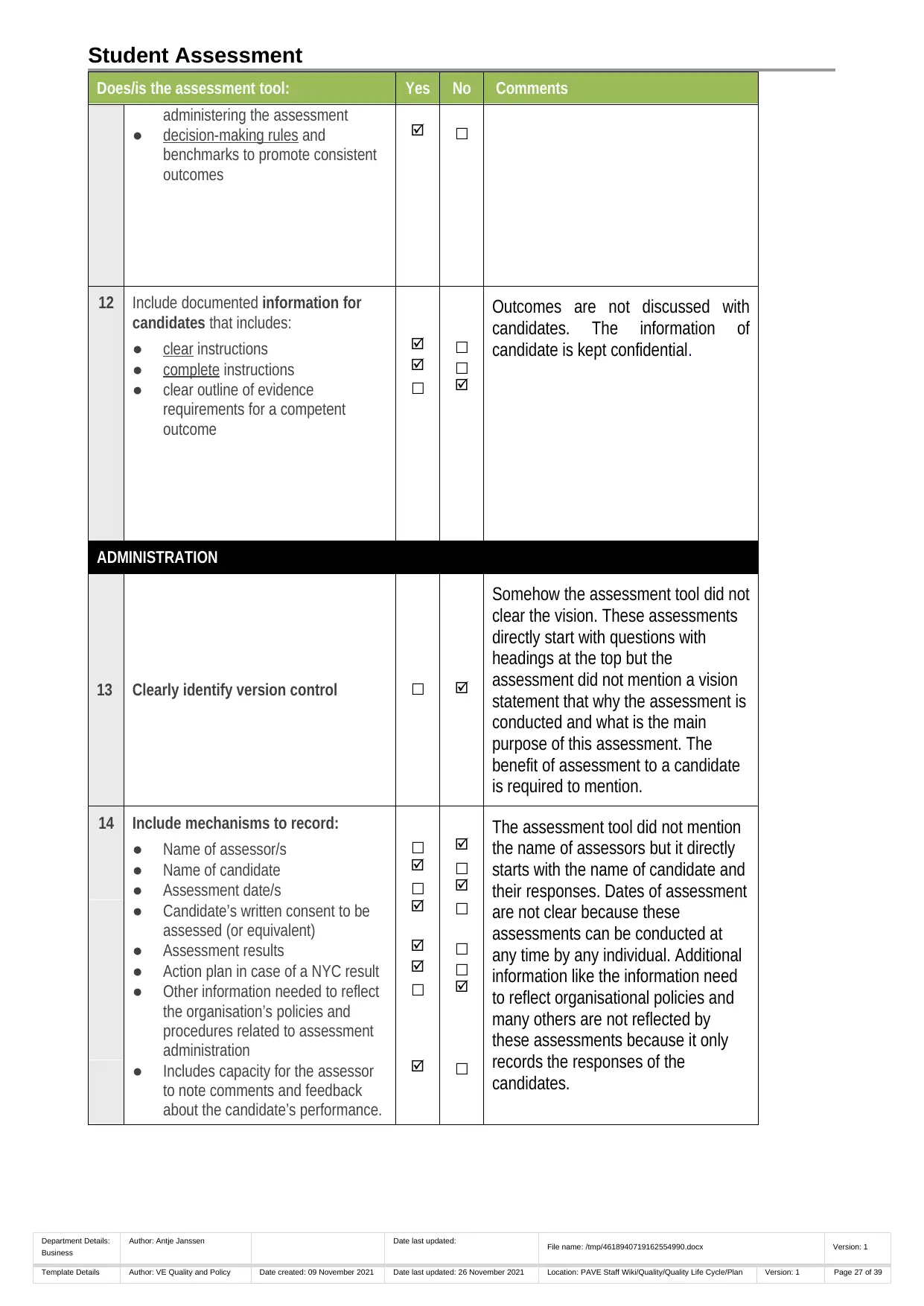
Student Assessment
Does/is the assessment tool: Yes No Comments
administering the assessment
● decision-making rules and
benchmarks to promote consistent
outcomes
☐
12 Include documented information for
candidates that includes: Outcomes are not discussed with
candidates. The information of
candidate is kept confidential.● clear instructions ☐
● complete instructions ☐
● clear outline of evidence
requirements for a competent
outcome
☐
ADMINISTRATION
13 Clearly identify version control ☐
Somehow the assessment tool did not
clear the vision. These assessments
directly start with questions with
headings at the top but the
assessment did not mention a vision
statement that why the assessment is
conducted and what is the main
purpose of this assessment. The
benefit of assessment to a candidate
is required to mention.
14 Include mechanisms to record: The assessment tool did not mention
the name of assessors but it directly
starts with the name of candidate and
their responses. Dates of assessment
are not clear because these
assessments can be conducted at
any time by any individual. Additional
information like the information need
to reflect organisational policies and
many others are not reflected by
these assessments because it only
records the responses of the
candidates.
● Name of assessor/s ☐
● Name of candidate ☐
● Assessment date/s ☐
● Candidate’s written consent to be
assessed (or equivalent)
☐
● Assessment results ☐
● Action plan in case of a NYC result ☐
● Other information needed to reflect
the organisation’s policies and
procedures related to assessment
administration
☐
● Includes capacity for the assessor
to note comments and feedback
about the candidate’s performance.
☐
Department Details:
Business
Author: Antje Janssen Date last updated: File name: /tmp/4618940719162554990.docx Version: 1
Template Details Author: VE Quality and Policy Date created: 09 November 2021 Date last updated: 26 November 2021 Location: PAVE Staff Wiki/Quality/Quality Life Cycle/Plan Version: 1 Page 27 of 39
Does/is the assessment tool: Yes No Comments
administering the assessment
● decision-making rules and
benchmarks to promote consistent
outcomes
☐
12 Include documented information for
candidates that includes: Outcomes are not discussed with
candidates. The information of
candidate is kept confidential.● clear instructions ☐
● complete instructions ☐
● clear outline of evidence
requirements for a competent
outcome
☐
ADMINISTRATION
13 Clearly identify version control ☐
Somehow the assessment tool did not
clear the vision. These assessments
directly start with questions with
headings at the top but the
assessment did not mention a vision
statement that why the assessment is
conducted and what is the main
purpose of this assessment. The
benefit of assessment to a candidate
is required to mention.
14 Include mechanisms to record: The assessment tool did not mention
the name of assessors but it directly
starts with the name of candidate and
their responses. Dates of assessment
are not clear because these
assessments can be conducted at
any time by any individual. Additional
information like the information need
to reflect organisational policies and
many others are not reflected by
these assessments because it only
records the responses of the
candidates.
● Name of assessor/s ☐
● Name of candidate ☐
● Assessment date/s ☐
● Candidate’s written consent to be
assessed (or equivalent)
☐
● Assessment results ☐
● Action plan in case of a NYC result ☐
● Other information needed to reflect
the organisation’s policies and
procedures related to assessment
administration
☐
● Includes capacity for the assessor
to note comments and feedback
about the candidate’s performance.
☐
Department Details:
Business
Author: Antje Janssen Date last updated: File name: /tmp/4618940719162554990.docx Version: 1
Template Details Author: VE Quality and Policy Date created: 09 November 2021 Date last updated: 26 November 2021 Location: PAVE Staff Wiki/Quality/Quality Life Cycle/Plan Version: 1 Page 27 of 39
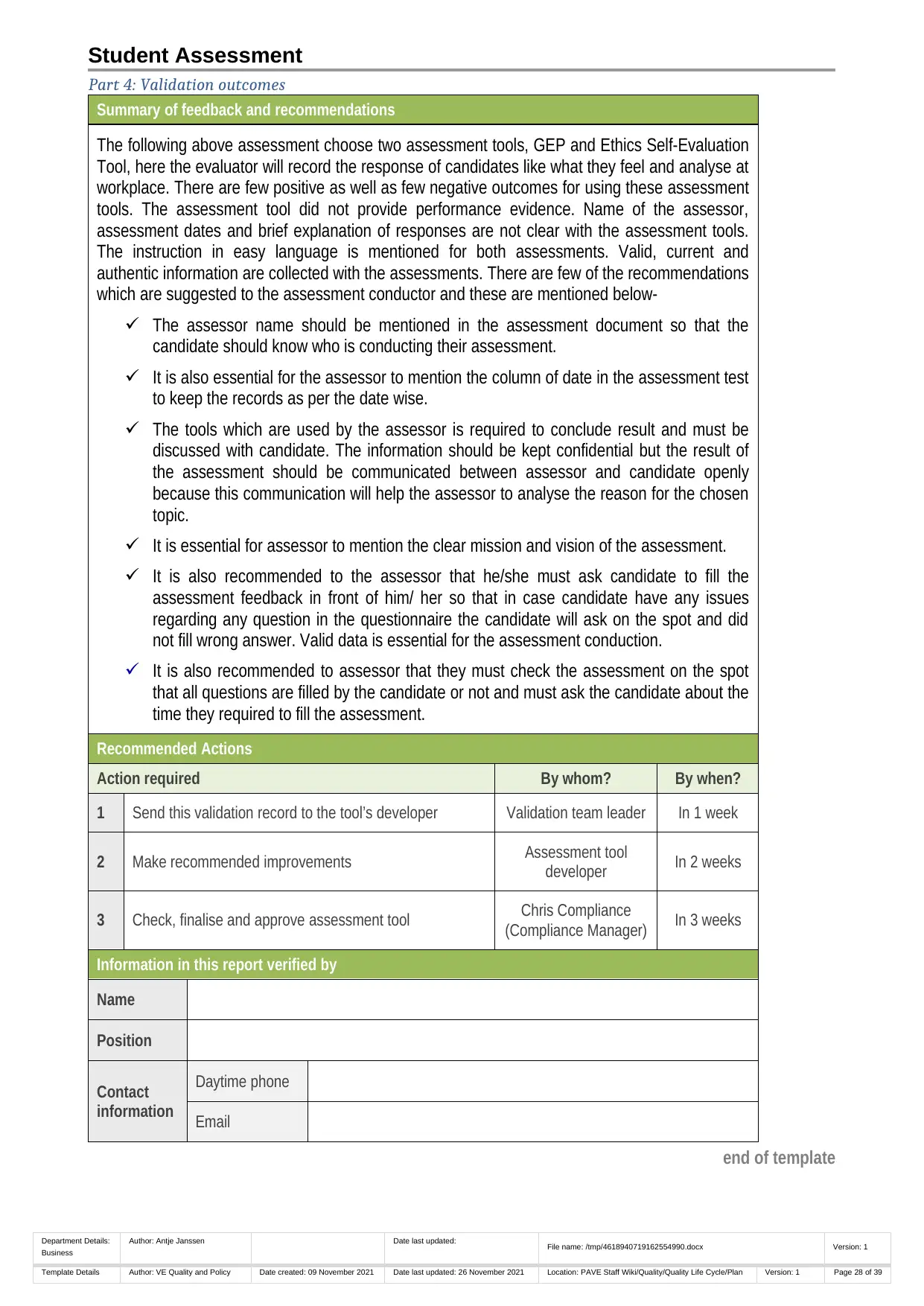
Student Assessment
Part 4: Validation outcomes
Summary of feedback and recommendations
The following above assessment choose two assessment tools, GEP and Ethics Self-Evaluation
Tool, here the evaluator will record the response of candidates like what they feel and analyse at
workplace. There are few positive as well as few negative outcomes for using these assessment
tools. The assessment tool did not provide performance evidence. Name of the assessor,
assessment dates and brief explanation of responses are not clear with the assessment tools.
The instruction in easy language is mentioned for both assessments. Valid, current and
authentic information are collected with the assessments. There are few of the recommendations
which are suggested to the assessment conductor and these are mentioned below-
The assessor name should be mentioned in the assessment document so that the
candidate should know who is conducting their assessment.
It is also essential for the assessor to mention the column of date in the assessment test
to keep the records as per the date wise.
The tools which are used by the assessor is required to conclude result and must be
discussed with candidate. The information should be kept confidential but the result of
the assessment should be communicated between assessor and candidate openly
because this communication will help the assessor to analyse the reason for the chosen
topic.
It is essential for assessor to mention the clear mission and vision of the assessment.
It is also recommended to the assessor that he/she must ask candidate to fill the
assessment feedback in front of him/ her so that in case candidate have any issues
regarding any question in the questionnaire the candidate will ask on the spot and did
not fill wrong answer. Valid data is essential for the assessment conduction.
It is also recommended to assessor that they must check the assessment on the spot
that all questions are filled by the candidate or not and must ask the candidate about the
time they required to fill the assessment.
Recommended Actions
Action required By whom? By when?
1 Send this validation record to the tool’s developer Validation team leader In 1 week
2 Make recommended improvements Assessment tool
developer In 2 weeks
3 Check, finalise and approve assessment tool Chris Compliance
(Compliance Manager) In 3 weeks
Information in this report verified by
Name
Position
Contact
information
Daytime phone
Email
end of template
Department Details:
Business
Author: Antje Janssen Date last updated: File name: /tmp/4618940719162554990.docx Version: 1
Template Details Author: VE Quality and Policy Date created: 09 November 2021 Date last updated: 26 November 2021 Location: PAVE Staff Wiki/Quality/Quality Life Cycle/Plan Version: 1 Page 28 of 39
Part 4: Validation outcomes
Summary of feedback and recommendations
The following above assessment choose two assessment tools, GEP and Ethics Self-Evaluation
Tool, here the evaluator will record the response of candidates like what they feel and analyse at
workplace. There are few positive as well as few negative outcomes for using these assessment
tools. The assessment tool did not provide performance evidence. Name of the assessor,
assessment dates and brief explanation of responses are not clear with the assessment tools.
The instruction in easy language is mentioned for both assessments. Valid, current and
authentic information are collected with the assessments. There are few of the recommendations
which are suggested to the assessment conductor and these are mentioned below-
The assessor name should be mentioned in the assessment document so that the
candidate should know who is conducting their assessment.
It is also essential for the assessor to mention the column of date in the assessment test
to keep the records as per the date wise.
The tools which are used by the assessor is required to conclude result and must be
discussed with candidate. The information should be kept confidential but the result of
the assessment should be communicated between assessor and candidate openly
because this communication will help the assessor to analyse the reason for the chosen
topic.
It is essential for assessor to mention the clear mission and vision of the assessment.
It is also recommended to the assessor that he/she must ask candidate to fill the
assessment feedback in front of him/ her so that in case candidate have any issues
regarding any question in the questionnaire the candidate will ask on the spot and did
not fill wrong answer. Valid data is essential for the assessment conduction.
It is also recommended to assessor that they must check the assessment on the spot
that all questions are filled by the candidate or not and must ask the candidate about the
time they required to fill the assessment.
Recommended Actions
Action required By whom? By when?
1 Send this validation record to the tool’s developer Validation team leader In 1 week
2 Make recommended improvements Assessment tool
developer In 2 weeks
3 Check, finalise and approve assessment tool Chris Compliance
(Compliance Manager) In 3 weeks
Information in this report verified by
Name
Position
Contact
information
Daytime phone
end of template
Department Details:
Business
Author: Antje Janssen Date last updated: File name: /tmp/4618940719162554990.docx Version: 1
Template Details Author: VE Quality and Policy Date created: 09 November 2021 Date last updated: 26 November 2021 Location: PAVE Staff Wiki/Quality/Quality Life Cycle/Plan Version: 1 Page 28 of 39
Secure Best Marks with AI Grader
Need help grading? Try our AI Grader for instant feedback on your assignments.
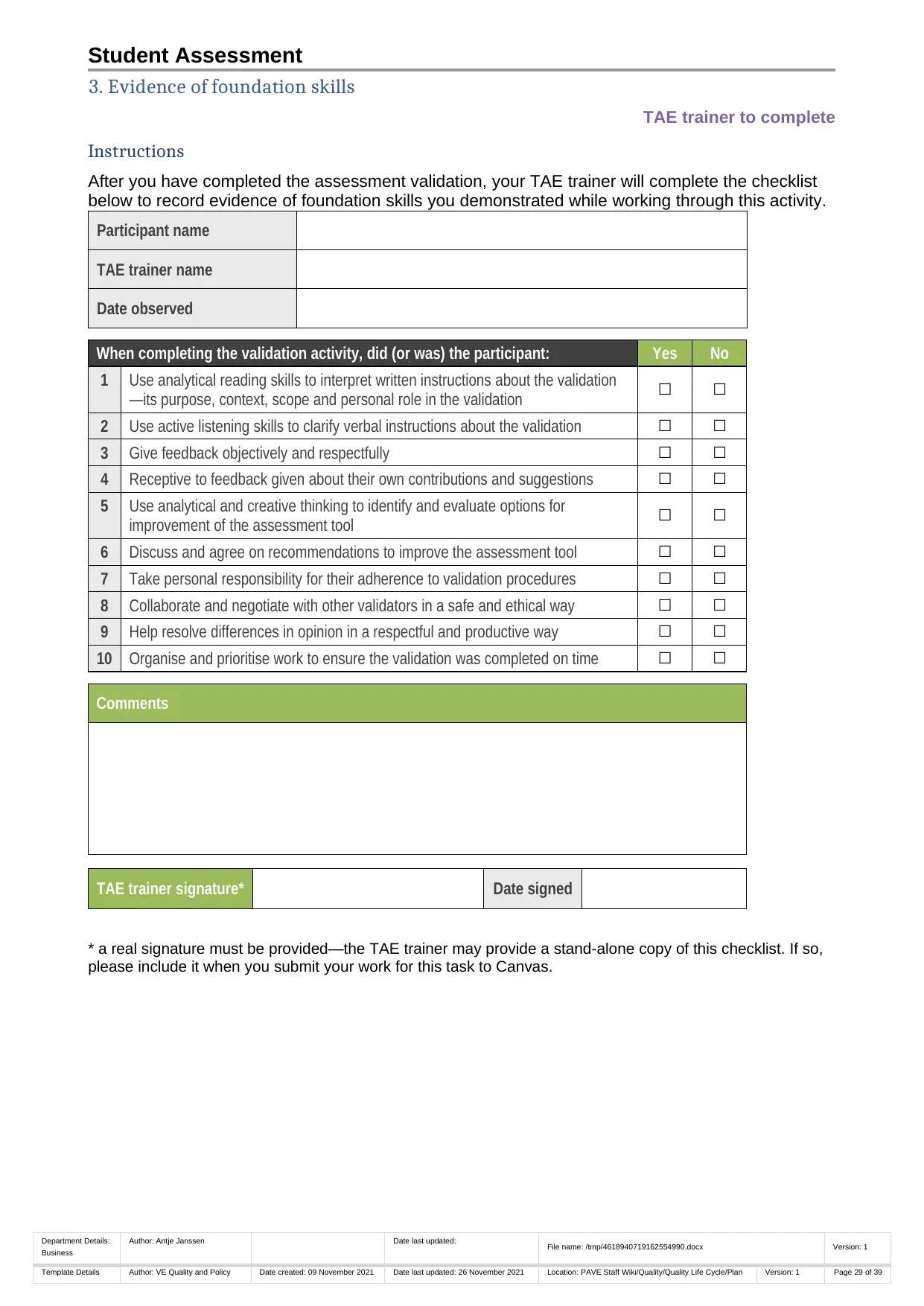
Student Assessment
3. Evidence of foundation skills
TAE trainer to complete
Instructions
After you have completed the assessment validation, your TAE trainer will complete the checklist
below to record evidence of foundation skills you demonstrated while working through this activity.
Participant name
TAE trainer name
Date observed
When completing the validation activity, did (or was) the participant: Yes No
1 Use analytical reading skills to interpret written instructions about the validation
—its purpose, context, scope and personal role in the validation ☐ ☐
2 Use active listening skills to clarify verbal instructions about the validation ☐ ☐
3 Give feedback objectively and respectfully ☐ ☐
4 Receptive to feedback given about their own contributions and suggestions ☐ ☐
5 Use analytical and creative thinking to identify and evaluate options for
improvement of the assessment tool ☐ ☐
6 Discuss and agree on recommendations to improve the assessment tool ☐ ☐
7 Take personal responsibility for their adherence to validation procedures ☐ ☐
8 Collaborate and negotiate with other validators in a safe and ethical way ☐ ☐
9 Help resolve differences in opinion in a respectful and productive way ☐ ☐
10 Organise and prioritise work to ensure the validation was completed on time ☐ ☐
Comments
TAE trainer signature* Date signed
* a real signature must be provided—the TAE trainer may provide a stand-alone copy of this checklist. If so,
please include it when you submit your work for this task to Canvas.
Department Details:
Business
Author: Antje Janssen Date last updated: File name: /tmp/4618940719162554990.docx Version: 1
Template Details Author: VE Quality and Policy Date created: 09 November 2021 Date last updated: 26 November 2021 Location: PAVE Staff Wiki/Quality/Quality Life Cycle/Plan Version: 1 Page 29 of 39
3. Evidence of foundation skills
TAE trainer to complete
Instructions
After you have completed the assessment validation, your TAE trainer will complete the checklist
below to record evidence of foundation skills you demonstrated while working through this activity.
Participant name
TAE trainer name
Date observed
When completing the validation activity, did (or was) the participant: Yes No
1 Use analytical reading skills to interpret written instructions about the validation
—its purpose, context, scope and personal role in the validation ☐ ☐
2 Use active listening skills to clarify verbal instructions about the validation ☐ ☐
3 Give feedback objectively and respectfully ☐ ☐
4 Receptive to feedback given about their own contributions and suggestions ☐ ☐
5 Use analytical and creative thinking to identify and evaluate options for
improvement of the assessment tool ☐ ☐
6 Discuss and agree on recommendations to improve the assessment tool ☐ ☐
7 Take personal responsibility for their adherence to validation procedures ☐ ☐
8 Collaborate and negotiate with other validators in a safe and ethical way ☐ ☐
9 Help resolve differences in opinion in a respectful and productive way ☐ ☐
10 Organise and prioritise work to ensure the validation was completed on time ☐ ☐
Comments
TAE trainer signature* Date signed
* a real signature must be provided—the TAE trainer may provide a stand-alone copy of this checklist. If so,
please include it when you submit your work for this task to Canvas.
Department Details:
Business
Author: Antje Janssen Date last updated: File name: /tmp/4618940719162554990.docx Version: 1
Template Details Author: VE Quality and Policy Date created: 09 November 2021 Date last updated: 26 November 2021 Location: PAVE Staff Wiki/Quality/Quality Life Cycle/Plan Version: 1 Page 29 of 39
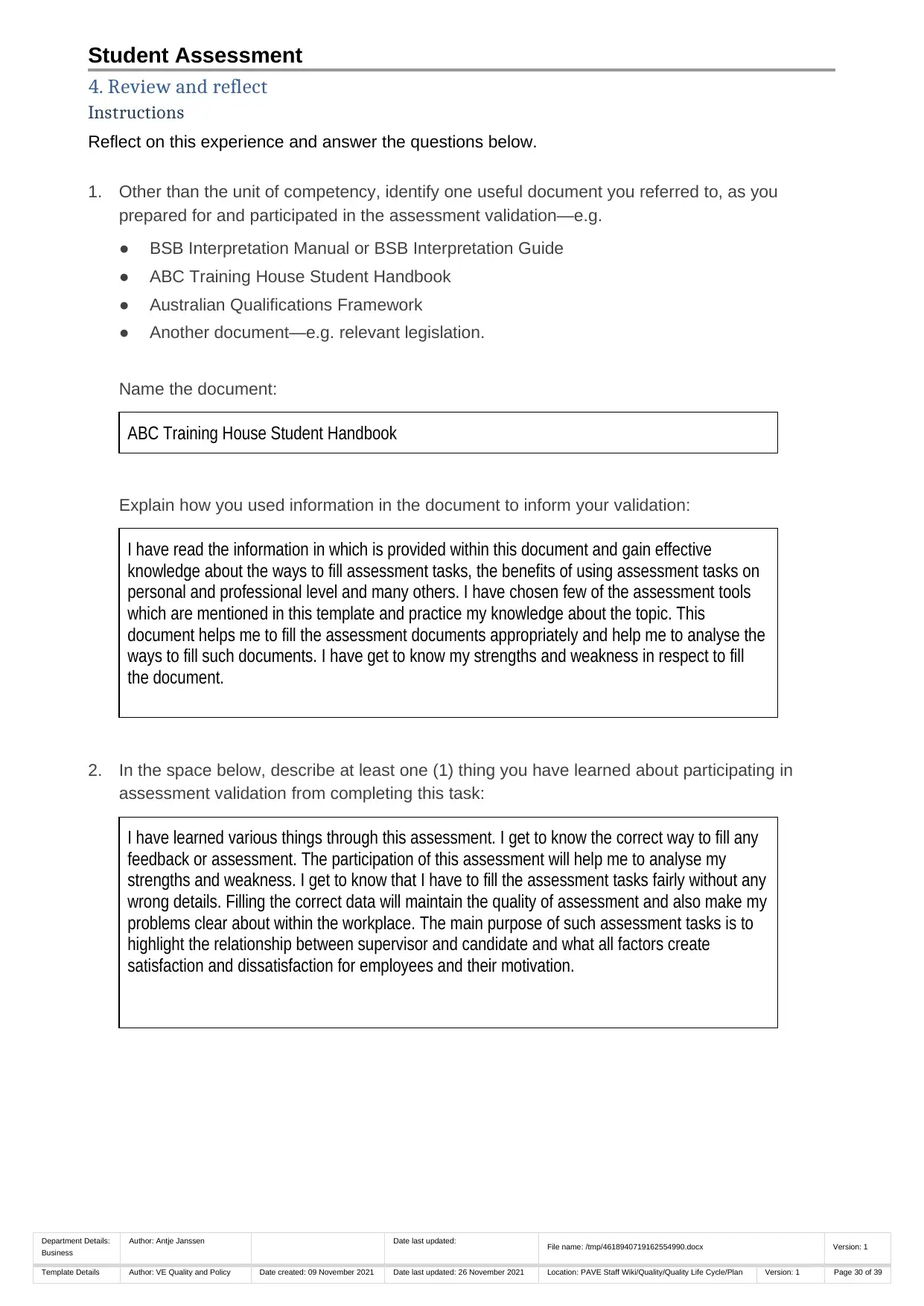
Student Assessment
4. Review and reflect
Instructions
Reflect on this experience and answer the questions below.
1. Other than the unit of competency, identify one useful document you referred to, as you
prepared for and participated in the assessment validation—e.g.
● BSB Interpretation Manual or BSB Interpretation Guide
● ABC Training House Student Handbook
● Australian Qualifications Framework
● Another document—e.g. relevant legislation.
Name the document:
ABC Training House Student Handbook
Explain how you used information in the document to inform your validation:
I have read the information in which is provided within this document and gain effective
knowledge about the ways to fill assessment tasks, the benefits of using assessment tasks on
personal and professional level and many others. I have chosen few of the assessment tools
which are mentioned in this template and practice my knowledge about the topic. This
document helps me to fill the assessment documents appropriately and help me to analyse the
ways to fill such documents. I have get to know my strengths and weakness in respect to fill
the document.
2. In the space below, describe at least one (1) thing you have learned about participating in
assessment validation from completing this task:
I have learned various things through this assessment. I get to know the correct way to fill any
feedback or assessment. The participation of this assessment will help me to analyse my
strengths and weakness. I get to know that I have to fill the assessment tasks fairly without any
wrong details. Filling the correct data will maintain the quality of assessment and also make my
problems clear about within the workplace. The main purpose of such assessment tasks is to
highlight the relationship between supervisor and candidate and what all factors create
satisfaction and dissatisfaction for employees and their motivation.
Department Details:
Business
Author: Antje Janssen Date last updated: File name: /tmp/4618940719162554990.docx Version: 1
Template Details Author: VE Quality and Policy Date created: 09 November 2021 Date last updated: 26 November 2021 Location: PAVE Staff Wiki/Quality/Quality Life Cycle/Plan Version: 1 Page 30 of 39
4. Review and reflect
Instructions
Reflect on this experience and answer the questions below.
1. Other than the unit of competency, identify one useful document you referred to, as you
prepared for and participated in the assessment validation—e.g.
● BSB Interpretation Manual or BSB Interpretation Guide
● ABC Training House Student Handbook
● Australian Qualifications Framework
● Another document—e.g. relevant legislation.
Name the document:
ABC Training House Student Handbook
Explain how you used information in the document to inform your validation:
I have read the information in which is provided within this document and gain effective
knowledge about the ways to fill assessment tasks, the benefits of using assessment tasks on
personal and professional level and many others. I have chosen few of the assessment tools
which are mentioned in this template and practice my knowledge about the topic. This
document helps me to fill the assessment documents appropriately and help me to analyse the
ways to fill such documents. I have get to know my strengths and weakness in respect to fill
the document.
2. In the space below, describe at least one (1) thing you have learned about participating in
assessment validation from completing this task:
I have learned various things through this assessment. I get to know the correct way to fill any
feedback or assessment. The participation of this assessment will help me to analyse my
strengths and weakness. I get to know that I have to fill the assessment tasks fairly without any
wrong details. Filling the correct data will maintain the quality of assessment and also make my
problems clear about within the workplace. The main purpose of such assessment tasks is to
highlight the relationship between supervisor and candidate and what all factors create
satisfaction and dissatisfaction for employees and their motivation.
Department Details:
Business
Author: Antje Janssen Date last updated: File name: /tmp/4618940719162554990.docx Version: 1
Template Details Author: VE Quality and Policy Date created: 09 November 2021 Date last updated: 26 November 2021 Location: PAVE Staff Wiki/Quality/Quality Life Cycle/Plan Version: 1 Page 30 of 39

Student Assessment
5. Organise and submit your work
Organise your work
Check this instruction document
Make sure that:
● you have completed and signed the assessment cover sheet
● all sections of this task instruction document have been completed—some pages (e.g. the
Evidence of Foundation Skills checklist) may be provided separately.
Gather additional evidence
Additional evidence will include:
● a pdf scan of a hard copy of the draft assessment tool you validated, with your hand-written
comments added
● a pdf scan of the unit of competence and assessment requirements—BSBTWK201 Work
effectively with others—overwritten, to show how you analysed the unit to identify evidence
requirements.
Compile and present your portfolio of evidence for this task
Department Details:
Business
Author: Antje Janssen Date last updated: File name: /tmp/4618940719162554990.docx Version: 1
Template Details Author: VE Quality and Policy Date created: 09 November 2021 Date last updated: 26 November 2021 Location: PAVE Staff Wiki/Quality/Quality Life Cycle/Plan Version: 1 Page 31 of 39
5. Organise and submit your work
Organise your work
Check this instruction document
Make sure that:
● you have completed and signed the assessment cover sheet
● all sections of this task instruction document have been completed—some pages (e.g. the
Evidence of Foundation Skills checklist) may be provided separately.
Gather additional evidence
Additional evidence will include:
● a pdf scan of a hard copy of the draft assessment tool you validated, with your hand-written
comments added
● a pdf scan of the unit of competence and assessment requirements—BSBTWK201 Work
effectively with others—overwritten, to show how you analysed the unit to identify evidence
requirements.
Compile and present your portfolio of evidence for this task
Department Details:
Business
Author: Antje Janssen Date last updated: File name: /tmp/4618940719162554990.docx Version: 1
Template Details Author: VE Quality and Policy Date created: 09 November 2021 Date last updated: 26 November 2021 Location: PAVE Staff Wiki/Quality/Quality Life Cycle/Plan Version: 1 Page 31 of 39
Paraphrase This Document
Need a fresh take? Get an instant paraphrase of this document with our AI Paraphraser

Student Assessment
Resubmission or Re-sit Outcome
Where an answer is deemed unsatisfactory after the first attempt, up to three resubmission or re-sit
attempts will be allowed. The attempt may occur immediately after the assessment if the assessor believes
this is suitable. Alternatively, an additional attempt may be provided at a later stage where the assessor
identifies a need for the student to undertake further training and preparation.
The assessor is required to provide you feedback detailing what was Unsatisfactory (US) and what you
need to do to achieve a Satisfactory (S) outcome using the student feedback record. You will be required
to re submit any aspect of the work that was Unsatisfactory (US).
Assessment Outcome
To successfully complete this activity, you are required to complete all requirements and submit all
evidence to meet the Product Quality Criteria evidence criteria for this task to achieve a Satisfactory (S)
result. The outcome of this assessment will contribute to the evidence used in the final decision to achieve
competency for the Assessment Cluster.
Assessment Submission
To meet the requirements of this assessment you are required to submit the following documents/evidence
via Canvas:
Completed assessment task cover sheet
1. This task instruction document with all sections completed.
Guidance:
a. Provide this entire instruction document in Word (editable) version
b. If any pages were completed using handwriting, provide both:
c. – a blank, Word version of this document, and
d. – pdf scans of any pages that were completed or signed in hard copy.
2. Copy of the unit and its assessment requirements covered in the assessment tool you validated,
marked with added comments to show how you analysed and contextualised them.
3. A standalone copy of the draft assessment tool you validated, with your added comments that
show how you reviewed and analysed the draft tool as part of your validation activities.
Department Details:
Business
Author: Antje Janssen Date last updated: File name: /tmp/4618940719162554990.docx Version: 1
Template Details Author: VE Quality and Policy Date created: 09 November 2021 Date last updated: 26 November 2021 Location: PAVE Staff Wiki/Quality/Quality Life Cycle/Plan Version: 1 Page 32 of 39
Resubmission or Re-sit Outcome
Where an answer is deemed unsatisfactory after the first attempt, up to three resubmission or re-sit
attempts will be allowed. The attempt may occur immediately after the assessment if the assessor believes
this is suitable. Alternatively, an additional attempt may be provided at a later stage where the assessor
identifies a need for the student to undertake further training and preparation.
The assessor is required to provide you feedback detailing what was Unsatisfactory (US) and what you
need to do to achieve a Satisfactory (S) outcome using the student feedback record. You will be required
to re submit any aspect of the work that was Unsatisfactory (US).
Assessment Outcome
To successfully complete this activity, you are required to complete all requirements and submit all
evidence to meet the Product Quality Criteria evidence criteria for this task to achieve a Satisfactory (S)
result. The outcome of this assessment will contribute to the evidence used in the final decision to achieve
competency for the Assessment Cluster.
Assessment Submission
To meet the requirements of this assessment you are required to submit the following documents/evidence
via Canvas:
Completed assessment task cover sheet
1. This task instruction document with all sections completed.
Guidance:
a. Provide this entire instruction document in Word (editable) version
b. If any pages were completed using handwriting, provide both:
c. – a blank, Word version of this document, and
d. – pdf scans of any pages that were completed or signed in hard copy.
2. Copy of the unit and its assessment requirements covered in the assessment tool you validated,
marked with added comments to show how you analysed and contextualised them.
3. A standalone copy of the draft assessment tool you validated, with your added comments that
show how you reviewed and analysed the draft tool as part of your validation activities.
Department Details:
Business
Author: Antje Janssen Date last updated: File name: /tmp/4618940719162554990.docx Version: 1
Template Details Author: VE Quality and Policy Date created: 09 November 2021 Date last updated: 26 November 2021 Location: PAVE Staff Wiki/Quality/Quality Life Cycle/Plan Version: 1 Page 32 of 39
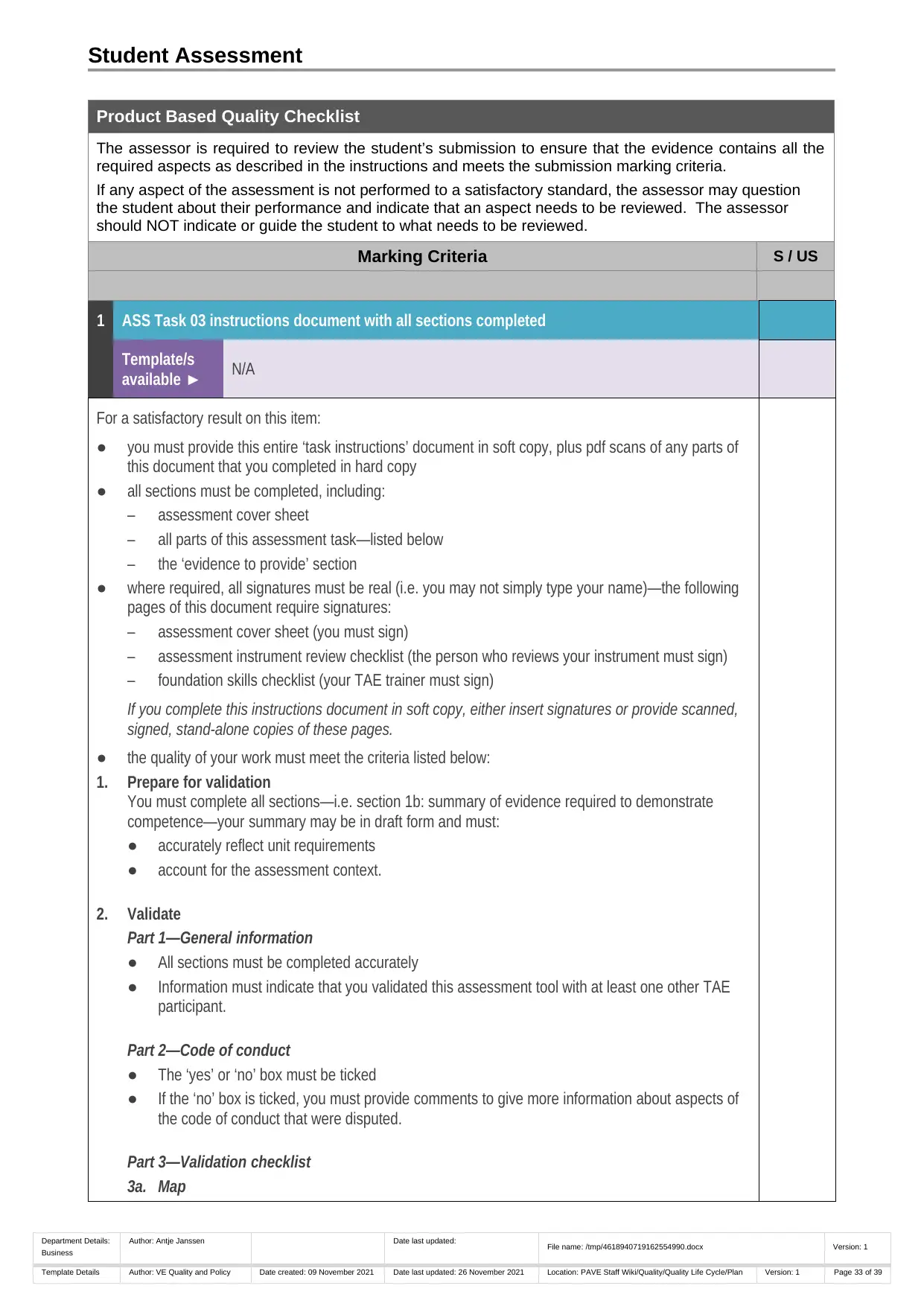
Student Assessment
Product Based Quality Checklist
The assessor is required to review the student’s submission to ensure that the evidence contains all the
required aspects as described in the instructions and meets the submission marking criteria.
If any aspect of the assessment is not performed to a satisfactory standard, the assessor may question
the student about their performance and indicate that an aspect needs to be reviewed. The assessor
should NOT indicate or guide the student to what needs to be reviewed.
Marking Criteria S / US
1 ASS Task 03 instructions document with all sections completed
Template/s
available ► N/A
For a satisfactory result on this item:
● you must provide this entire ‘task instructions’ document in soft copy, plus pdf scans of any parts of
this document that you completed in hard copy
● all sections must be completed, including:
– assessment cover sheet
– all parts of this assessment task—listed below
– the ‘evidence to provide’ section
● where required, all signatures must be real (i.e. you may not simply type your name)—the following
pages of this document require signatures:
– assessment cover sheet (you must sign)
– assessment instrument review checklist (the person who reviews your instrument must sign)
– foundation skills checklist (your TAE trainer must sign)
If you complete this instructions document in soft copy, either insert signatures or provide scanned,
signed, stand-alone copies of these pages.
● the quality of your work must meet the criteria listed below:
1. Prepare for validation
You must complete all sections—i.e. section 1b: summary of evidence required to demonstrate
competence—your summary may be in draft form and must:
● accurately reflect unit requirements
● account for the assessment context.
2. Validate
Part 1—General information
● All sections must be completed accurately
● Information must indicate that you validated this assessment tool with at least one other TAE
participant.
Part 2—Code of conduct
● The ‘yes’ or ‘no’ box must be ticked
● If the ‘no’ box is ticked, you must provide comments to give more information about aspects of
the code of conduct that were disputed.
Part 3—Validation checklist
3a. Map
Department Details:
Business
Author: Antje Janssen Date last updated: File name: /tmp/4618940719162554990.docx Version: 1
Template Details Author: VE Quality and Policy Date created: 09 November 2021 Date last updated: 26 November 2021 Location: PAVE Staff Wiki/Quality/Quality Life Cycle/Plan Version: 1 Page 33 of 39
Product Based Quality Checklist
The assessor is required to review the student’s submission to ensure that the evidence contains all the
required aspects as described in the instructions and meets the submission marking criteria.
If any aspect of the assessment is not performed to a satisfactory standard, the assessor may question
the student about their performance and indicate that an aspect needs to be reviewed. The assessor
should NOT indicate or guide the student to what needs to be reviewed.
Marking Criteria S / US
1 ASS Task 03 instructions document with all sections completed
Template/s
available ► N/A
For a satisfactory result on this item:
● you must provide this entire ‘task instructions’ document in soft copy, plus pdf scans of any parts of
this document that you completed in hard copy
● all sections must be completed, including:
– assessment cover sheet
– all parts of this assessment task—listed below
– the ‘evidence to provide’ section
● where required, all signatures must be real (i.e. you may not simply type your name)—the following
pages of this document require signatures:
– assessment cover sheet (you must sign)
– assessment instrument review checklist (the person who reviews your instrument must sign)
– foundation skills checklist (your TAE trainer must sign)
If you complete this instructions document in soft copy, either insert signatures or provide scanned,
signed, stand-alone copies of these pages.
● the quality of your work must meet the criteria listed below:
1. Prepare for validation
You must complete all sections—i.e. section 1b: summary of evidence required to demonstrate
competence—your summary may be in draft form and must:
● accurately reflect unit requirements
● account for the assessment context.
2. Validate
Part 1—General information
● All sections must be completed accurately
● Information must indicate that you validated this assessment tool with at least one other TAE
participant.
Part 2—Code of conduct
● The ‘yes’ or ‘no’ box must be ticked
● If the ‘no’ box is ticked, you must provide comments to give more information about aspects of
the code of conduct that were disputed.
Part 3—Validation checklist
3a. Map
Department Details:
Business
Author: Antje Janssen Date last updated: File name: /tmp/4618940719162554990.docx Version: 1
Template Details Author: VE Quality and Policy Date created: 09 November 2021 Date last updated: 26 November 2021 Location: PAVE Staff Wiki/Quality/Quality Life Cycle/Plan Version: 1 Page 33 of 39
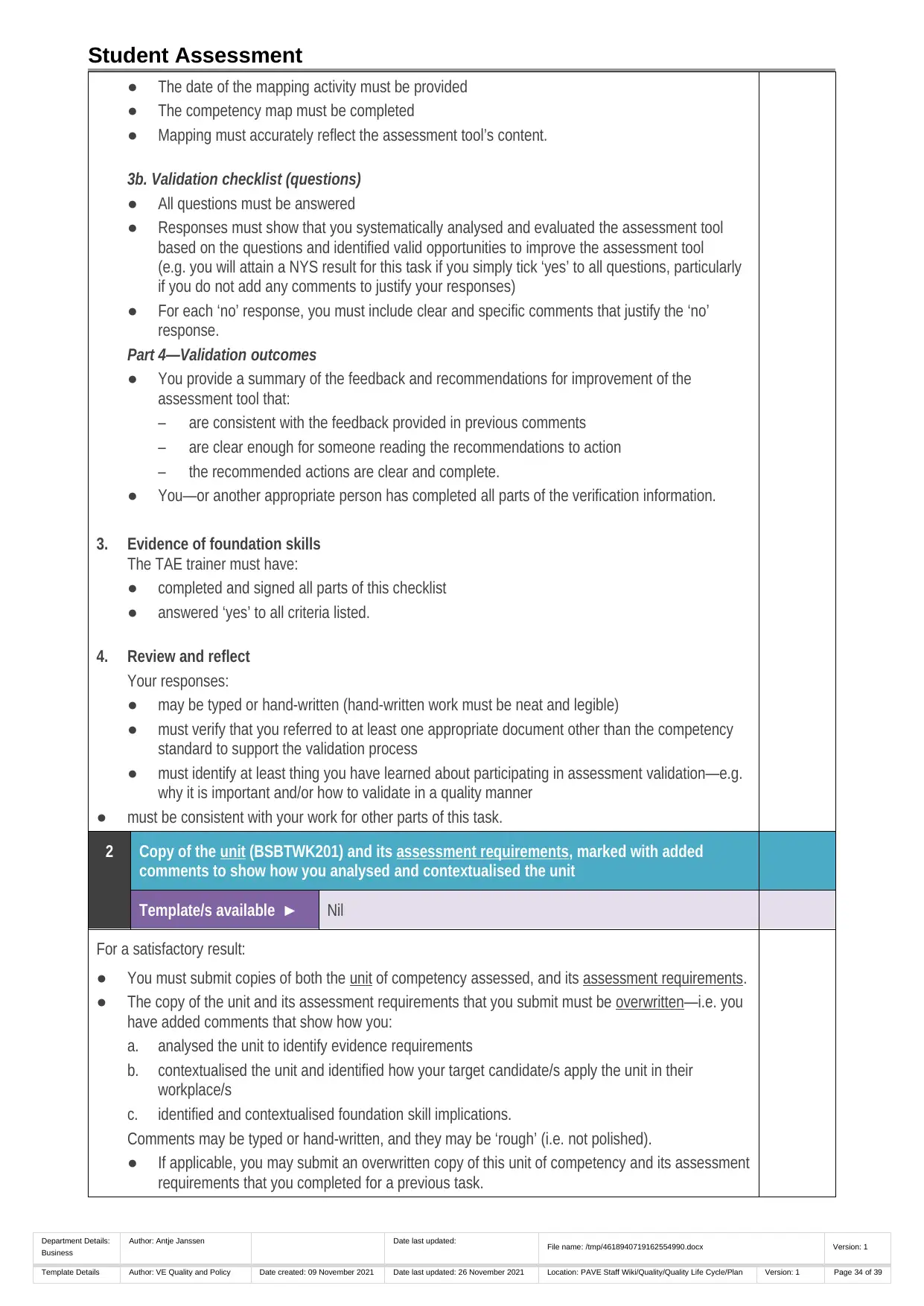
Student Assessment
● The date of the mapping activity must be provided
● The competency map must be completed
● Mapping must accurately reflect the assessment tool’s content.
3b. Validation checklist (questions)
● All questions must be answered
● Responses must show that you systematically analysed and evaluated the assessment tool
based on the questions and identified valid opportunities to improve the assessment tool
(e.g. you will attain a NYS result for this task if you simply tick ‘yes’ to all questions, particularly
if you do not add any comments to justify your responses)
● For each ‘no’ response, you must include clear and specific comments that justify the ‘no’
response.
Part 4—Validation outcomes
● You provide a summary of the feedback and recommendations for improvement of the
assessment tool that:
– are consistent with the feedback provided in previous comments
– are clear enough for someone reading the recommendations to action
– the recommended actions are clear and complete.
● You—or another appropriate person has completed all parts of the verification information.
3. Evidence of foundation skills
The TAE trainer must have:
● completed and signed all parts of this checklist
● answered ‘yes’ to all criteria listed.
4. Review and reflect
Your responses:
● may be typed or hand-written (hand-written work must be neat and legible)
● must verify that you referred to at least one appropriate document other than the competency
standard to support the validation process
● must identify at least thing you have learned about participating in assessment validation—e.g.
why it is important and/or how to validate in a quality manner
● must be consistent with your work for other parts of this task.
2 Copy of the unit (BSBTWK201) and its assessment requirements, marked with added
comments to show how you analysed and contextualised the unit
Template/s available ► Nil
For a satisfactory result:
● You must submit copies of both the unit of competency assessed, and its assessment requirements.
● The copy of the unit and its assessment requirements that you submit must be overwritten—i.e. you
have added comments that show how you:
a. analysed the unit to identify evidence requirements
b. contextualised the unit and identified how your target candidate/s apply the unit in their
workplace/s
c. identified and contextualised foundation skill implications.
Comments may be typed or hand-written, and they may be ‘rough’ (i.e. not polished).
● If applicable, you may submit an overwritten copy of this unit of competency and its assessment
requirements that you completed for a previous task.
Department Details:
Business
Author: Antje Janssen Date last updated: File name: /tmp/4618940719162554990.docx Version: 1
Template Details Author: VE Quality and Policy Date created: 09 November 2021 Date last updated: 26 November 2021 Location: PAVE Staff Wiki/Quality/Quality Life Cycle/Plan Version: 1 Page 34 of 39
● The date of the mapping activity must be provided
● The competency map must be completed
● Mapping must accurately reflect the assessment tool’s content.
3b. Validation checklist (questions)
● All questions must be answered
● Responses must show that you systematically analysed and evaluated the assessment tool
based on the questions and identified valid opportunities to improve the assessment tool
(e.g. you will attain a NYS result for this task if you simply tick ‘yes’ to all questions, particularly
if you do not add any comments to justify your responses)
● For each ‘no’ response, you must include clear and specific comments that justify the ‘no’
response.
Part 4—Validation outcomes
● You provide a summary of the feedback and recommendations for improvement of the
assessment tool that:
– are consistent with the feedback provided in previous comments
– are clear enough for someone reading the recommendations to action
– the recommended actions are clear and complete.
● You—or another appropriate person has completed all parts of the verification information.
3. Evidence of foundation skills
The TAE trainer must have:
● completed and signed all parts of this checklist
● answered ‘yes’ to all criteria listed.
4. Review and reflect
Your responses:
● may be typed or hand-written (hand-written work must be neat and legible)
● must verify that you referred to at least one appropriate document other than the competency
standard to support the validation process
● must identify at least thing you have learned about participating in assessment validation—e.g.
why it is important and/or how to validate in a quality manner
● must be consistent with your work for other parts of this task.
2 Copy of the unit (BSBTWK201) and its assessment requirements, marked with added
comments to show how you analysed and contextualised the unit
Template/s available ► Nil
For a satisfactory result:
● You must submit copies of both the unit of competency assessed, and its assessment requirements.
● The copy of the unit and its assessment requirements that you submit must be overwritten—i.e. you
have added comments that show how you:
a. analysed the unit to identify evidence requirements
b. contextualised the unit and identified how your target candidate/s apply the unit in their
workplace/s
c. identified and contextualised foundation skill implications.
Comments may be typed or hand-written, and they may be ‘rough’ (i.e. not polished).
● If applicable, you may submit an overwritten copy of this unit of competency and its assessment
requirements that you completed for a previous task.
Department Details:
Business
Author: Antje Janssen Date last updated: File name: /tmp/4618940719162554990.docx Version: 1
Template Details Author: VE Quality and Policy Date created: 09 November 2021 Date last updated: 26 November 2021 Location: PAVE Staff Wiki/Quality/Quality Life Cycle/Plan Version: 1 Page 34 of 39
Secure Best Marks with AI Grader
Need help grading? Try our AI Grader for instant feedback on your assignments.
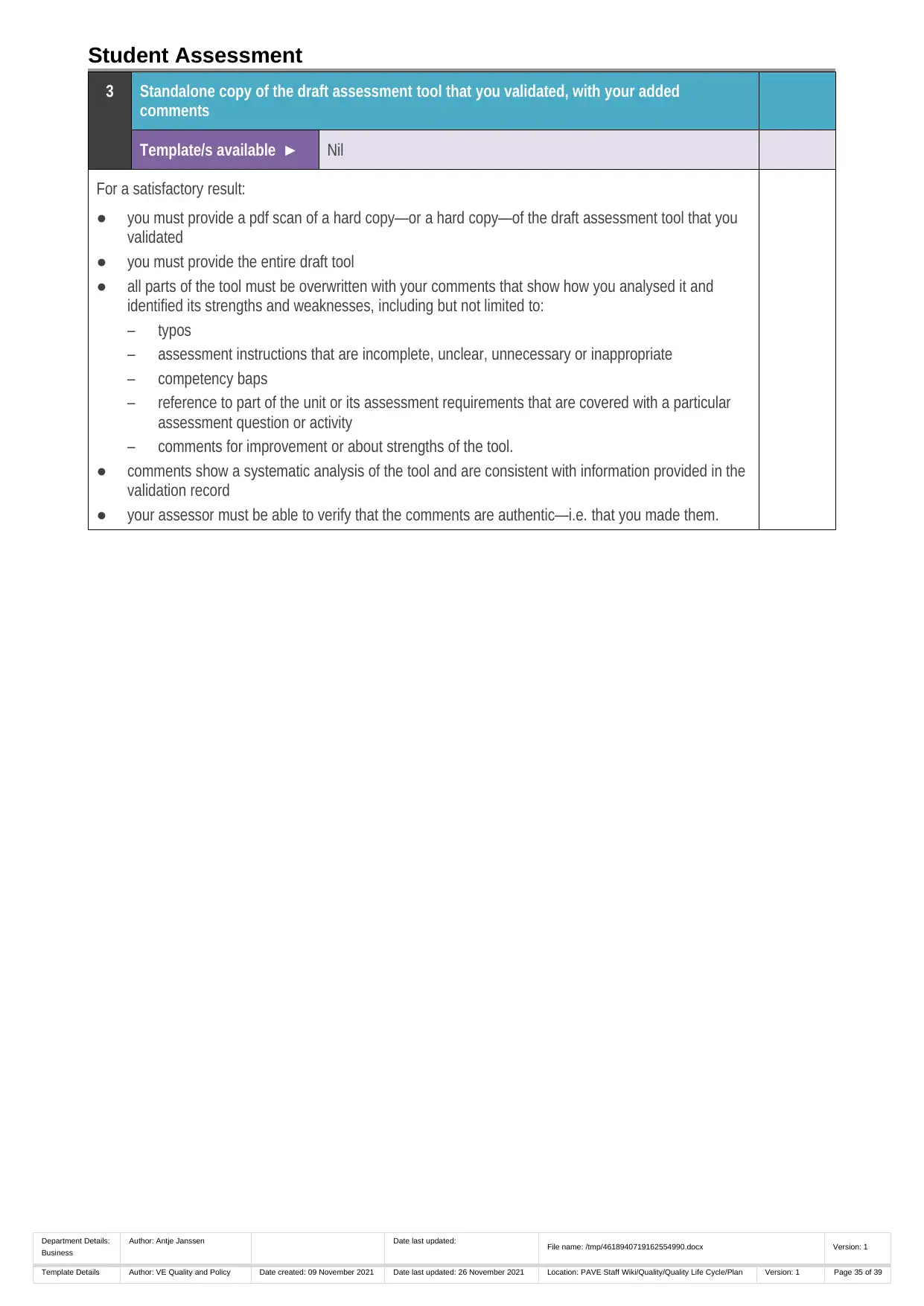
Student Assessment
3 Standalone copy of the draft assessment tool that you validated, with your added
comments
Template/s available ► Nil
For a satisfactory result:
● you must provide a pdf scan of a hard copy—or a hard copy—of the draft assessment tool that you
validated
● you must provide the entire draft tool
● all parts of the tool must be overwritten with your comments that show how you analysed it and
identified its strengths and weaknesses, including but not limited to:
– typos
– assessment instructions that are incomplete, unclear, unnecessary or inappropriate
– competency baps
– reference to part of the unit or its assessment requirements that are covered with a particular
assessment question or activity
– comments for improvement or about strengths of the tool.
● comments show a systematic analysis of the tool and are consistent with information provided in the
validation record
● your assessor must be able to verify that the comments are authentic—i.e. that you made them.
Department Details:
Business
Author: Antje Janssen Date last updated: File name: /tmp/4618940719162554990.docx Version: 1
Template Details Author: VE Quality and Policy Date created: 09 November 2021 Date last updated: 26 November 2021 Location: PAVE Staff Wiki/Quality/Quality Life Cycle/Plan Version: 1 Page 35 of 39
3 Standalone copy of the draft assessment tool that you validated, with your added
comments
Template/s available ► Nil
For a satisfactory result:
● you must provide a pdf scan of a hard copy—or a hard copy—of the draft assessment tool that you
validated
● you must provide the entire draft tool
● all parts of the tool must be overwritten with your comments that show how you analysed it and
identified its strengths and weaknesses, including but not limited to:
– typos
– assessment instructions that are incomplete, unclear, unnecessary or inappropriate
– competency baps
– reference to part of the unit or its assessment requirements that are covered with a particular
assessment question or activity
– comments for improvement or about strengths of the tool.
● comments show a systematic analysis of the tool and are consistent with information provided in the
validation record
● your assessor must be able to verify that the comments are authentic—i.e. that you made them.
Department Details:
Business
Author: Antje Janssen Date last updated: File name: /tmp/4618940719162554990.docx Version: 1
Template Details Author: VE Quality and Policy Date created: 09 November 2021 Date last updated: 26 November 2021 Location: PAVE Staff Wiki/Quality/Quality Life Cycle/Plan Version: 1 Page 35 of 39
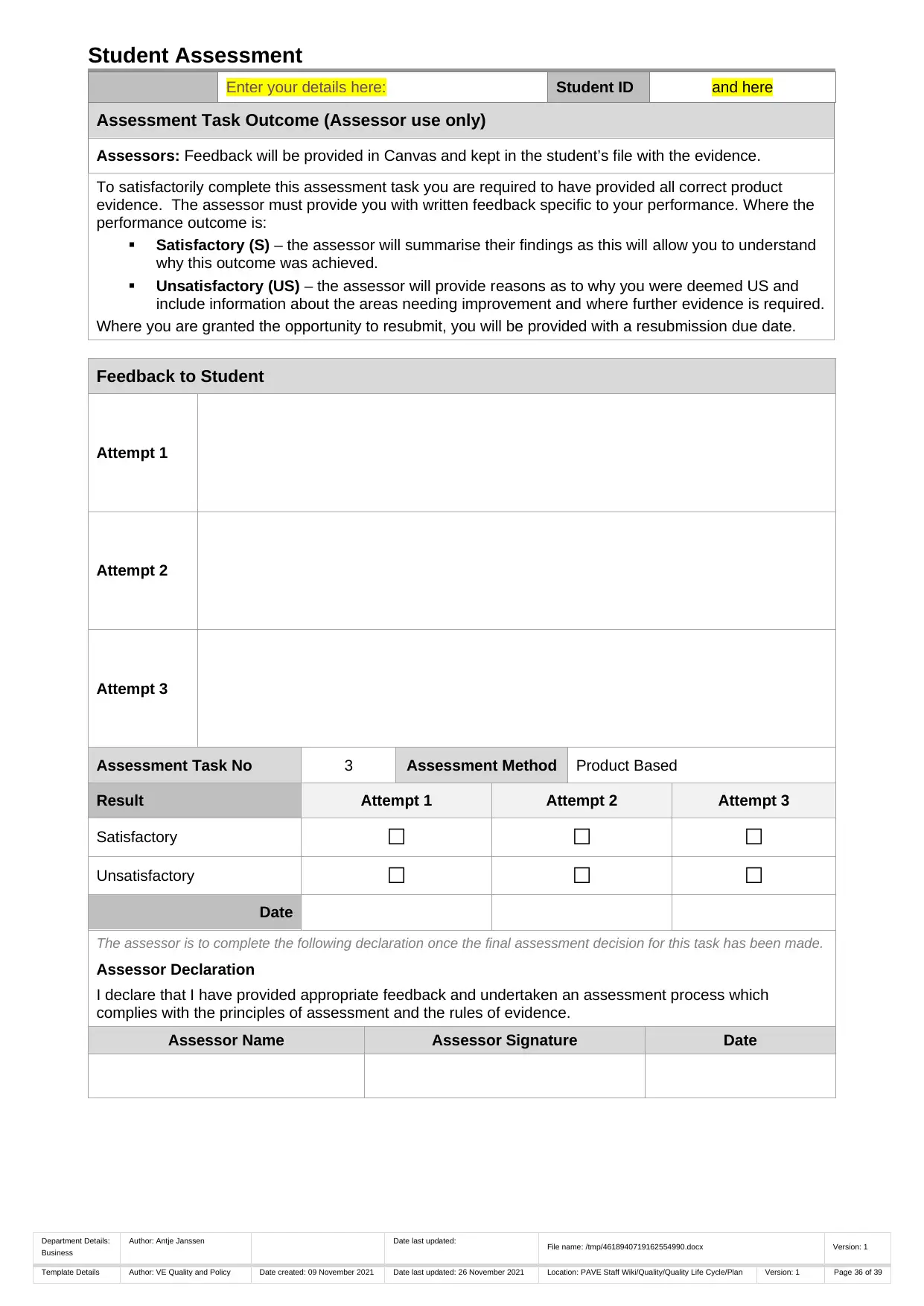
Student Assessment
Enter your details here: Student ID and here
Assessment Task Outcome (Assessor use only)
Assessors: Feedback will be provided in Canvas and kept in the student’s file with the evidence.
To satisfactorily complete this assessment task you are required to have provided all correct product
evidence. The assessor must provide you with written feedback specific to your performance. Where the
performance outcome is:
Satisfactory (S) – the assessor will summarise their findings as this will allow you to understand
why this outcome was achieved.
Unsatisfactory (US) – the assessor will provide reasons as to why you were deemed US and
include information about the areas needing improvement and where further evidence is required.
Where you are granted the opportunity to resubmit, you will be provided with a resubmission due date.
Feedback to Student
Attempt 1
Attempt 2
Attempt 3
Assessment Task No 3 Assessment Method Product Based
Result Attempt 1 Attempt 2 Attempt 3
Satisfactory ☐ ☐ ☐
Unsatisfactory ☐ ☐ ☐
Date
The assessor is to complete the following declaration once the final assessment decision for this task has been made.
Assessor Declaration
I declare that I have provided appropriate feedback and undertaken an assessment process which
complies with the principles of assessment and the rules of evidence.
Assessor Name Assessor Signature Date
Department Details:
Business
Author: Antje Janssen Date last updated: File name: /tmp/4618940719162554990.docx Version: 1
Template Details Author: VE Quality and Policy Date created: 09 November 2021 Date last updated: 26 November 2021 Location: PAVE Staff Wiki/Quality/Quality Life Cycle/Plan Version: 1 Page 36 of 39
Enter your details here: Student ID and here
Assessment Task Outcome (Assessor use only)
Assessors: Feedback will be provided in Canvas and kept in the student’s file with the evidence.
To satisfactorily complete this assessment task you are required to have provided all correct product
evidence. The assessor must provide you with written feedback specific to your performance. Where the
performance outcome is:
Satisfactory (S) – the assessor will summarise their findings as this will allow you to understand
why this outcome was achieved.
Unsatisfactory (US) – the assessor will provide reasons as to why you were deemed US and
include information about the areas needing improvement and where further evidence is required.
Where you are granted the opportunity to resubmit, you will be provided with a resubmission due date.
Feedback to Student
Attempt 1
Attempt 2
Attempt 3
Assessment Task No 3 Assessment Method Product Based
Result Attempt 1 Attempt 2 Attempt 3
Satisfactory ☐ ☐ ☐
Unsatisfactory ☐ ☐ ☐
Date
The assessor is to complete the following declaration once the final assessment decision for this task has been made.
Assessor Declaration
I declare that I have provided appropriate feedback and undertaken an assessment process which
complies with the principles of assessment and the rules of evidence.
Assessor Name Assessor Signature Date
Department Details:
Business
Author: Antje Janssen Date last updated: File name: /tmp/4618940719162554990.docx Version: 1
Template Details Author: VE Quality and Policy Date created: 09 November 2021 Date last updated: 26 November 2021 Location: PAVE Staff Wiki/Quality/Quality Life Cycle/Plan Version: 1 Page 36 of 39
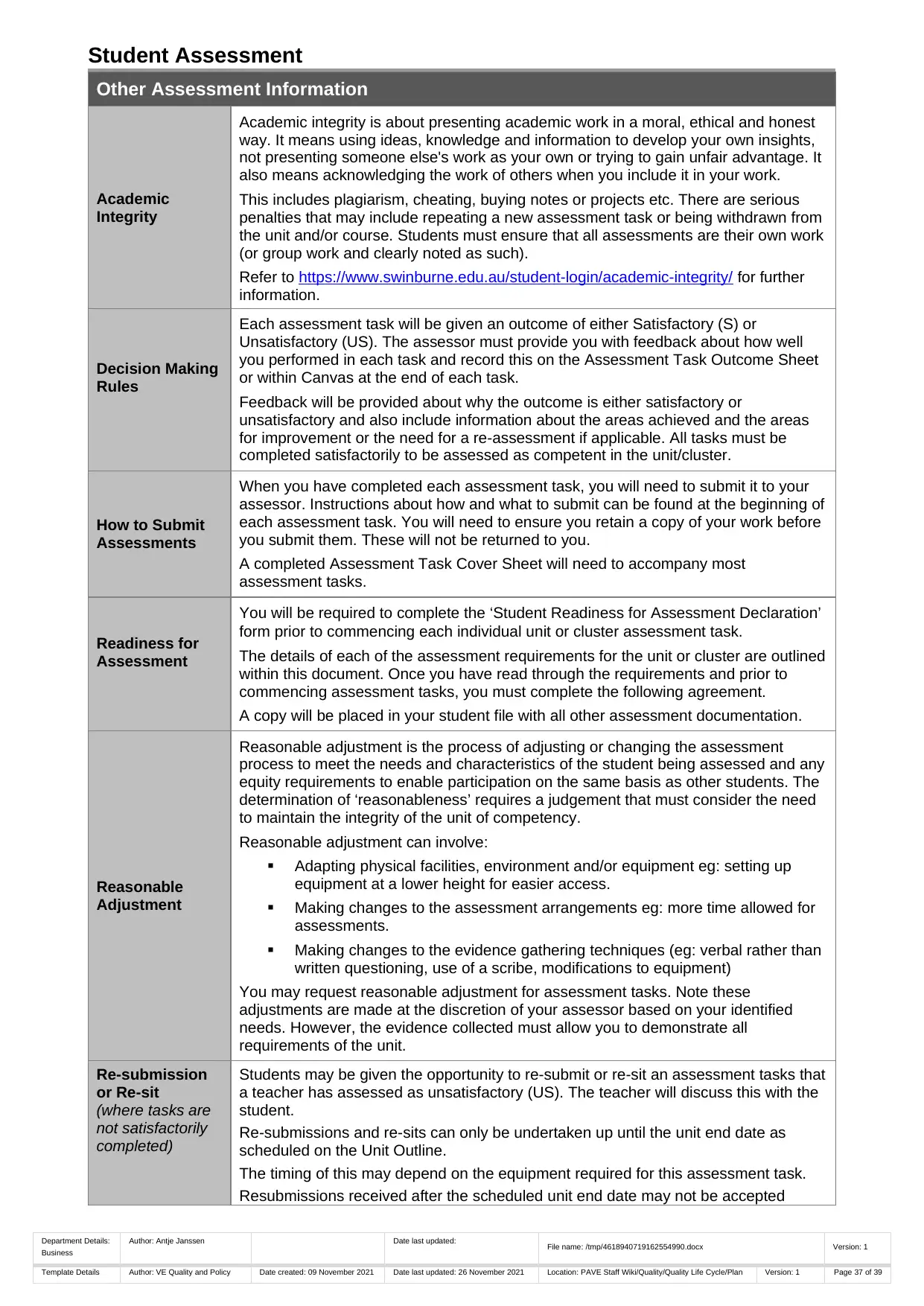
Student Assessment
Other Assessment Information
Academic
Integrity
Academic integrity is about presenting academic work in a moral, ethical and honest
way. It means using ideas, knowledge and information to develop your own insights,
not presenting someone else's work as your own or trying to gain unfair advantage. It
also means acknowledging the work of others when you include it in your work.
This includes plagiarism, cheating, buying notes or projects etc. There are serious
penalties that may include repeating a new assessment task or being withdrawn from
the unit and/or course. Students must ensure that all assessments are their own work
(or group work and clearly noted as such).
Refer to https://www.swinburne.edu.au/student-login/academic-integrity/ for further
information.
Decision Making
Rules
Each assessment task will be given an outcome of either Satisfactory (S) or
Unsatisfactory (US). The assessor must provide you with feedback about how well
you performed in each task and record this on the Assessment Task Outcome Sheet
or within Canvas at the end of each task.
Feedback will be provided about why the outcome is either satisfactory or
unsatisfactory and also include information about the areas achieved and the areas
for improvement or the need for a re-assessment if applicable. All tasks must be
completed satisfactorily to be assessed as competent in the unit/cluster.
How to Submit
Assessments
When you have completed each assessment task, you will need to submit it to your
assessor. Instructions about how and what to submit can be found at the beginning of
each assessment task. You will need to ensure you retain a copy of your work before
you submit them. These will not be returned to you.
A completed Assessment Task Cover Sheet will need to accompany most
assessment tasks.
Readiness for
Assessment
You will be required to complete the ‘Student Readiness for Assessment Declaration’
form prior to commencing each individual unit or cluster assessment task.
The details of each of the assessment requirements for the unit or cluster are outlined
within this document. Once you have read through the requirements and prior to
commencing assessment tasks, you must complete the following agreement.
A copy will be placed in your student file with all other assessment documentation.
Reasonable
Adjustment
Reasonable adjustment is the process of adjusting or changing the assessment
process to meet the needs and characteristics of the student being assessed and any
equity requirements to enable participation on the same basis as other students. The
determination of ‘reasonableness’ requires a judgement that must consider the need
to maintain the integrity of the unit of competency.
Reasonable adjustment can involve:
Adapting physical facilities, environment and/or equipment eg: setting up
equipment at a lower height for easier access.
Making changes to the assessment arrangements eg: more time allowed for
assessments.
Making changes to the evidence gathering techniques (eg: verbal rather than
written questioning, use of a scribe, modifications to equipment)
You may request reasonable adjustment for assessment tasks. Note these
adjustments are made at the discretion of your assessor based on your identified
needs. However, the evidence collected must allow you to demonstrate all
requirements of the unit.
Re-submission
or Re-sit
(where tasks are
not satisfactorily
completed)
Students may be given the opportunity to re-submit or re-sit an assessment tasks that
a teacher has assessed as unsatisfactory (US). The teacher will discuss this with the
student.
Re-submissions and re-sits can only be undertaken up until the unit end date as
scheduled on the Unit Outline.
The timing of this may depend on the equipment required for this assessment task.
Resubmissions received after the scheduled unit end date may not be accepted
Department Details:
Business
Author: Antje Janssen Date last updated: File name: /tmp/4618940719162554990.docx Version: 1
Template Details Author: VE Quality and Policy Date created: 09 November 2021 Date last updated: 26 November 2021 Location: PAVE Staff Wiki/Quality/Quality Life Cycle/Plan Version: 1 Page 37 of 39
Other Assessment Information
Academic
Integrity
Academic integrity is about presenting academic work in a moral, ethical and honest
way. It means using ideas, knowledge and information to develop your own insights,
not presenting someone else's work as your own or trying to gain unfair advantage. It
also means acknowledging the work of others when you include it in your work.
This includes plagiarism, cheating, buying notes or projects etc. There are serious
penalties that may include repeating a new assessment task or being withdrawn from
the unit and/or course. Students must ensure that all assessments are their own work
(or group work and clearly noted as such).
Refer to https://www.swinburne.edu.au/student-login/academic-integrity/ for further
information.
Decision Making
Rules
Each assessment task will be given an outcome of either Satisfactory (S) or
Unsatisfactory (US). The assessor must provide you with feedback about how well
you performed in each task and record this on the Assessment Task Outcome Sheet
or within Canvas at the end of each task.
Feedback will be provided about why the outcome is either satisfactory or
unsatisfactory and also include information about the areas achieved and the areas
for improvement or the need for a re-assessment if applicable. All tasks must be
completed satisfactorily to be assessed as competent in the unit/cluster.
How to Submit
Assessments
When you have completed each assessment task, you will need to submit it to your
assessor. Instructions about how and what to submit can be found at the beginning of
each assessment task. You will need to ensure you retain a copy of your work before
you submit them. These will not be returned to you.
A completed Assessment Task Cover Sheet will need to accompany most
assessment tasks.
Readiness for
Assessment
You will be required to complete the ‘Student Readiness for Assessment Declaration’
form prior to commencing each individual unit or cluster assessment task.
The details of each of the assessment requirements for the unit or cluster are outlined
within this document. Once you have read through the requirements and prior to
commencing assessment tasks, you must complete the following agreement.
A copy will be placed in your student file with all other assessment documentation.
Reasonable
Adjustment
Reasonable adjustment is the process of adjusting or changing the assessment
process to meet the needs and characteristics of the student being assessed and any
equity requirements to enable participation on the same basis as other students. The
determination of ‘reasonableness’ requires a judgement that must consider the need
to maintain the integrity of the unit of competency.
Reasonable adjustment can involve:
Adapting physical facilities, environment and/or equipment eg: setting up
equipment at a lower height for easier access.
Making changes to the assessment arrangements eg: more time allowed for
assessments.
Making changes to the evidence gathering techniques (eg: verbal rather than
written questioning, use of a scribe, modifications to equipment)
You may request reasonable adjustment for assessment tasks. Note these
adjustments are made at the discretion of your assessor based on your identified
needs. However, the evidence collected must allow you to demonstrate all
requirements of the unit.
Re-submission
or Re-sit
(where tasks are
not satisfactorily
completed)
Students may be given the opportunity to re-submit or re-sit an assessment tasks that
a teacher has assessed as unsatisfactory (US). The teacher will discuss this with the
student.
Re-submissions and re-sits can only be undertaken up until the unit end date as
scheduled on the Unit Outline.
The timing of this may depend on the equipment required for this assessment task.
Resubmissions received after the scheduled unit end date may not be accepted
Department Details:
Business
Author: Antje Janssen Date last updated: File name: /tmp/4618940719162554990.docx Version: 1
Template Details Author: VE Quality and Policy Date created: 09 November 2021 Date last updated: 26 November 2021 Location: PAVE Staff Wiki/Quality/Quality Life Cycle/Plan Version: 1 Page 37 of 39
Paraphrase This Document
Need a fresh take? Get an instant paraphrase of this document with our AI Paraphraser
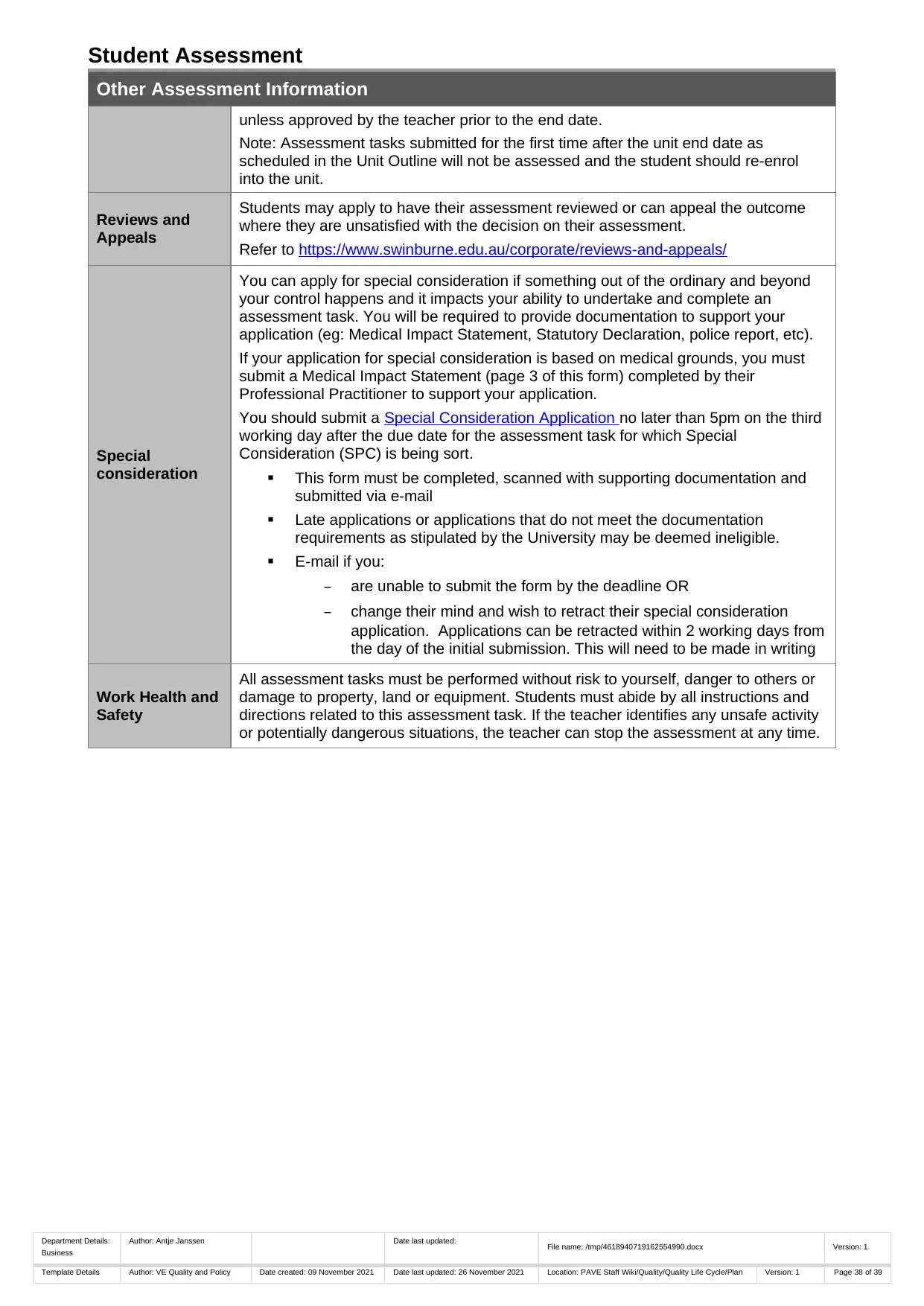
Student Assessment
Other Assessment Information
unless approved by the teacher prior to the end date.
Note: Assessment tasks submitted for the first time after the unit end date as
scheduled in the Unit Outline will not be assessed and the student should re-enrol
into the unit.
Reviews and
Appeals
Students may apply to have their assessment reviewed or can appeal the outcome
where they are unsatisfied with the decision on their assessment.
Refer to https://www.swinburne.edu.au/corporate/reviews-and-appeals/
Special
consideration
You can apply for special consideration if something out of the ordinary and beyond
your control happens and it impacts your ability to undertake and complete an
assessment task. You will be required to provide documentation to support your
application (eg: Medical Impact Statement, Statutory Declaration, police report, etc).
If your application for special consideration is based on medical grounds, you must
submit a Medical Impact Statement (page 3 of this form) completed by their
Professional Practitioner to support your application.
You should submit a Special Consideration Application no later than 5pm on the third
working day after the due date for the assessment task for which Special
Consideration (SPC) is being sort.
This form must be completed, scanned with supporting documentation and
submitted via e-mail
Late applications or applications that do not meet the documentation
requirements as stipulated by the University may be deemed ineligible.
E-mail if you:
– are unable to submit the form by the deadline OR
– change their mind and wish to retract their special consideration
application. Applications can be retracted within 2 working days from
the day of the initial submission. This will need to be made in writing
Work Health and
Safety
All assessment tasks must be performed without risk to yourself, danger to others or
damage to property, land or equipment. Students must abide by all instructions and
directions related to this assessment task. If the teacher identifies any unsafe activity
or potentially dangerous situations, the teacher can stop the assessment at any time.
Department Details:
Business
Author: Antje Janssen Date last updated: File name: /tmp/4618940719162554990.docx Version: 1
Template Details Author: VE Quality and Policy Date created: 09 November 2021 Date last updated: 26 November 2021 Location: PAVE Staff Wiki/Quality/Quality Life Cycle/Plan Version: 1 Page 38 of 39
Other Assessment Information
unless approved by the teacher prior to the end date.
Note: Assessment tasks submitted for the first time after the unit end date as
scheduled in the Unit Outline will not be assessed and the student should re-enrol
into the unit.
Reviews and
Appeals
Students may apply to have their assessment reviewed or can appeal the outcome
where they are unsatisfied with the decision on their assessment.
Refer to https://www.swinburne.edu.au/corporate/reviews-and-appeals/
Special
consideration
You can apply for special consideration if something out of the ordinary and beyond
your control happens and it impacts your ability to undertake and complete an
assessment task. You will be required to provide documentation to support your
application (eg: Medical Impact Statement, Statutory Declaration, police report, etc).
If your application for special consideration is based on medical grounds, you must
submit a Medical Impact Statement (page 3 of this form) completed by their
Professional Practitioner to support your application.
You should submit a Special Consideration Application no later than 5pm on the third
working day after the due date for the assessment task for which Special
Consideration (SPC) is being sort.
This form must be completed, scanned with supporting documentation and
submitted via e-mail
Late applications or applications that do not meet the documentation
requirements as stipulated by the University may be deemed ineligible.
E-mail if you:
– are unable to submit the form by the deadline OR
– change their mind and wish to retract their special consideration
application. Applications can be retracted within 2 working days from
the day of the initial submission. This will need to be made in writing
Work Health and
Safety
All assessment tasks must be performed without risk to yourself, danger to others or
damage to property, land or equipment. Students must abide by all instructions and
directions related to this assessment task. If the teacher identifies any unsafe activity
or potentially dangerous situations, the teacher can stop the assessment at any time.
Department Details:
Business
Author: Antje Janssen Date last updated: File name: /tmp/4618940719162554990.docx Version: 1
Template Details Author: VE Quality and Policy Date created: 09 November 2021 Date last updated: 26 November 2021 Location: PAVE Staff Wiki/Quality/Quality Life Cycle/Plan Version: 1 Page 38 of 39
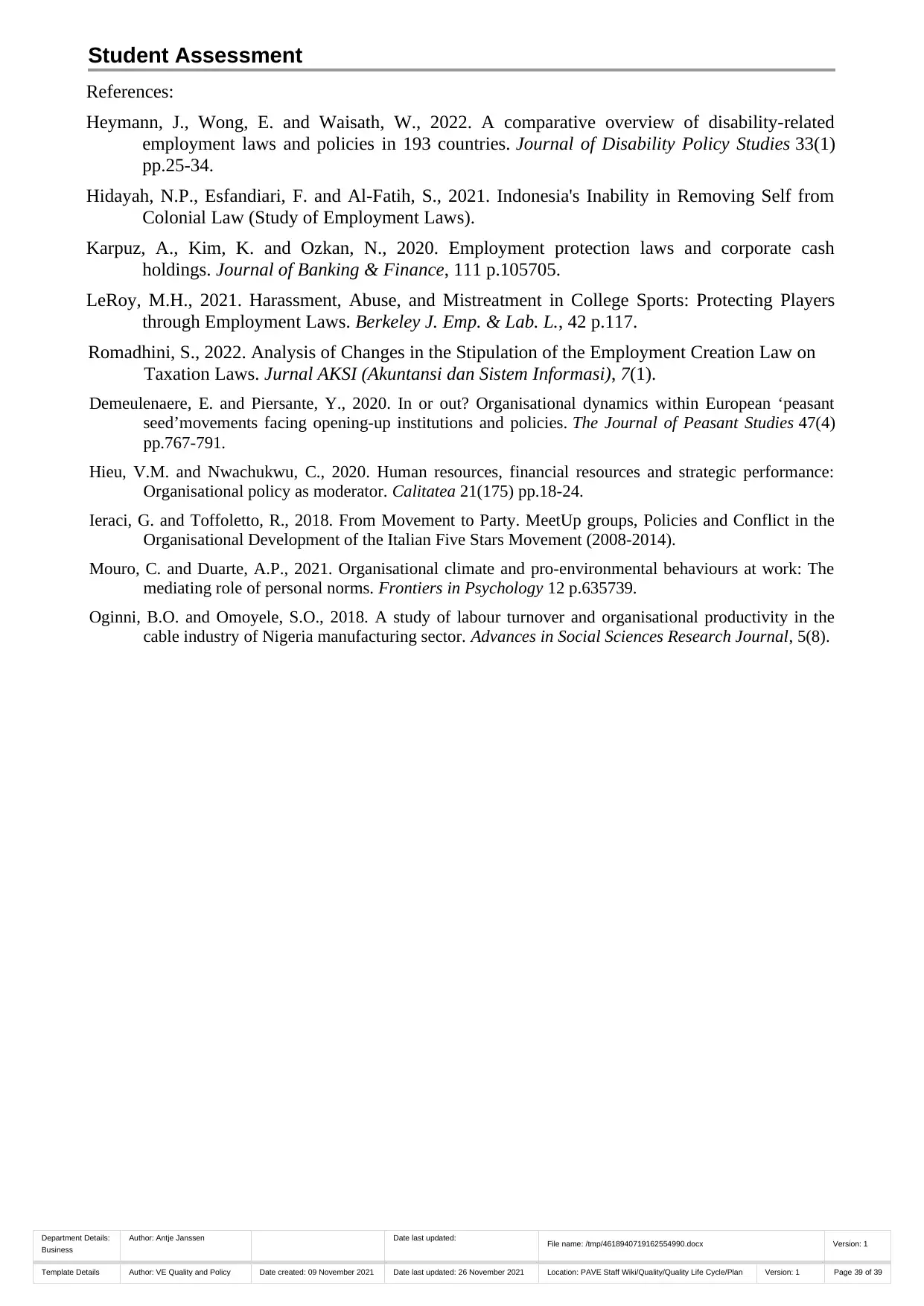
Student Assessment
References:
Heymann, J., Wong, E. and Waisath, W., 2022. A comparative overview of disability-related
employment laws and policies in 193 countries. Journal of Disability Policy Studies 33(1)
pp.25-34.
Hidayah, N.P., Esfandiari, F. and Al-Fatih, S., 2021. Indonesia's Inability in Removing Self from
Colonial Law (Study of Employment Laws).
Karpuz, A., Kim, K. and Ozkan, N., 2020. Employment protection laws and corporate cash
holdings. Journal of Banking & Finance, 111 p.105705.
LeRoy, M.H., 2021. Harassment, Abuse, and Mistreatment in College Sports: Protecting Players
through Employment Laws. Berkeley J. Emp. & Lab. L., 42 p.117.
Romadhini, S., 2022. Analysis of Changes in the Stipulation of the Employment Creation Law on
Taxation Laws. Jurnal AKSI (Akuntansi dan Sistem Informasi), 7(1).
Demeulenaere, E. and Piersante, Y., 2020. In or out? Organisational dynamics within European ‘peasant
seed’movements facing opening-up institutions and policies. The Journal of Peasant Studies 47(4)
pp.767-791.
Hieu, V.M. and Nwachukwu, C., 2020. Human resources, financial resources and strategic performance:
Organisational policy as moderator. Calitatea 21(175) pp.18-24.
Ieraci, G. and Toffoletto, R., 2018. From Movement to Party. MeetUp groups, Policies and Conflict in the
Organisational Development of the Italian Five Stars Movement (2008-2014).
Mouro, C. and Duarte, A.P., 2021. Organisational climate and pro-environmental behaviours at work: The
mediating role of personal norms. Frontiers in Psychology 12 p.635739.
Oginni, B.O. and Omoyele, S.O., 2018. A study of labour turnover and organisational productivity in the
cable industry of Nigeria manufacturing sector. Advances in Social Sciences Research Journal, 5(8).
Department Details:
Business
Author: Antje Janssen Date last updated: File name: /tmp/4618940719162554990.docx Version: 1
Template Details Author: VE Quality and Policy Date created: 09 November 2021 Date last updated: 26 November 2021 Location: PAVE Staff Wiki/Quality/Quality Life Cycle/Plan Version: 1 Page 39 of 39
References:
Heymann, J., Wong, E. and Waisath, W., 2022. A comparative overview of disability-related
employment laws and policies in 193 countries. Journal of Disability Policy Studies 33(1)
pp.25-34.
Hidayah, N.P., Esfandiari, F. and Al-Fatih, S., 2021. Indonesia's Inability in Removing Self from
Colonial Law (Study of Employment Laws).
Karpuz, A., Kim, K. and Ozkan, N., 2020. Employment protection laws and corporate cash
holdings. Journal of Banking & Finance, 111 p.105705.
LeRoy, M.H., 2021. Harassment, Abuse, and Mistreatment in College Sports: Protecting Players
through Employment Laws. Berkeley J. Emp. & Lab. L., 42 p.117.
Romadhini, S., 2022. Analysis of Changes in the Stipulation of the Employment Creation Law on
Taxation Laws. Jurnal AKSI (Akuntansi dan Sistem Informasi), 7(1).
Demeulenaere, E. and Piersante, Y., 2020. In or out? Organisational dynamics within European ‘peasant
seed’movements facing opening-up institutions and policies. The Journal of Peasant Studies 47(4)
pp.767-791.
Hieu, V.M. and Nwachukwu, C., 2020. Human resources, financial resources and strategic performance:
Organisational policy as moderator. Calitatea 21(175) pp.18-24.
Ieraci, G. and Toffoletto, R., 2018. From Movement to Party. MeetUp groups, Policies and Conflict in the
Organisational Development of the Italian Five Stars Movement (2008-2014).
Mouro, C. and Duarte, A.P., 2021. Organisational climate and pro-environmental behaviours at work: The
mediating role of personal norms. Frontiers in Psychology 12 p.635739.
Oginni, B.O. and Omoyele, S.O., 2018. A study of labour turnover and organisational productivity in the
cable industry of Nigeria manufacturing sector. Advances in Social Sciences Research Journal, 5(8).
Department Details:
Business
Author: Antje Janssen Date last updated: File name: /tmp/4618940719162554990.docx Version: 1
Template Details Author: VE Quality and Policy Date created: 09 November 2021 Date last updated: 26 November 2021 Location: PAVE Staff Wiki/Quality/Quality Life Cycle/Plan Version: 1 Page 39 of 39
1 out of 39
Related Documents
Your All-in-One AI-Powered Toolkit for Academic Success.
+13062052269
info@desklib.com
Available 24*7 on WhatsApp / Email
![[object Object]](/_next/static/media/star-bottom.7253800d.svg)
Unlock your academic potential
© 2024 | Zucol Services PVT LTD | All rights reserved.





